 Abengoa
Abengoa
Annual Report 2010
- Legal and Financial Report
- 2010 Consolidated Annual Accounts
- Notes to the Consolidated Financial Statements
-
Note 1.- General Information and Business Overview
1.1. General information
Abengoa, S.A. is the parent company of the Abengoa Group (referred to hereinafter as “Abengoa”, “the Group” or “the Company”), which at the end of 2010, was made up of 645 companies: the parent company itself, 595 subsidiaries, 21 associates and 28 joint ventures. Additionally, as of the end of 2010,certain group companies were participating in 353 temporary joint ventures (UTE) and, furthermore, the Group held a number of interests, of less than 20%, in several other entities.
Abengoa, S.A. was incorporated in Seville, Spain on January 4, 1941 as a Limited Partnership and was subsequently changed to a Limited Corporation (“S.A” in Spain) on March 20, 1952. Its registered office was at Avenida de la Buhaira, 2, Seville (Spain). On January 25, 2010, the Board of Directors agreed to move the registered office to Campus Palmas Altas, plot ZE-3, 41012 Seville, amending Article 2 of the Bylaws accordingly and recording the new address in the Companies Register.
The Group’s corporate purpose is set out in Article 3 of the Articles of Association. It covers a wide range of activities, although Abengoa is principally an applied engineering and equipment manufacturer, providing integrated project solutions to customers in the following sectors: Engineering, Telecommunications, Transport, Water Utilities, Environmental, Industrial and Service.
Abengoa’s shares have been listed in the Madrid and Barcelona Stock Exchanges since November 29, 1996 and are currently included in the Ibex-35, the selective index for Spanish listed entities.
These financial statements were approved by the Board of Directors on February 23, 2011.
It is possible to view all public information regarding Abengoa on the Group’s website at www.abengoa.com.
1.2. Business overview
Abengoa is an international company that applies innovative technical solutions for the sustainable development, primarily in the environment and energy sectors, obtaining energy from the sun, producing biofuels, desalinating sea water or recycling industrial waste.
Abengoa’s head office is in Seville (Spain) and the company is present, with its subsidiaries and other companies, in which it holds shares, as well as with installations and offices, in over 70 countries, operating through the following five business groups, which constitute the operating segments to which IFRS 8 refers:
1. Solar
Abengoa Solar is the holding company of this business unit. Its activity is focused on the development and application of solar energy technologies in the fight against climate change, in order to ensure sustainable development through its own solar thermal and photovoltaic technologies.
2. Bioenergy
With Abengoa Bioenergía as its holding company, this business unit is engaged in the production and supply of biofuels for transport (bioethanol and biodiesel amongst other products) which use biomass (cereals, cellulosic biomass, oleaginous seeds) as a raw material. Biofuels are used in the production of ETBE (a gasoline additive) or can be mixed directly with gasoline or diesel. As a renewable energy source, biofuels reduce CO2 emissions and contribute to the diversification and the guarantee of ongoing energy supply, reducing levels of dependence upon traditional fossil fuels as a source of energy as well as collaborating and complying with the Kyoto Protocol.
3. Environmental Services
With Befesa Medio Ambiente as the holding company, the group is an international business unit specializing in the integrated management of industrial waste as well as the management and generation of water, which is a key social responsibility for the creation of a sustainable world.
4. Information Technologies
The parent company of this business unit is Telvent GIT, S.A. and it is the service and Information Technologies company engaged in working for a safe and sustainable world through the development of high-value-added integrated systems and solutions in Energy, Transport, Agriculture, the Environment, Public Administrations and Global Services.
5. Industrial Engineering and Construction
With Abeinsa as its parent company, the industrial and technology business group offers integrated solutions in the energy, transport, telecommunications, industry, services and environmental sectors. These innovative solutions, geared towards sustainability, enable value creation for the customers, shareholders and employees, ensuring a profitable future with an international dimension for its investors.
Although extensive information on the five reporting segments of Abengoa is given in Note 40, consistently with the financial information which has been reported to the Chief Operating Decision Maker (see Note 2.28) up to the end of the current fiscal year, it is important to point out that due to the effort of continuous evolution and transformation that Abengoa has been incurring for over more than 15 years, Abengoa’s management started to utilize information by business activity and to present, in addition, financial information based on three single business activities that best represent, in management’s view, Abengoa’s current business environment. During 2011, it is expected that such financial information based on the three business activities will represent the discrete financial information which will be reviewed by the Chief Operating Decision Maker to make decisions about the allocation of resources to those business activities and to assess their performance.
In relation to the above, it should be noted that Abengoa, international technology company, focuses on two sectors, energy and environmental, and three business activities, that are Engineering and Construction, Concession-type Infrastructures and Industrial Production.
Therefore, the business activities of Abengoa and its management and internal financial information, will be structured, starting from 2011, based on the following business activities:
- Engineering and Construction: it relates to the business activity which incorporates all of our traditional activity in engineering, water and information technologies, with over 70 years of experience in the market and where we are specialists in the execution of complex turn-key projects of thermosolar plants, hybrid gas-solar plants, hydraulic infrastructures including complex desalination plants, biofuel plants, electrical transmission lines, and critical control systems for infrastructures, among others. Additionally, the Group is the leader in information and services technology in critical sectors.
- Concession-type Infrastructures: it relates to the business activity that groups together the activity of operating assets associated to a long term sale contract, such as “take or pay”, tariff or “power purchase agreement”. These are assets related to solar power plants, transmission lines, cogeneration plants and desalination plants for which we have a low risk of demand and our efforts are focused on its optimal operation.
- Industrial Production: it relates to the business activity that groups Abengoa’s biofuel activity and recycling of industrial waste and salt slag. These activities, are carried out through Group’s own assets and are focused in high growth markets in which the company holds a leadership position.
In connection with the above, although the segment information presented in note 40 includes financial information based on the five Abengoa’s traditional business segments, in order to facilitate the comprehension of the financial information, during this period which has been considered as transitory, management considered useful to present additional financial information for the three business activities mentioned above.
-
Note 2.- Significant Accounting Policies
The significant accounting policies adopted in the preparation of Abengoa’s Consolidated Financial Statements are set forth below:
2.1. Basis of presentation
The Consolidated Financial Statements for the year ended December 31, 2010 have been prepared in accordance with International Financial Reporting Standards, as adopted for use within the European Union (herein, IFRS-EU).
Unless stated otherwise, the accounting policies as set forth below have been applied consistently throughout all periods shown within these Consolidated Financial Statements.
The Consolidated Financial Statements have been prepared under the historical cost convention, as modified by the revaluation of available-for-sale financial assets, and financial assets and financial liabilities (including derivative instruments) at fair value through profit or loss.
The preparation of the Consolidated Financial Statements under IFRS-EU requires the use of certain critical accounting estimates. It also requires that Management exercises its judgment in the process of applying Abengoa’s accounting policies. Note 3 provides further information on those areas which involved a greater degree of judgment or areas of complexity for which the assumptions or estimates made are significant to the financial statements.
The figures included within the components of the Consolidated Financial Statements (Statement of Financial Position, Income Statement, Statement of Comprehensive Income, Statement of Changes in Equity, Cash Flow Statement and these notes herein) are, unless stated to the contrary, all expressed in thousands of Euros (€).
Unless stated otherwise, any percentage shareholdings shown include both direct and indirect ownership.
The IASB recently approved and published certain Accounting Standards amending the existing standards, as well as IFRIC interpretations, from which the Group adopted the following measures:
a) Standards, interpretations and amendments thereto effective from January 1, 2010 applied by the Group:
- IFRS 3 (revised), ‘Business combinations’, and consequential amendments to IAS 27, ‘Consolidated and separate financial statements’, IAS 28, ‘Investments in associates’, and IAS 31, ‘Interests in joint ventures’, are effective prospectively to business combinations for which the acquisition date is on or after the beginning of the first annual reporting period beginning on or after July 1, 2009.
The revised standard continues to apply the acquisition method to business combinations but with some significant changes compared with the previous version of the IFRS 3. For example, all consideration paid to purchase a business is recorded at fair value at the acquisition date, with contingent consideration classified as debt and subsequently remeasured through the income statement. There is a choice on an acquisition-by-acquisition basis to measure the non-controlling interest in the acquiree either at fair value or at the non-controlling interest’s proportionate share of the acquiree’s net assets. All acquisition-related costs are expensed. The Group has applied this Standard prospectively to business combinations from January 1, 2010 with no significant impact.
- IAS 27 (revised), “Consolidated and Separate Financial Statements”. The revised standard requires that the effects of all transactions with non-controlling interests be accounted for in the equity if no change of control occurs, meaning that these transactions cease to give rise to goodwill or profit and/or loss. The standard also establishes an accounting procedure applicable in the event control is lost. Any remaining interest held in the company must be remeasured at its fair value, and a profit or loss recorded in the income statement. The Group has applied this Standard prospectively to transactions with non-controlling interests as from January 1, 2010 with no significant impact.
- Amendment to IAS 39 “Eligible Hedged Items” (compulsory for all financial years starting from July 1, 2009 and its application is retroactive). This amendment introduces two major changes by prohibiting the designation of inflation as a hedged item in a fixed-rate debt, and prohibiting the designation of the time value in the hedged risk when options are designated as hedges.
As mentioned in Note 9, the risk management policies of interest rate hedging are based on the purchase of options in exchange of a premium (call option purchase) through which the company ensures paying a maximum fixed rate.
The application of this standard represents a change in the designation of the hedging instrument, as a result no change in the valuation of financial instrument takes place.
The group has applied IAS 39 (amended) with no significant effect on the consolidated financial statements.
- Amendment to IFRS 2, “Group Cash-settled Share-based Payment Transactions". This amendment clarifies the basis to determine the classification of share-based payment transactions in consolidated and standalone financial statements. The amendment includes in IFRS 2 the provisions previously included in IFRIC 8, “Scope of the IFRS 2” and in IFRIC 11, “IFRS 2 – Transactions with own shares and with those of the group”. The amendment also extends the IFRIC 11 guidance for agreements between companies within the same group which were not covered by this interpretation. The amended IFRS 2 covers grants liquidated in cash by a group’s company that does not have a contract with the employees receiving the grant. The Group adopted the amendment to IFRS 2 prospectively from January 1, 2010, with no significant impact on the consolidated financial statements.
- IFRS 5 (amendment), ‘Non-current assets held for sale and discontinued operations’. This amendment, part of the annual improvements project of the IASB for the year 2008, clarifies that all the assets and liabilities of a subsidiary shall be classified as held for sale if the enitity looses control of the subsidiary due to a partial plan for its sale. If the conditions to be classified as discontinued operations are fullfiled, the disclosures related to the subsidiary shall be presented. Consequently, IFRS 1 was also amended due to the changes introduced in IFRS 5, which will be applied prospectively from the date of the transition to IFRS. The amendment did not have impact on the consolidated financial statements.
- IFRIC 12, “Service Concession Arrangements”. This interpretation affects public – private service concession arrangements where the grantor governs what services the operator must provide using the infrastructure , to whom and at what price and also controls any significant residual interest in the infrastructure at the end of the term of the arrangement. In accordance with this interpretation, the infrastructure used in the concession arrangement may be classified as a financial asset or an intangible asset, depending on the nature of the payment rights established under the contract.
EC Regulation 254/2009 (March 25) established that European listed entities would be required to apply IFRIC 12 no later than by the start of the first annual period started on or after March 29, 2009. The Group has therefore applied IFRIC 12 since January 1, 2010 retrospectively and has restated all comparative information in accordance with that interpretation.
IFRIC 12 allows the separate accounting for the construction activities and for the subsequent operation and maintenance of the infrastructure, identifying that such activities present a business nature significantly different from each other and consequently have different business risks and rewards that should be recognised and measured separately.
Therefore the construction phase of the infrastructure should be recognised and measured using the applicable accounting method while the operation phase and the ordinary and extraordinary maintenance activities should be recognised and measured, for accounting purposes, in accordance with the contractual terms and the generation and the existence of the rights to the cash flows in favour of the operator for the services provided.
The application of such interpretation requires that certain specific requirements shall be met by the service concession arrangement, which normally includes the following two substantial aspects: a) the existence of an infrastructure that is controlled by the grantor; and b) the operation of the infrastructure implies rendering a public economic service in exchange for a price.
The retrospective application of IFRIC 12 did not have a significant impact on the consolidated annual accounts of Abengoa for 2010 as the company was already applying on a continous basis an accounting policy similar to IFRIC 12 for concession assets related to concessionary activities for electricity transmission, desalination and thermosolar generation.
The only impact derived from the application of IFRIC 12 consisted in a reclassification of concessionary assets under construction from the line Intangible Assets within the line item Fixed Assets in Projects (see the initial paragraph of Note 2.4 for the accounting treatment of Fixed assets of projects) amounting €679 and €389 thousand for periods ended December 31, 2009 and January 1, 2009, respectively.
Moreover, at the date of the first application of IFRIC 12, management carried out an analysis of the existing agreements within the Group and identified additional infrastructures that could potentially be classified as service concession arrangements, represented by certain thermosolar plants located in Spain, included in the pre-assignment register established under Royal Decree 661/2007 in November 2009.
In relation to this, management had initially concluded that, based on legal and technical reports from independent third parties, certain thermosolar plants met the requirements set out in IFRIC 12 to be considered as concession assets. Thus, the Group had recorded certain thermosolar plant as concessionary assets in the unaudited quarterly financial information presented to the Stock Market during the year 2010.
Notwithstanding the foregoing, Management has decided, in agreement with the regulatory body of the Spanish Stock Market, to further analyze and defer the application of IFRIC 12 to these thermosolar plants since, at the end of 2010, the arguments supporting this accounting application are not completely verified by the regulatory body, particularly as regards the public service nature of solar activity in Spain under the special regime of the Royal Decree 661/2007 and the register of pre-allocation.
- IFRIC 15, “Agreements for the Construction of Real Estate” (applicable for all financial years starting on January 1, 2010). This interpretation clarifies which transactirons must be accounted for in accordance with IAS 18, “Revenue” and IAS 11, “Construction Contracts”. The interpretation leads to the consequence of the likely application of IAS 18 to a larger number of transactions. This amendment did not have an impact on the Group’s financial statements.
- IFRIC 15, “Agreements for the Construction of Real Estate” (applicable for all financial years starting on January 1, 2010). This interpretation clarifies which transactirons must be accounted for in accordance with IAS 18, “Revenue” and IAS 11, “Construction Contracts”. The interpretation leads to the consequence of the likely application of IAS 18 to a larger number of transactions. This amendment did not have an impact on the Group’s financial statements.
- IFRIC 16, “Hedges of a Net Investment in a Foreign Operation” (applicable for all financial years starting on January 1, 2010). This interpretation clarifies the accounting treatment to be applied with respect to hedging of a net investment, including the fact that the net investment’s hedge refers to differences in the functional currency, not in the presentation currency, as well as that the hedging instrument can be held in any part of the group. The requirement of IAS 21 “The Effects of Changes in Foreign Exchange rates” is applicable to the item hedged. This amendment did not have a significant impact on the Group’s financial statements.
- IFRIC 17, ‘Distribution of non-cash assets to owners’ (effective on or after July 1, 2009).The interpretation was published in November 2008. This interpretation provides guidance on accounting for arrangements whereby an entity distributes non-cash assets to shareholders either as a distribution of reserves or as dividends. IFRS 5 has also been amended to require that assets are classified as held for distribution only when they are available for distribution in their present condition and the distribution is highly probable. This interpretation did not have impact on the consolidated financial statements.
- IFRIC 18, “Transfers of Assets from Customers” (effective for transfers received from July 1, 2009). This interpretation provides a guide on how to account for items of fixed assets received from clients, or cash received and then used to acquire or create some specific assets. This interpretation is only applicable to assets used to connect the client to a network or to provide it a continuous access or an offer of goods or services, or both. This interpretation did not have impact on the consolidated financial statements.
- Improvements to IFRSs published in April 2009 by the IASB, adopted by the EU in March 2010. The improvements published under the IASB’s annual improvement project are intended to deal with non-urgent and minor amendments to the existing standards. These improvements affect IFRS 2, 5 and 8; IAS 1, 7, 17, 18, 36, 38 y 39; and IFRIC 9 and 16. These improvements are mandatory as from January 1, 2010, except amendments to IFRS 2 and IAS 38 that apply to periods starting from July 1, 2009. These amendments did not have a significant impact on the Group’s financial statements.
As a result of the first time application of certain standards and interpretations that are applicable to the Group and that have been applied retrospectively from January 1, 2010, management has restated the applicable comparative figures of the consolidated annual accounts affected by such standards and interpretations.
Based on the above, and pursuant to IAS 1, "Presentation of Financial Statements” and IAS 8, "Accounting Policies, Changes in Accounting Estimates and Errors", the Group presents the Consolidated Statements of Financial Position for the comparative period (December 31, 2009) and the beginning of the earliest comparative period (January 1, 2009) with restated figures for comparability purpose.
b) New standards, amendments and interpretations issued but not yet effective and not early adopted
Revised IAS 24 (revised), ‘Related party disclosures’, issued in November 2009. It supersedes IAS 24, ‘Related party disclosures’, issued in 2003. IAS 24 (revised) is mandatory for periods beginning on or after January 1, 2011. The revised standard clarifies and simplifies the definition of a related party and removes the requirement for government-related entities to disclose details of all transactions with the government and other government-related entities. The group will apply the revised standard from January 1, 2011.
- ‘Classification of rights issues’ (amendment to IAS 32). The amendment applies to annual periods beginning on or after February 1, 2010. Earlier application is permitted. The amendment addresses the accounting for rights issues that are denominated in a currency other than the functional currency of the issuer. Provided certain conditions are met, such rights issues are now classified as equity regardless of the currency in which the exercise price is denominated. Previously, these issues had to be accounted for as derivative liabilities. The amendment applies retrospectively in accordance with IAS 8 ‘Accounting policies, changes in accounting estimates and errors’. The group will apply the amended standard from January 1, 2011.
- Amendments to IFRS 1, “Limited Exemption from Comparative IFRS 7 Disclosures for First-time Adopters”. This amendment is mandatory as from January 1, 2010.This amendment provides support for first-time adopters in the transition, as received when amendment in IFRS 7 “Financial Instruments: Disclosures” took place. That amendment required further disclosures of valuation at fair value and liquidity risk, and it was not mandatory to present comparative information. The group will apply the amended standard from January 1, 2011.
- ‘Prepayments of a minimum funding requirement’ (amendments to IFRIC 14). The amendments correct an unintended consequence of IFRIC 14, ‘IAS 19 – The limit on a defined benefit asset, minimum funding requirements and their interaction’. Without the amendments, entities are not permitted to recognise as an asset some voluntary prepayments for minimum funding contributions. This was not intended when IFRIC 14 was issued, and the amendments correct this. The amendments are effective for annual periods beginning January 1, 2011. Earlier application is permitted. The amendments should be applied retrospectively to the earliest comparative period presented. The group will apply these amendments for the financial reporting period commencing on January 1, 2011.
- IFRIC 19, ‘Extinguishing financial liabilities with equity instruments’, effective July 1, 2010. The interpretation clarifies the accounting by an entity when the terms of a financial liability are renegotiated and results in the entity issuing equity instruments to a creditor of the entity to extinguish all or part of the financial liability (debt for equity swap). It requires a gain or loss to be recognised in profit or loss, which is measured as the difference between the carrying amount of the financial liability and the fair value of the equity instruments issued. If the fair value of the equity instruments issued cannot be reliably measured, the equity instruments should be measured to reflect the fair value of the financial liability extinguished. The group will apply the interpretation from January 1, 2011, subject to endorsement by the EU.
c) Standards, amendments and interpretations to existing standards that have not been adopted by the European Union:
At the date this consolidated financial statements were being prepared, the IASB and IFRIC had published the standards, interpretations and amendments thereto, which are outlined below, whose effective date is January 1, 2010 or later dates:
- IFRS 9, “Financial Instruments”. This Standard will be effective as from January 1, 2013. This standard is the first step in the process to replace IAS 39, ‘Financial instruments: recognition and measurement’. IFRS 9 introduces new requirements for classifying and measuring financial assets and is likely to affect the Group’s accounting for its financial assets. The standard is not applicable until January 1, 2013 but is available for early adoption. IFRS 9 has not been endorsed by the EU, yet. The Group is currently assessing IFRS 9’s impact on the consolidated financial statements, in case of adoption by the European Union.
- IFRS 7 (modification) “Disclosures – Transfers of financial assets”(applicable for all financial years starting on July 1, 2011).
- Improvements to IFRSs published by the IASB: the improvements published under the IASB’s annual improvement project are intended to deal with non-urgent and minor amendments to the existing standards. These improvements are applicable as from January 1, 2011 and affect IFRS 1, 3 and 7, IAS 1, 27 and 34 as well as IFRIC 13.
- Deferred tax: Recovery of Underlying Assets (Amendment to IAS 12), effective from January.
2.2. Principles of consolidation
In order to provide information on a consistent basis, the same principles and standards as applied to the parent company have been applied to all other entities.
All subsidiaries, associates and joint ventures included in the consolidation for the years 2010 and 2009 that forms the basis of these Consolidated Financial Statements are set out in Appendixes I (VI), II (VII) and III (VIII), respectively.
a) Subsidiaries
Subsidiaries are those entities over which Abengoa has the power to govern financial and operational policies to obtain profits from their operations.
It is assumed that a company has control if, directly or indirectly (through other subsidiaries),it holds more than half of the voting rights of another company, except in exceptional circumstances in which it may be clearly demonstrated that such possession does not entail control.
Control shall also be said to exist if a company holds half or less of the voting rights of another and holds the following:
- power over more than half of the voting rights under an agreement with other investors;
- power to manage the financial and operating policies of the company, by virtue of a legal provision, a bylaw or some kind of agreement with the aim of obtaining profits from its operations;
- power to appoint or dismiss the majority of the members of the Board of Directors or equivalent governing body that is actually in control of the company; or
- power to cast the majority of the votes in meetings of the Board of Directors or equivalent governing body that controls the company.
Subsidiaries are accounted for on a fully consolidated basis as of the date upon which control was transferred to the Group, and are excluded from the consolidation as of the date upon which control ceases to exist.
The group uses the acquisition method to account for business combinations. The consideration transferred for the acquisition of a subsidiary is the fair values of the assets transferred, the liabilities incurred and the equity interests issued by the group. The consideration transferred includes the fair value of any asset or liability resulting from a contingent consideration arrangement. Acquisition-related costs are expensed as incurred. Identifiable assets acquired and liabilities and contingent liabilities assumed in a business combination are measured initially at their fair values at the acquisition date. On an acquisition-by-acquisition basis, the group recognises any non-controlling interest in the acquiree either at fair value or at the non-controlling interest’s proportionate share of the acquiree’s net assets.
Investments in subsidiaries are accounted for at cost less impairment. Cost is adjusted to reflect changes in consideration arising from contingent consideration amendments. Cost also includes direct attributable costs of investment.
The value of non-controlling interest in equity and the consolidated results are shown, respectively, under 'Non-controlling Interest' of the Consolidated Statement of Financial Position and 'Profit attributable to non-controlling interest from continuing operation" in the Consolidated Income Statement.
Profit for the year and each component of Other comprehensive income is attributed to the owners of the parent and non-controlling interest in accordance with their percentage of ownership. Total Comprehensive income is attributed to the owners of the parent and non-controlling interest even if this results in a debit balance of the latter.
Intercompany transactions and unrealized gains are eliminated and deferred until such gains are realized by the Group, usually through transactions with third parties.
Intercompany balances between entities of the Group included in the consolidation are eliminated during the consolidation process.
Appendix I and VI of these Consolidated Financial Statements identify the 37 and 63 subsidiaries which were included in the consolidation in 2010 and 2009.
The following table shows those subsidiaries which during 2010 and 2009 were no longer included in the consolidation:
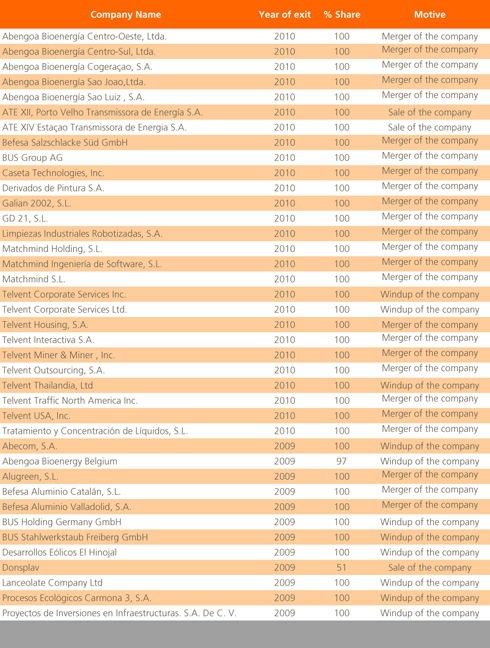
None of these transactions met the qualifying criteria to be classified as discontinued operations.
The aggregated sales and results of 2010 and 2009 of the entities which are no longer consolidated on those years are not significant to the consolidated sales and results.
On October 8, 2010, Abengoa concessoes Brasil Holding, S.A., a subsidiary in the Industrial Engineering and Construction segment, closed a purchase agreement, which has been effective on December 31 once the contractual obligations between the parties have been met, at a price of€117 M, for the remaining 49.9% of the company STE Transmissora de Energia, S.A. held by Control y Montajes Industriales - CYMI, S.A. and for 49.99% of the company NTE Transmissora de Energia, S.A. These companies are the operators of two Transmission Lines concessions in Brazil.
At the end of 2010, the price of the agreement remained outstanding and is shown under the “Trade and other payables” heading in the current liabilities. This acquisition did not have a significant impact on Abengoa’s consolidated financial statements at the 2010 year end, since the companies were already being fully consolidated.
On May 27, 2009, Abengoa S.A., through its subsidiary, Telvent Corporation, executed a sales agreement for the sale of 3,576,470 ordinary shares of the company traded on NASDAQ, Telvent GIT S.A., representing 10.49% of the stock. This represented a cash inflow of €45 million and a gain of €16.5 million in 2009.
In addition to the above, on October 28, 2009, Abengoa, S.A. executed another agreement for the sale of 4,192,374 ordinary shares, representing 12.30 % of the stock of Telvent GIT S.A., amounting to a cash inflow of €74 million and a gain of €39.8 million in 2009.
After conclusion of the two aforementioned sale operations, Abengoa, S.A. held 41.09% of the shares of Telvent GIT, S.A. at the 2009 year end Abengoa, S.A. remains the principal shareholder with full de facto control over said company and fully consolidates it as a result of the framework of the relationship between Abengoa, S.A. and Telvent GIT, S.A. This relationship leads to the conclusion that Abengoa, S.A. has the power to govern Telvent’s financial and operating policies in order to obtain profits from its activities, as stated in IAS 27, and, among the evidence used to reach this conclusion, the following may be highlighted:
- the substantial control over the company’s management and control systems;
- the existence of a resolution of the General Meeting of Shareholders, agreeing on the proposal presented by Abengoa, evidences Abengoa's exercise of its "de facto control" over the Company
- the profile and degree of market activity of the other reference shareholders of Telvent, as well as of the shares transactions of such shareholders;
- the company’s free float, the daily trading volume of its shares and the % interest held by Abengoa.
- the absence of agreements between other shareholders;
- the behaviour of other shareholders in line with that of Abengoa at the General Meeting of Shareholders;
- the composition of the Board of Directors and its voting results.
- the structure of the financing and guarantees that Abengoa provides to the company.
In addition, in June 2009, a company reorganization process took place in the Aluminium business area of the Environmental Services business group. This process consisted of a simplified merger of the companies Befesa Aluminio Bilbao (absorbing company), Befesa Aluminio Valladolid (absorbed), Aluminio Catalán (absorbed) and Alugreen (absorbed). The new company resulting from the merger changed its corporate name to Befesa Aluminio, S.L. but kept the registered office and tax identification code of the absorbing company, Befesa Aluminio Bilbao, S.L.
In compliance with Article 155 of Spanish Corporate Law, the parent company has notified to all these companies, either by itself or through another subsidiary, that it owns more than 10 per 100 of their capital.
b) Associates
Associates are entities over which Abengoa has a significant influence but does not have control and, generally, involve an interest representing between 20% and 50% of the voting rights. Investments in associates are consolidated by the equity method and are initially recognized at cost. The Group’s investment in associates includes goodwill identified upon acquisition (net of any accumulated impairment loss).
The share in losses or gains after the acquisition of associates is recognized in the Income Statement and the share in movements in reserves subsequent to the acquisition is recognized in the reserves. Movements subsequent to the acquisition are adjusted against the carrying value of the investment. When the share in an associate’s losses is equal to or higher than the interest in the company, including any unsecured accounts receivable, additional losses are not recognized unless Abengoa has acquired any obligations or make any payments in the associate’s name.
Results between the Group and its associates are eliminated to the extent of the Group’s holding in the associate. Additionally, unrealized gains are eliminated, unless the transaction provides evidence of impairment to the asset being transferred. The accounting policies of the associates have been changed where necessary to ensure consistency with the policies adopted by the Group.
In compliance with Article 155 of Spanish Corporate Law, the parent company has notified to all these companies, either by itself or through another subsidiary, that it owns more than 10 per 100 of their capital.
Appendices II and VII of these Accounts set out the details of 3 and 7 entities which in 2010 and 2009, respectively, entered in the consolidation and have been consolidated applying the equity method.
The table below sets out those associate companies which ceased to be associates in the consolidation in 2010 and 2009:

On July 27, 2010, Abengoa concessoes Brasil Holding, S.A., a subsidiary in the Industrial Engineering and Construction segment, concluded an agreement with the company State Grid International to sell its 25% shareholding in the companies ETEE (Expansión Transmisora de Energía Eléctrica, S.A.) and ETIM (Expansión Transmissão Itumbiara Marimbondo), which are responsible for the concession of the 794 kilometers of transmission lines that joins the power stations of the city of Itumbiara, in Soiás, and Marimbondo, in the state of Minas Gerais. The sale of these shareholdings meant a cash inflow of €102 M and a profit of €69 M, recognized under the “Other operating income” epigraph in the consolidated income statement (€45 M after income taxes).The impact upon the Group consolidated results of entities leaving the consolidation as associates was not significant in the years 2010 and 2009.
c) Joint ventures
Joint ventures exist when, by virtue of a contractual arrangement, an entity is jointly managed and owned by Abengoa and third parties outside the Group. These arrangements are based upon an agreement between all the parties that confer to those parties joint control over the financial and operating policies of the entity. Holdings in joint ventures are consolidated using the proportionate method.
The Group consolidates the assets, liabilities, income and expenses, and cash flows of the joint ventures on a line-by-line basis with similar lines in the Group’s accounts.
The Group recognizes its share of gains and losses arising from the sale of Group assets to the joint venture for the portion that relates to other investors. Conversely, the Group does not recognize its share in any gains or losses of the joint venture that result from the purchase of assets from the joint venture by a Group company until those assets have been sold to third parties. Any loss on the transaction is recognized immediately if there is evidence of a reduction in the net realizable value of current assets or an impairment loss. Where necessary, the accounting policies of the joint ventures are adapted so as to ensure consistency with those adopted by the Group.
A business combination involving entities or businesses under common control is a business combination in which all entities or businesses that are combined are controlled, ultimately, by the same party or parties, before and after combination takes place, and this control is not transitory.
When the group experienced a business combination under common control, the assets and liabilities acquired are recorded at the same book amount that were registered previously, and they are not valued at fair value. No goodwill related to the transaction is recognised. Any difference between the purchase price and the net book value of net assets acquired is recognized in equity.
Exhibit III and VIII to the Consolidated Financial Statements identifies the 2 and 4 entities which in 2010 and 2009 have been incorporated in the consolidation.
The consolidation of the joint ventures in 2010 and 2009 did not have a significant effect on the overall consolidated figures at December 2010 and 2009.
The amounts set out below represent the Group's percentage interest in the assets, liabilities, revenues and profits of the joint ventures in 2010:
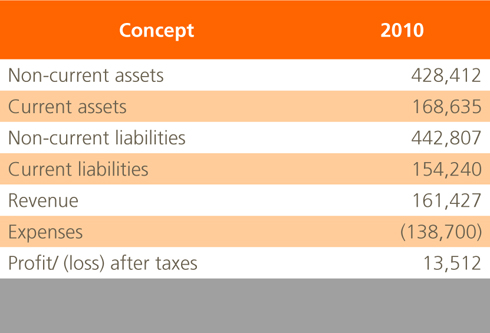
There are no contingent liabilities in relation to the Group’s shareholdings in joint ventures, nor contingent liabilities in the joint ventures themselves.
d) Temporary Joint Ventures
Additionally, the group participates in special joint venture arrangements called “Unión Temporal de Empresas” (UTE) in connection with its share of certain long-term construction and service contracts. UTEs are temporary joint ventures generally formed to execute specific commercial and/or industrial projects in a wide variety of areas and particularly in the fields of engineering and construction and infrastructure projects.
They are normally used to combine the characteristics and qualifications of the UTE’s investors into a single proposal in order to obtain the most favorable technical assessment possible.
UTEs are normally limited as standalone entities with limited action, since, although they may enter into commitments in their own name, such commitments are generally undertaken by their investors, in proportion to each investor’s share in the UTE.
The investors’ shares in the UTE normally depend on their contributions (quantitative or qualitative) to the project, are limited to their own tasks and are intended solely to generate their own specific results. Each investor is responsible for executing its own tasks and does so in its own interests, following specific organizational guidelines that comply with the general guidelines coordinated by all the participants in the project.
Overall project management and coordination does not generally extend beyond execution and preparation or presentation of all the technical and financial information and documentation required to carry out the project as a whole. The fact that one of the UTE’s investors acts as project manager does not affect its position or share in the UTE.
The UTE’s investors are collectively responsible for technical issues, although there are strict pari passu clauses that assign the specific consequences of each investor’s correct or incorrect actions.UTEs are not variable-interest or special-purpose entities. UTEs do not usually own assets or liabilities on a standalone basis. Their activity is conducted for a specific period of time that is normally limited to the execution of the project. The UTE may own certain fixed assets used in carrying out its activity, although in this case they are generally acquired and used jointly by all the UTE’s investors, for a period similar to the project’s duration, or prior agreements are reached by the investors regarding the manner and amounts of the assignment or disposal of the UTE’s assets on completion of the project.
The proportional part of the UTE’s Statement of Financial Position and Income Statement is integrated into the Statement of Financial Position and the Income Statement of the participating company in proportion to its interest in the UTE.
There are no contingent liabilities in relation to the Group’s shareholdings in the UTE, nor contingent liabilities in the UTE themselves.
Funds provided by Group companies to the 123 temporary joint ventures excluded from the consolidation (120 in 2009) were €241 thousand (€275 thousand in 2009) and are included under “Financial Investments” in the Consolidated Statement of Financial Position. The net operating profit of the UTEs accounted for 0.69 % of the Group’s consolidated operating profit (0.32% in 2009). The proportional aggregated net profit was €898 thousand (€650 thousand in 2009).
During 2010, a further 61 UTEs (72 in 2009) which commenced their activity and/or have started to undertake a significant level of activity in 2010 or 2009 were included in the consolidation. These UTEs contributed €167,416 thousand (€64,190 thousand in 2009) to the consolidated net sales.
During 2010 40 UTEs (56 in 2009) were excluded from the consolidated group because they had ceased their activities or the latter had become insignificant in relation to overall group activity levels. The proportional consolidated net sales of these UTEs in 2010 were €2,783 thousand (€19,797 thousand in 2009).
There are no contingent liabilities for the Group’s participation in the UTEs and there are no contingent liabilities of the UTEs themselves.
e) Transactions with non-controlling interests
The group treats transactions with non-controlling interests as transactions with equity owners of the group. When the Group acquires non-controlling interests, the difference between any consideration paid and the carrying value of the proportionate share of net assets acquired is recorded in equity. Gains or losses on disposals of non-controlling interests are also recorded in equity.
When the group ceases to have control or significant influence, any retained interest in the entity is remeasured to its fair value, with the change in carrying amount recognized in profit or loss. The fair value is the initial carrying amount for the purposes of subsequently accounting for the retained interest as an associate, joint venture or financial asset. In addition, any amounts previously recognized in other comprehensive income in respect of that entity are accounted for as if the group had directly disposed of the related assets or liabilities. This may mean that amounts previously recognized in other comprehensive income are reclassified to profit or loss.
2.3. Property, plant and equipment
2.3.1. Presentation
For the purposes of preparing the Financial Statements, property, plant and equipment has been divided into the following categories:
a) Property, plant and equipment.
b) Property, plant and equipment in Projects.a) Property, plant and equipment
This category includes property, plant and equipment of companies or project companies which has been self-financed or financed through external financing with recourse facilities.
b) Property, plant and equipment in Projects
This category includes property, plant and equipment of companies or project companies which is financed through non-recourse project finance (for further details see Notes 2.4 and 6 on Fixed Assets in Projects).
2.3.2. Measurement
In general, items included within property, plant and equipment are measured at historical cost less depreciation and impairment losses, with the exception of land, which is presented at cost less any impairment losses.
The historical cost includes all expenses directly attributable to the acquisition of property, plant and equipment.
Subsequent costs are capitalized in the asset’s carrying amount or are recognized as a separate asset when it is probable that future economic benefits associated with that asset can be separately and reliably identified.
All other repair and maintenance costs are charged to the Income Statement in the period in which they are incurred.
Work carried out by the Group on its own property, plant and equipment is valued at production cost and is shown as ordinary income in the Income Statement of the company which undertook the work.
In those projects in which the asset is constructed internally by the group and that are not under the scope of IFRIC 12 on service concession agreements (see Note 2.24), the entire intragroup income and expenses are eliminated so that the assets are reflected at their acquisition cost.
In addition, such internal construction projects are capitalized as an increase in the carrying amount of the asset, with regard to both financing obtained specifically for each project and non-project-specific financing from financial institutions. The capitalization of borrowing costs ceases at the moment when, as a result of delays or inefficiencies, the process is either stopped or suspended.
Costs incurred during the construction period may also include gains or losses from foreign-currency cash-flow hedging instruments for the acquisition of property, plant and equipment in foreign currency, which have been transferred directly from equity.
With regard to investments in property, plant and equipment located on land belonging to third parties, an initial estimate of the costs of dismantling the asset and restoring the site to its original condition is also included in the carrying amount of the asset. Such costs are recorded at their net present value in accordance with IAS 37.
The annual depreciation rates of property, plant and equipment (including property, plant and equipment in projects) are as follows:
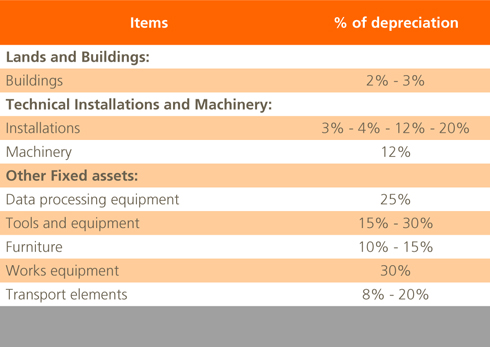
Waste ponds and similar assets are depreciated on the basis of the volume of waste in the ponds.
The assets’ residual values and useful economic lives are reviewed, and adjusted if necessary, at the end of the accounting period of the company which owns the asset.
When the carrying amount of an asset is greater than its recoverable amount, the carrying amount is reduced immediately to reflect the lower recoverable amount.
Gains and losses on the disposal of property, plant and equipment, calculated as proceeds received less the asset’s net carrying amount, are recognized in the Consolidated Income Statement, under the line item Other, within the caption Other operating income.
2.4. Fixed assets in projects
This category includes property, plant and equipment and intangible assets of consolidated companies which are financed through non-recourse Project Finance, that are raised specifically and solely to finance individual projects as detailed in the terms of the loan agreement.
These non-recourse Project Finance assets are generally the result of projects which consist of the design, construction, financing, application and maintenance of large-scale complex operational assets or infrastructures, which are owned by the company or are under concession for a period of time. The projects are initially financed through non-recourse medium-term bridge loans and later by non-recourse Project Finance.
In this respect, the basis of the financing agreement between the Company and the bank lies in the allocation of the cash flows generated by the project to the repayment of the principal amount and interest expenses, excluding or limiting the amount secured by other assets, in such a way that the bank recovers the investment solely through the cash flows generated by the project financed, any other debt being subordinated to the debt arising from the non-recourse financing applied to projects until the non-recourse debt has been fully repaid. For this reason, fixed assets in projects are separately reported on the face of the Consolidated Statement of Financial Position, as is the related non-recourse debt in the liability section of the same statement.
In addition, within the fixed assets in projects line item of the Consolidated Statement of Financial Position, assets are sub-classified under the following two sub-headings, depending upon their nature and their accounting treatment:
- Property, plant and equipment: includes tangible fixed assets which are financed through a non-recourse loan and are not subject to a concession agreement as described below. Their accounting treatment is described in Note 2.3.
- Intangible assets: includes fixed assets financed through non-recourse loans, mainly related to service concession agreements, which are accounted for as intangible assets in accordance with IFRIC 12 (see Note 2.24). The rest of the assets shown under this heading are the intangible assets owned by the project company, the description and accounting treatment of which are set forth in Note 2.5.
Non-recourse project finance typically includes the following guarantees:
- Shares of the project developers are pledged.
- Assignment of collection rights.
- Limitations on the availability of assets relating to the project.
- Compliance with debt coverage ratios.
- Subordination of the payment of interest and dividends to meeting these ratios.
Once the project finance has been repaid and the non-recourse debt and related guarantees fully extinguished, assets reported under this category are reclassified to the Property, Plant and Equipment or Intangible Assets line items, as applicable, in the Consolidated Statement of Financial Position.
2.5. Intangible assets
a) Goodwill
Goodwill is recognized as the excess of the sum of the considerations transferred, the amount of any non-controlling interest in the acquire and the fair value, on the date of acquisition, of the previously held interest in the acquiree over the fair value, at the acquisition date, of the identifiable assets acquired and the liabilities and contingent liabilities assumed. If the sum of the considerations transferred, the amount of any non-controlling interest in the acquiree and previously held interest in the acquiree is lower than the fair value of the net assets acquired and it represents a bargain purchase, the difference is recognized directly in the Income Statement.
Goodwill relating to the acquisition of subsidiaries is included in intangible assets, while goodwill relating to associates is included in investments in associates.
Goodwill is carried at cost less accumulated impairment losses (see Note 2.7). Goodwill is allocated to Cash Generating Units (CGU) for the purposes of impairment testing, these CGU’s being the units which are expected to benefit from the business combination that generated the goodwill.
Gains and losses on disposal of an entity include the carrying amount of goodwill relating to the entity sold.
b) Computer programs
Licenses for computer programs are capitalized on the basis of the original program, comprising purchase costs and preparation/installation cost directly associated with the program. Such costs are amortized over their estimated useful life. Development and maintenance costs are expensed to the Income Statement in the period in which they are incurred.
Costs directly related with the production of identifiable computer programs adapted to the needs of the Group and which are likely to generate economic benefit in excess of their costs for a period of one year are recognized as intangible assets if they fulfill the following conditions:
- It is technically possible to complete the production of intangible asset in such a way that it is available for use or sale;
- Management intends to complete the intangible asset for its use or sale;
- The company is able to use or sell the intangible asset;
- There is availability of appropriate technical, financial or other resources to complete the development and to use or sell the intangible asset; and
- Disbursements attributed to the intangible asset during its development may be reliably measured.
Costs directly related to the production of computer programs recognized as intangible assets are amortized over their estimated useful lives which do not normally exceed 10 years.
Costs that fail to meet the criteria above are recognized as expenses when incurred.
c) Research and development costs
Research costs are recognized as an expense in the period in which they are incurred and they are identified on a project by project basis.
Development costs (relating to the design and testing of new and improved products) are recognized as an intangible asset when all the following criteria are met:
- It is probable that the project will be successful, taking into account its technical and commercial viability, so that the project will be available for its use or sale;
- It is probable that the project will generate future economic benefits, in terms of both external sales or internal use;
- Management intends to complete the project for its use or sale;
- The Company is able to use or sell the intangible asset;
- There is availability of appropriate technical, financial or other resources to complete the development and to use or sell the intangible asset; and
- The costs of the project/product can be estimated reliably.
Once the product is in the market, the capitalized costs are amortized on a straight-line basis over the period for which the product is expected to generate economic benefits, which is normally 5 years, except for development assets related to the thermo-solar plant using tower technology which are amortized over 25 years.
Any other development costs are recognized as an expense in the period in which they are incurred and are not recognized as an asset in later periods.
Grants or subsidized loans obtained to finance research and development projects are recognized in the Income Statement following the rules of capitalization or expensing which have been described above.
d) d) Emission rights of green house gases for own use
This heading recognizes greenhouse gas emissions rights obtained by the Group through allocation by the competent national authority, which are used against the emissions discharged in the course of the Group’s production activities. These emission rights are measured at their cost of acquisition and are derecognized from the Statement of Financial Position when used, under the National Assignation Plan for Greenhouse Gas Permits or when they expire.
Emission rights are tested for impairment to establish whether their acquisition cost is greater than their fair value. If impairment is recognized and, subsequently, the market value of the rights recovers, the impairment loss is reversed through the Income Statement, up to the limit of the original carrying value of the rights.
When emitting greenhouse gases into the atmosphere, the emitting company provides for the tonnage of CO2 emitted at the average purchase price per tonne of rights acquired. Any emissions in excess of the value of the rights purchased in a certain period will give rise to a provision for the cost of the rights at that date.
In the event that the emission right are not for own use but intended to be traded in the market, the contents of Note 2.12 will be applicable.
2.6. Borrowing costs
Borrowing costs incurred in the construction of any qualifying asset are capitalized over the period required to complete and prepare the asset for its intended use (at Abengoa a qualifying asset is defined as an asset for which the production or preparation phase is longer than one year).
Costs incurred relating to non-recourse factoring, when the accounting treatment requires the asset being factored to be derecognized in the Statement of Financial Position, are expensed when the factoring transaction is completed with the financial institution.
Remaining borrowing costs are expensed in the period in which they are incurred.
2.7. Impairment of non-financial assets
On a quarterly basis, Abengoa reviews its property, plant and equipment, intangible assets with finite and indefinite useful life and goodwill to identify any indicators of impairment.
In case any indicator of impairment is identified, Abengoa reviews the asset to determine whether there has been any impairment.
To establish whether there has been any impairment of asset, it is necessary to calculate the asset’s recoverable amount. The recoverable amount is the higher of its market value less costs to sell and the value in use, defined as the present value of the estimated future cash flows to be generated by the asset. In the event that the asset does not generate cash flows independently of other assets, Abengoa calculates the recoverable amount of the Cash-Generating Unit to which the asset belongs. To calculate its value in use, the assumptions include a discount rate, growth rates and projected changes in both selling prices and costs. The discount rate is estimated by the Directors, pre-tax, to reflect both changes in the value of money over time and the risks associated with the specific Cash-Generating Unit. Growth rates and movements in prices and costs are projected based upon internal and industry projections and management experience respectively. Financial projections range between 5 and 10 years depending on the growth potential of each Cash Generating Unit (see Note 4.4.b). The years of financial projections used for the purpose of impairment test for the most significant amounts of goodwill by business unit are disclosed below:
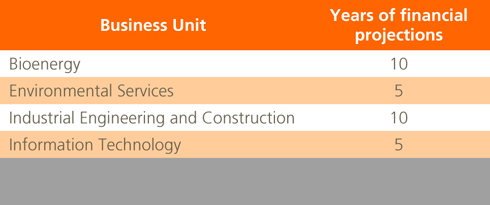
In the event that the recoverable amount of an asset is lower than its carrying amount, an impairment charge for the difference between the recoverable amount and the carrying value of the asset is recorded in the Consolidated Income Statement under the item “Depreciation, amortization and impairment charges”. With the exception of goodwill, impairment losses recognized in prior periods which are later deemed to have been recovered are credited to the same income statement heading.2.8. Financial Investments (current and non-current)
Financial investments are classified into the following categories, based primarily on the purpose for which they were acquired:
a) Financial assets at fair value through profit and loss;
b) Loans and receivables;
c) Financial assets held to maturity; and
d) Financial assets available for sale.
Management determines the classification of each financial asset upon initial recognition, with their classification subsequently being reviewed at each year end.
a) Financial assets at fair value through profit and loss
This category includes the financial assets acquired for trading and those initially designated at fair value through profit and loss. A financial asset is classified in this category if it is acquired mainly for the purpose of sale in the short term or if it is so designated by Management. Financial derivates are also classified as acquired for trading unless they are designated as hedging instruments. The assets of this category are classified as current assets, if they are expected to be realized in less than 12 months after the year-end date of each company. Otherwise, they are classified as non-current assets.
These financial assets are recognized initially at fair value, without including transaction costs. Subsequent changes in fair value of the assets are recognized under “Gains or losses from financial assets at fair value” within the “Finance income or expense” line of the Income Statement for the period.
b) Accounts receivable
Loans and receivables are considered to be non-derivative financial assets with fixed or determinable payments which are not listed on an active market. They are included as current assets except in cases in which they mature more than 12 months after the date of the Statement of Financial Position.
Following the application of IFRIC 12, certain assets under concession can qualify as financial receivables (see Note 2.24).
Loans and receivables are initially recognized at fair value plus transaction costs. Subsequently to their initial recognition, loans and receivables are measured at amortized costs in accordance with the effective interest rate method. Interest calculated using the effective interest rate method is recognized under “Interest income from loans and debts” within the “Other net finance income/expense” line of the Income Statement.
c) Financial assets held to maturity
This category includes those financial assets which are expected to be held to maturity and which and are not derivatives and have fixed or determinable payments.
These assets are initially recognized at fair value plus transaction costs and subsequently at their amortized cost under the effective interest rate method. Interest calculated under the effective interest rate method is recognized under “Other finance income” within the “Other net finance income/expense” line of the Income Statement”.
d) Financial assets available-for-sale
This category includes non-derivative financial assets which do not fall within any of the previously mentioned categories. For Abengoa, they primarily comprise interests in other companies that are not consolidated. They are classified as non-current assets, unless Management anticipates the disposal of such investments within 12 months following the date of the company’s Statement of Financial Position.
Financial assets available for sale are recognized initially at fair value plus transaction costs. Subsequent changes in the fair value of these financial assets are recognized directly in equity, with the exception of translation differences of monetary assets, which are charged to the Income Statement. Dividends from available-for-sale financial assets are recognized under “Other finance income” within the “Other net finance income/expense” line of the Income Statement when the right to receive the dividend is established.
When available-for-sale financial assets are sold or are impaired, the accumulated amount recorded in equity is transferred to the Income Statement. The amount of the cumulative loss that is reclassified from equity to profit or loss in cases when the financial assets are impaired is the difference between the acquisition cost (net of any principal repayment and amortization) and current fair value, less any impairment loss on that financial asset previously recognized in profit or loss To establish whether the assets have been impaired, it is necessary to consider whether the reduction in their fair value is significantly below cost and whether it will be for a prolonged period of time. The accumulated loss is the difference between the acquisition cost and the fair value less any impairment losses. In general, impairment losses recognized in the Income Statement are not later reversed through the Income Statement.
Acquisitions and disposals of financial assets are recognized on the trading date, i.e. the date upon which there is a commitment to purchase or sell the asset. The investments are derecognized when the right to received cash flows from the investment has expired or has been transferred and all the risks and rewards derived from owning the asset have likewise been substantially transferred.
The fair value of listed financial assets is based upon current purchase prices. If the market for a given financial asset is not active (and for assets which are not listed), the fair value is established using valuation techniques such as considering recent free market transactions between interested and knowledgeable parties, in relation to other substantially similar instruments, analyzing discounted cash flows and option price fixing models, using to the greatest extent possible, information available in the market.
At the date of each Statement of Financial Position, the Group evaluates if there is any objective evidence that the value of any financial asset or any group of financial assets has been impaired.
2.9. Derivative financial instruments and hedging activities
Derivatives are initially recognized at fair value on the date that the derivative contract is entered into, and are subsequently measured at fair value. The basis for recognizing the gain or loss from changes in the fair value of the derivative depends upon whether the derivative is designated as a hedging instrument and, if so, the nature of the item being hedged.
The relationship between hedging instruments and hedged items is documented at the beginning of each transaction, as well as its objectives for risk management and strategy for undertaking various hedge transactions.
Both the start of the hedge and subsequently on a continual basis at each closing an effectiveness test is performed on each of the derivative financial instruments designated as a hedge to justify being offset against changes in the fair value or cash flows relating to the hedged items.
The most common methods that have been chosen by the Group to measure the effectiveness of financial instruments designated to be hedges, are the dollar offset and regression methods.
Either of these methods are applied by the Group to perform the following effectiveness tests:
- Prospective effectiveness test: performed at the designation date and at each accounting closing date for the purposes of determining that the hedge relationship continues to be effective and can be designated in the subsequent period.
- Retrospective effectiveness test: performed at each accounting closing date in order to determine the ineffectiveness of the hedge, which must be recognized in the income statement.
At the inception of each transaction, the Group documents the relationship between the hedging instrument and the item being hedged as well as its risk management objectives and the strategy for undertaking the different hedging transactions. The Group also documents its assessment, both at hedge inception and on an ongoing basis, of whether the derivatives that are used in hedging transactions are effective in offsetting changes in the fair value or cash flows of the hedged items.
On this basis there are three types of derivative:
a) Fair value hedge for recognized assets and liabilities
Changes in fair value are recorded in the Income Statement, together with any changes in the fair value of the asset or liability that is being hedged.
b) Cash flow hedge for forecast transactions
The effective portion of a change in the fair value of derivatives is recognized in equity, whilst the gain or loss relating to the ineffective portion is recognized immediately in the consolidated Income Statement.
However, when designating a one-side risk as a hedged risk the intrinsic value and time value of the financial hedge instrument are separated, recording the changes in the intrinsic value on equity, while changes in the time value are recorded in the Consolidated Income Statement. The Group has financial hedge instruments with these characteristics, such as interest rate options (caps), which are described in Note 11.
Amounts accumulated in equity are transferred to the Income Statement in periods in which the hedged item impacts profit and loss. However, when the forecast transaction which is hedged results in the recognition of a non-financial asset or liability, the gains and losses previously deferred in equity are included in the initial measurement of the cost of the asset or liability.
When the hedging instrument matures or is sold, or when it no longer meets the criteria required for hedge accounting, accumulated gains and losses recorded in equity remain as such until the forecast transaction is ultimately recognized in the Income Statement. However, if it becomes unlikely that the forecast transaction will actually take place, the accumulated gains and losses in equity are recognized immediately in the Income Statement.
c) Net investment hedges
Hedges of a net investment in a foreign operation, including the hedging of a monetary item considered part of a net investment, are recognized in a similar way to cash flow hedges:
- The part of the loss or gain of the hedging instrument that is determined to be an effective hedge is directly recognized in equity (see IAS 1), and
- The part that is ineffective is recognized in the Income Statement of the year.
The profit or loss of the hedging instrument in relation to the part of the hedge that is directly recognized in equity is recognized in the Income Statement for the year when the foreign operation is sold or disposed of.
The total fair value of hedging instruments is recorded as a non-current asset or liability when the hedged item is to mature at more than 12 months and as a current asset or liability if less than 12 months. Trading derivatives are classified as a current asset or liability.
Changes in the fair value of derivative instruments which do not qualify for hedge accounting are recognized immediately in the Income Statement.
Contracts held for the purposes of receiving or making payment of non-financial elements in accordance with expected purchases, sales or use of goods (“own-use contracts”) of the Group are not recognized as derivative instruments, but as executory contracts. In the event that such contracts include embedded derivatives, they are recognized separately from the host contract, if the economic characteristics of the embedded derivative are not closely related to the economic characteristics of the host contract. The options contracted for the purchase or sale of non-financial elements which may be cancelled through cash outflows are not considered to be own-use contracts.
2.10. Fair value estimates
The fair value of financial instruments which are traded on active markets (such as officially listed derivatives, investments acquired for trading and available-for-sale instruments) is determined by the market value as at the date of the Statement of Financial Position.
A market is considered active when quoted prices are readily and regularly available from stock markets, financial intermediaries, among others, and these prices reflect current market transactions regularly occur between parties that operate independently.
The fair value of financial instruments which are not listed and do not have a readily available market value is determined by applying various valuation techniques and through assumptions based upon market conditions as of the date of the Statement of Financial Position. For long-term debt, the market prices of similar instruments are applied. For the remaining financial instruments, other techniques are used such as calculating the present value of estimated future cash flows. The fair value of interest rate swaps is calculated as the present value of estimated future cash flows. The fair value of forward exchange rate contracts is measured on the basis of market forward exchange rates as at the date of Statement of Financial Position.
The nominal value of receivables and payables less estimated impairment adjustments is assumed to be similar to their fair value due to their short-term nature. The fair value of financial liabilities is estimated as the present value of contractual future cash outflows, using market interest rate available to the Group for similar financial instruments.
Detailed information on fair values is included in Note 9.2.
2.11. Inventories
Inventories are stated at the lower of cost or net realizable value. In general, cost is determined by using the first-in-first-out (FIFO) method. The cost of finished goods and work in progress includes design costs, raw materials, direct labor, other direct costs and general manufacturing costs (assuming normal operating capacity). Borrowing costs are not included. The net realizable value is the estimated sales value in the normal course of business, less applicable variable selling costs.
Cost of inventories includes the transfer from equity of gains and losses on qualifying cash-flow hedging instruments related with the purchase of raw materials or with foreign exchange contracts.
2.12. Carbon emission credits (CERs)
Several Abengoa entities are involved in a number of external projects to reduce CO2 emissions through participation in Clean Development Mechanisms (CDM) and Joint Implementation (JI) programs with those countries/parties which are purchasing Carbon Emission Credits (CERs) and Emission Reduction Credits (ERUs), respectively. CDMs are projects in countries which are not required to reduce emission levels, whilst JIs are aimed at developing countries which are required to reduce emissions.
Both projects are developed in two phases:
1) Development phase, which, in turn, has the following stages:
Thus, the Group currently holds various agreements for consultancy services within the framework of the execution of Clean Development Mechanisms (CDM). Costs incurred in connection with such consultancy services are recognized by the Group as non-current receivables.
2) Phase of annual verification of the reductions in CO2 emissions. After this verification, the company receives Carbon Emission Credits (CERs), which are registered in the National Register of Emission Rights. CERs are recorded as inventories and measured at market value.
Likewise, the company may hold Emission Allowances assigned by the competent EU Emission Allowance Authority (EUAs), which may also be measured at market price if held for sale. In the event that the EUA are held for own use (see Note 2.5.b).
Furthermore, there are carbon fund holdings aimed at financing the acquisition of emissions from projects which contribute to a reduction in greenhouse gas emissions in developing countries through CDM’s and JA’s, as discussed above. Certain Abengoa companies have holdings in such carbon reduction funds which are managed by an external Fund Management team. The Fund directs the resources of the funds to purchasing Emission Reductions through MDL and AC projects.
The company with holdings in the fund incurs a number costs (ownership commissions, prepayments and purchases of CER’s). From the start, the holding is recorded [on the balance sheet based upon the original Carbon Emission Credit (CER) allocation agreement; however this amount will be allocated over the life of the fund. The price of the CER is fixed for each ERPA. Based upon its percentage holding, and on the fixed Price of the CER, it receives a number of CER’s as obtained by the Fund from each project.
These contributions are considered as long-term investments and are recognized in the Consolidated Financial Statement under the heading of Other Financial Investments.
2.13. Biological assets
Abengoa recognizes sugar cane in production as biological assets. The production period of sugar cane covers the period from preparation of the land and sowing the seedlings until the plant is ready for first production and harvesting. Biological assets are classified as property, plant and equipment in the Statement of financial position. Biological assets are recognized at fair value, calculated as the market value less estimated harvesting and transport costs.
Agricultural products harvested from biological assets, which in the case of Abengoa are cut sugar cane, are classified as inventories and measured at fair value less estimated sale costs at the point of sale or harvesting.
The reference used for the market value of biological assets and agricultural products is typically the projected cane crop price in April, provided on a monthly basis by the Cane, Sugar and Alcohol Producers Board (Consecana).
Gains or losses arising as a result of changes in the fair value of such assets are recognized in the Consolidated Income Statement.
To obtain the fair value of the sugar cane while growing, a number of assumptions and estimates have been made in relation to the area of land sown, the estimated TRS (Total Recoverable Sugar contained within the cane) per tonne to be harvested and the average degree of growth of the agricultural product in the different areas sown.
In the opinion of the parent company Directors, the fair value of the assets recognized does not differ significantly from their cost.
2.14. Trade and other receivables
Trade accounts receivable relate to amounts due from customers for sales of goods and services rendered in the normal course of operation. These items are included under current assets, unless maturing in more than 12 months after the balance sheet date, in which case the items are recorded under non-current assets.
Trade receivables are recognized initially at fair value and are subsequently measured at amortized cost using the effective interest rate method, less provision for impairment. Trade receivables falling due in less than one year are carried at their face value at both initial recognition and subsequent measurement, provided that the effect of not discounting flows is not significant.
A provision for impairment of trade receivables is recorded when there is objective evidence that the Group will not be able to recover all amounts due as per the original terms of the receivables.
The existence of significant financial difficulties, the probability that the debtor is in bankruptcy or financial reorganization and the lack or delay in payments are considered evidence that the receivable is impaired.
The amount of the provision is the difference between the asset’s carrying amount and the present value of estimated future cash flows discounted at the effective interest rate.
When a trade receivable is uncollectable, it is written off against the bad debt provision. Subsequent recovery of trade receivables which were previously written off is credited against “Other operating expenses” in the Income Statement.
Trade debtors and other accounts receivable which have been factored with financial entities are only removed from the Company’s accounting records and excluded from assets on the consolidated statement of financial condition if all risks and rewards of ownership of the related financial assets have been transferred, comparing the Company’s exposure, before and after the transfer, to the variability in the amounts and the calendar of net cash flows from the transferred asset. Once the Company’s exposure to this variability has been eliminated or substantially reduced, the financial asset has been transferred, and is derecognized from the consolidated statement of financial condition (See Note 9.1.b).
2.15. Cash and cash equivalents
Cash and cash equivalents include cash in hand, cash in bank and other highly-liquid current investments with an original term of three months or less.
In the Statement of Financial Position, bank overdrafts are classified as borrowings within current liabilities.
2.16. Share capital
Parent company shares are classified as equity.
Transaction costs directly attributable to new shares are presented in equity as a reduction, net of taxes, to the consideration received from the issue. Any amounts received from the sale of treasury shares, net of transaction costs, are classified in equity.
2.17. Government grants
Non-refundable capital grants are recognized at fair value when it is considered that there is a reasonable assurance that the grant will be received and that the necessary qualifying conditions, as agreed with the entity assigning the grant, will be adequately complied with.
Grants related to income are deferred in the Statement of Financial Position and are recognized in the Income Statement based on the period necessary to match them with the costs they intend to compensate.
Grants related to fixed assets are recorded as non-current liabilities in the Consolidated Statement of Financial Position and are recognized in the Consolidated Income Statement on a straight-line basis over the estimated useful economic life of the assets.
2.18. Loans and borrowings
External resources are classified in the following categories:
a) Non-recourse financing applied to projects (see note 15);
b) Corporate financing (see Note 16);
Loans and borrowings are initially recognized at fair value, net of transaction costs incurred. Borrowings are subsequently measured at amortized cost and any difference between the proceeds initially received (net of transaction costs incurred in obtaining such proceeds) and the repayment value is recognized in the Income Statement over the duration of the borrowing using the effective interest rate method.
Interest-free loans mainly granted for research and development projects are initially recognized at fair value. The difference between the cash-flow received and the fair value of the loan for development projects capitalized is recorded within “Grants and Other Liabilities” in the consolidated statement of financial position, allocating it to the income statement according to the useful life of the asset. The difference between the cash received and the fair value of the loan used as subsidies for research costs is recognized as income under “Grants” within the “Other operating income” in the Consolidated Income Statement when the costs are incurred. Where the loan is received before the costs are incurred, the difference is recognized as “Grants and other liabilities” of the Consolidated Statement of Financial Situation.
Commissions paid for obtaining credit lines are recognized as transaction costs if it is probable that part or all of the credit line will be drawn down. If this is the case, commissions are deferred until the credit line is drawn down. If it is not probable that all or part of the credit line will be drawn down, commission costs are recorded as an advance payment for liquidity services and amortized over the period for which the credit line is available to the Group.
Loans and borrowings are classified as current liabilities unless an unconditional right exists to defer their repayment by at least 12 months following the date of the Statement of Financial Position.
2.18.1. Convertible bonds
On July 24, 2009, Abengoa S.A. issues a convertible bond for the amount of €200 million, maturing at five (5) years, among qualified and institutional buyers.
On February 3, 2010, Abengoa, S.A. issued a convertible bond for the amount of €250 M, maturing at seven (7) years, among qualified and institutional investors.
On April 19, 2010, Telvent GIT, S.A., the primary company of the Information Technologies Business Group, issued a convertible bond for the amount of US$200 M, maturing at five (5) years, among qualified and institutional buyers.
Pursuant to the Terms and Conditions, when the investors exercise their conversion right, the issuer may decide whether to deliver shares of the company or a combination of cash for the nominal value and shares for the difference (for more information on convertible bonds, see Note 16.3).
In accordance with IAS 32 and 39 and the Terms and Conditions of the issue, since the bond grants the parties the right to choose the form of settlement, the instrument represents a financial liability. Because of Abengoa’s contractual right to choose the type of payment and the possibility of paying through a variable number of shares, the conversion option qualify as an embedded derivative. Thus, the convertible bond is considered a hybrid instrument, which includes a component of liability for financial debt and an embedded derivative for the conversion option held by the bondholder.
For convertible bonds that qualify as hybrid instruments, the Company initially measures the embedded derivative at fair value and classifies it under the derivative financial instruments liability heading. At the end of each period, the embedded derivative is re-measured and changes in fair value are recognized under “Other financial income or expense” within the “Financial income or expense” line of the Consolidated Income Statement.”The financial liability component of the bond is initially calculated as the difference between the nominal value received for the bonds and the fair value of the aforementioned embedded derivative. Subsequently, the financial liability component is measured at amortized cost until it is settled upon conversion or maturity. In general, transaction costs are recognized as a deduction in the value of the debt in the Statement of Financial Position and included as part of its amortized cost.
2.18.2. Ordinary bonds
On December 1, 2009, Abengoa S.A. completed the issue of a bond for €300 million, maturing at five (5) years, among qualified and institutional buyers.
On March 31, 2010, Abengoa, S.A. issued an ordinary bond for the amount of €500 thousand, maturing at six (6) years, among qualified and institutional buyers.
On October 19, 2010, Abengoa Finance, S.A. Unipersonal, a subsidiary of Abengoa, S.A., issued an ordinary bond for the amount of US$650 M, with maturity at seven (7) years, among qualified and institutional buyers.
The company initially recognizes the financial debt at its fair value, net of transaction costs incurred. Subsequently, the bond is measured at amortized cost until settlement upon maturity. Any other difference between the proceeds obtained (net of transaction costs) and the redemption value is recognized in the Income Statement over the term of the debt using the effective interest rate method. Ordinary bonds are classified as non-current liabilities unless they mature during the 12 months following the date of the Statement of Financial Position.
2.19. Current and deferred income taxes
Income tax expense for the period comprises current and deferred taxes. Income tax is recognized in the Income Statement, except to the extent that it relates to items recognized directly in equity. In these cases, income tax is also recognized directly in equity.
Current income tax charge is calculated on the basis of the tax laws in force or about to enter into force as of the date of the Statement of Financial Position in the countries in which the subsidiaries and associates operate and generate taxable income.
Deferred income tax is calculated in accordance with the Statement of Financial Position liability method, based upon the temporary differences arising between the carrying amount of assets and liabilities and their tax base. However, deferred income tax is not recognized if it arises from initial recognition of an asset or liability in a transaction other than a business combination that, at the time of the transaction, affects neither the accounting nor the taxable profit or loss. Deferred income tax is determined using tax rates and regulations which are enacted or substantially enacted at the date of the Statement of Financial Position and are expected to apply and/or be in force at the time when the deferred income tax asset is realized or the deferred income tax liability is settled.
Deferred income tax assets are recognized only to the extent that it is probable that future taxable profit will be available against which the temporary differences can be utilised.
Deferred income tax is recognized on temporary differences arising on investments in subsidiaries and associates, except where the timing of the reversal of the temporary differences is controlled by the Group and it is not probable that they will reverse in the foreseeable future.
All Spanish companies (with the exception of companies registered and domiciled in the Basque Country) applied a corporate tax rate of 30% in 2010 and 2009. Those domiciled in the Basque Country are subject to a corporate tax rate of 28% in 2010 and 2009.
2.20. Employee benefits
a) Share plans
Certain Group companies have obligations in connection with certain share-based incentive plans for managers and employees. These plans are linked to the attainment of certain management objectives for the following years. When there is no active market for the shares granted by the plan, personnel expense is recognized on the basis of the repurchase price identified in the plan during the vesting period. When the shares have a market value, personnel expense is recognized during the vesting period based on their fair value at grant date. In either case, the impact of these share plans on Abengoa’s Annual Financial Statements is not significant.
On February 2, 2006, Abengoa granted a Share Acquisition Plan, or Plan, which was approved by the Board of Directors of Abengoa on January 23, 2006. The Plan, which is available on the same terms to all participants, is available to members of the senior management of Abengoa and its subsidiaries. Under the Plan, participants were entitled to purchase up to 3,200,000 shares of Abengoa.
The material terms of the Plan are as follows:
1. Participants: 122 members of the senior management of the Abengoa Group (business group managers, business unit managers, technical and research and development officers and corporate services officers) from all its subsidiaries and business areas are eligible to participate in the Plan if they desire to do so. The Plan is not open to any member of Abengoa’s Board of Directors.
2. Shares Available for Purchase: Up to 3,200,000 Abengoa shares (the “shares”), which represent 3.53% of the equity of Abengoa. The Shares purchased by Plan participants were already issued and in circulation and were purchased on the open market, at the then current market price, over a period that extended to December 31, 2006, in accordance with the Stock Exchange Act (Spain). A total of 3,166,000 were purchased under the Plan. As such, these shares are not dilutive instruments for earnings per share calculation purposes. At year end 2010, the number of shares covered by the plan amounted to 2,764,360 shares.
3. Financing: As an incidental feature of the Plan, each participant utilized the proceeds of an individual bank loan from Banco Sabadell, S.A. or Caja Madrid (collectively the “Bank”) to finance the purchase of shares of Abengoa under the Plan. The same standard loan terms apply to all participants. The interest rate on the loans is a variable rate equal to EURIBOR plus 0.75%. These are bullet and not amortizing loans. The loans must be repaid by the participants by August 7, 2011. Each loan is secured by a pledge of 100% of the participant’s Shares and is guaranteed by the Company to the extent set forth under paragraph 8 below. Except for the pledge of the Shares, the loan is not considered a non-recourse financing to the participant. The maximum amount of indebtedness related to all such loans is 87 million euros (including expenses, commissions and interests). As of December 31, 2010 and 2009, the amounts drawn by total participants under these loans amounted to € 64 million and €63 million respectively
4. Share Purchase: The acquisition cost for all participants has been the average acquisition price, plus associated commissions and other costs, for all of the Shares purchased under the Plan for all participants.
5. Term and Vesting Period: The duration and vesting period of the Plan is five complete financial years (2006-2010) plus six months (until June 30, 2011) (the requisite service period). The Plan requires the annual accomplishment by the participant of annual management objectives, including specific financial targets and qualitative objectives, set by the management of the Abengoa Group company by which the participant is employed, as well as their continuation as a Group employee through June 30, 2011. If the annual objectives are not met by the participant, the Bank from which the participant borrowed the funds to purchase his/her Shares may sell a percentage of the Shares purchased for such participant as follows: 2006-30%, 2007-30%, 2008-15%, 2009-15%, 2010-10%
6. Restrictions on Sales: A participant may not transfer, sell, borrow against or otherwise dispose of the Shares purchased before July 1, 2011.
7. Repurchase Option: Under the Plan, Abengoa has a repurchase option under which Abengoa can require a participant to sell the Shares back to the Company on the occurrence of certain events, such as death, disability or retirement of the participant or termination of the employment of the participant with the Abengoa Group Company.
8. Shortfall on Sale of Shares: At the end of the five years and six months term of the Plan, if the amount realized on a sale of the Shares does not entirely cover the amount owed under the loan and costs and taxes on capital gains, Abengoa will compensate the participant with the necessary amount to repay the loan plus accrued and unpaid interest and pay such taxes.
Based on the specific conditions of the plan set forth above, the plan is considered a cash-settled share-based payment plan in accordance with IFRS 2, since the company compensates the participants for their services in exchange for the assumption of the market risk on the shares. By use of the guarantee on the loan, Abengoa guarantees participants, up to the end of the plan period, no personal losses in conjunction with a change in the price of the shares purchased. As such, Abengoa measures and recognizes at the end of each reporting period, a liability based on the value of the shares. Upon expiration of the Plan, the employee may sell the shares to repay the individual loan or may otherwise repay the loan as they wish.
Compensation expense is recognized over the requisite service period (the vesting period), and is determined by reference to the reasonable value of a hypothetical put option granted by the company to the participant, excluding the effect of vesting conditions that are not market conditions. For these purposes, the calculation takes into account the number of shares that are expected to become exercisable (or vested), which is updated at each year end, recognizing the impact of the revision of the original estimates, if applicable, in the Consolidated Income Statement.
The fair value of the hypothetical options granted during the year 2010, calculated using the Black-Scholes model was €20,832 thousand in 2010 and €20,635 thousand in 2009, recording a loss during the year 2010 of €2,261 thousand (income of €11,450 thousand in 2009) The key data required for the valuation model were share price, the estimated return per dividend, an expected option life of 5 years, an annual interest rate and share market volatility that are included in the table below:
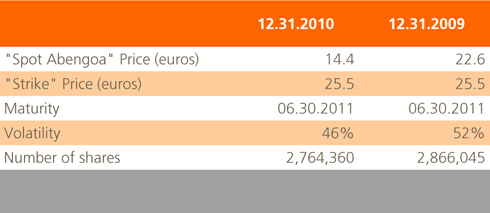
b) Bonus schemes
On July 24, 2006 and December 11, 2006, the Board of Directors approved an Extraordinary Variable Remuneration Plan for Managers (Plan Two) at the proposal of the Remuneration Committee. This plan includes 190 beneficiaries and has a total cost of €51,630 thousand over a five-year period from 2007 to 2011, inclusive. It requires that objectives set forth in the Strategic Plan be attained at an individual level as well as the individual’s continued ongoing service throughout the period in question.
In addition to the aforementioned, given that the acquisition of the company B.U.S. Group AB was completed only shortly after implementation of the Plan, on October 22, 2007 the Board of Directors approved the inclusion of the management team of such company, formed by 10 people, in the Plan under the same conditions as those established for the rest of the beneficiaries, for a total amount of €2,520 thousand.
In connection with such variable remuneration plan the Group recognizes a personnel expense in the Income Statement for the amounts annually accrued in accordance with the percentage of compliance with the plan’s established objectives. The cost recognized in 2010 was €16,175 thousand (€ 8,087 thousand in 2009), the accumulated cost being €37,741 thousand (€21,566 thousand in 2009).
2.21. Provisions
Provisions are recognized when:
When there are a number of similar obligations, the likelihood that a cash outflow will be required in settlement is determined by considering the type of obligations as a whole. The provision is recognized even if the likelihood of an outflow with respect to certain items included within the same class is low.
Provisions are measured at the present value of the expected expenditure required to settle the obligation, recognizing any increases in the provision over time as an interest expense.
Contingent liabilities reflect possible obligations to third parties and known obligations which are not recognized due to the low probability of a future outflow of economic resources being required to settle the obligation or, if applicable, because the possible future value of the settlement cannot be reliably estimated. Such contingencies are not recognized in the Statement of Financial Position unless they have been acquired in a business combination. The balance of Provisions disclosed in the Notes reflects management’s best estimate of the potential exposure as of the date of preparation of the Consolidated Financial Statements.
2.22. Trade and other payables
Trade and other payables are payment obligations arising from the purchase of goods or services from suppliers in the ordinary course of business and are recognized initially at fair value and are subsequently measured at their amortized cost using the effective interest method.
Other receivables are payment obligations not arising from the purchase of goods or services and that are not treated as debt financing transactions. These accounts are classified as current liabilities if payment falls due within one year. Otherwise they are presented as non-current liabilities.
Advances received from customers are recognized as liabilities within “Other liabilities”.
2.23. Foreign currency transactions
a) Functional currency
The components of the financial statements of each of the companies within the Group are measured and reported in the currency of the principal economic environment in which the company operates (the functional currency). The consolidated annual accounts are presented in euro, which is Abengoa’s functional and presentation currency.
b) Transactions and balances
Transactions denominated in foreign currency are translated into the functional currency applying the exchange rates in force at the time of the transactions. Foreign currency gains and losses that result from the settlement of these transactions and the translation of monetary assets and liabilities denominated in foreign currency at the year-end rates are recognized in the Income Statement, unless they are deferred in equity, as occurs with cash-flow hedges and net investment in foreign operations hedges.
c) Translation of the financial statements of foreign companies within the Group
The Income Statements and Statements of Financial Position of all Group companies with a functional currency other than the presentation currency (Euro) are translated into the presentation currency as follows:
1) All assets, rights and obligations are translated to the presentation currency using the exchange rate in force at the closing date of the Financial Statements.
2) The items on the Income Statement of each foreign company are translated into the presentation currency using the average annual exchange rate, which is calculated as the arithmetical average of the exchange rates in force at the end of each of the twelve months of the year that does not differ significantly from the day of transaction exchange rate.
3) The difference between equity, including the profit or loss calculated in accordance with the preceding point and translated at the historical exchange rate, and the net financial position that results from translating the assets, rights and obligations in accordance with point 1) above, is recorded as a positive or negative difference, as applicable, recorded in equity in the Consolidated Statement of Financial Position under the heading “Translation differences”.
The results of companies consolidated by the equity method are, if applicable, translated at the average rate for the year, calculated as in point 2) above.
Adjustments to the goodwill and the fair value that arise on the acquisition of a foreign company are treated as assets and liabilities of the foreign company and are translated at the year-end exchange rate.
2.24. Service concession agreements
As indicated in Note 2.4, Service concession agreements are recorded in accordance with the provisions of
IFRIC 12.Service Concession Agreements are public-to-private arrangements in which the public sector controls or regulates the service provided with the infrastructure and their prices, and it is contractually guaranteed to gain, at a future time, ownership of the infrastructure through which the service is provided. The infrastructuresaccounted for by the Group as concessions are mainly related to the activities concerning power transmission lines, desalinization plants and certain thermo-solar electricity generation plants. The infrastructure used in a concession can be classified as a financial asset or an intangible asset, depending on the nature of the payment entitlements established in the agreement.
The Group recognizes an intangible asset to the extent that it has a right to charge final customers for the use of the infrastructure. This intangible asset is subject to the provisions of IAS 38 and is amortisable, taking into account the estimated period of commercial operation of infrastructure. The Group recognizes and measures revenue, costs and margin for providing construction services during the period of construction of the infrastructure in accordance with IAS 11, “Construction Contracts”and revenue for other services in accordance with IAS 18, “Revenue”.
Service Concession Agreements are accounted for in accordance with the following criteria:
1) Total construction costs, including associated financing costs, are registered as intangible assets. Profits attributable to the construction phase of the infrastructure are recognized using the percentage of completion method, based on the fair value assigned to the construction phase and the concession phase.
2) The intangible asset is usually amortized on a straight-line basis over the period of the concession.
3) The amounts recognized in the Income Statement during the period of the concession are as follows:
- Ordinary income: The annual updated concession fee income is recognized in each period.
- Operating costs: operating and maintenance costs and general overheads and administrative costs are charged to the Income Statement in accordance with the nature of the cost incurred (amount due) in each period. Fixed assets are amortized as per point 2) above.
- Financial costs: financing costs and exchange rate differences arising from repayable debt denominated in foreign currencies are charged to the income statement.
4) At the end of each period, each project is tested for impairment if the invested costs are considered not recoverable.
In those concession agreements where the grantor of the concession is responsible for the payment of the operator’s expenses and retains substantially all the legal risks associated with the concession, the asset arising from the construction phase of the project is reported as a non-current receivable within the line item Loans (non-current portion) under the non-current Financial accounts receivable caption of the Consolidated Statement of Financial Position, provided that it is possible to calculate the amount. The non-current receivable is measured at amortized cost in accordance with the effective interest rate method and gradually reduced during the term of the contract against the annual fees received (see also note 2.25 c). Interest calculated using the effective interest rate method is recognized within the line item “Interest income from loans and debt”, under the “Finance income” caption of the Consolidated Income Statement.
2.25. Revenue recognition
a) Ordinary income
Ordinary income comprises the fair value of sales of goods or services, excluding VAT or similar taxes, any discounts or returns and excluding sales between Group entities.
Ordinary income is recognized as follows:
- Income from the sale of goods is recognized when the Group delivers the goods to the client, the client accepts them and it is reasonably certain that the related receivables will be collectible.
- Income from the sale of services is recognized in the period in which the service is provided, using the percentage of completion method based on the specific contractual terms and conditons of each service agreement, when the revenue of the service contract and the associated costs, as well as the percentage of completion can be estimated reliably and when it is reasonable certain that the related receivables will be collectible. When one or more of such elements of the service contract cannot be estimated reliably, ordinary income from the sale of service is recognized only to the extent of the expenses recognized that are recoverable
- Interest income is recognized using the effective interest rate method. When a receivable is considered impaired, the carrying amount is reduced to its recoverable amount, discounting the estimated future cash flows at the original effective interest rate of the instrument and recording the discount as a reduction in interest income. Income from interest on loans that have been impaired is recognized when the cash is collected or on the basis of the recovery of the cost when the conditions are guaranteed.
- Dividend income is recognized when the right to receive payment is established.
b) Construction contracts
Costs incurred in relation to construction contracts are recognized when incurred. When the outcome of a construction contract cannot be reliably estimated, revenues are only recognized up to the amount of the costs incurred to date that are likely to be recovered.
When the outcome of a construction contract can be reliably estimated and it is probable that it will be profitable, revenue from the contract is recognized over the term of the contract. When it is probable that the costs of the project will be greater than its revenue, expected loss is recognized immediately as an expense. To determine the appropriate amount of revenue to be recognized in any period, the percentage of completion method is applied. The percentage of completion method considers, at the date of the Statement of Financial Situation, the actual costs incurred as a percentage of total estimated costs for the entire contract. Costs incurred in the period which relate to future project activities are not included when determining the percentage of completion. Prepayments and certain other assets are recognized as inventories, depending upon their specific nature.
Partial billing that has not yet been settled by the clients and withholdings are included under the trade and other receivables heading.
Gross amounts owed by clients for ongoing works in which the costs incurred plus recognized profits (minus recognized losses) exceed partial billing are presented as assets under the heading of “Clients, executed projects pending certification”.
On the other hand, amounts outstanding from customers for work in progress for which the billing to date is greater than the costs incurred plus recognized profits (less recognized losses) are shown as liabilities within the line item “Down payments from clients” in the Trade payables and other current liabilities caption of the Consolidated Statement of Financial Position.
Lastly, as stated in point 2.3.2 on the measurement of property, plant and equipment in internal asset construction projects outside the scope of IFRIC 12 on Service Concession Arrangements (see Note 2.24), the totality of the revenues and profits between group companies is eliminated, meaning that said assets are shown at their acquisition cost.
c) Concession contracts
Concession contracts are public-private agreements for periods usually between 20 and 30 years including both the construction of infrastructure and future services associated with the operation and maintenance of assets in the concession period.
Revenues are obtained during the concession period via an annual charge payable by the grantor of the concession, which, in certain cases, is adjusted for inflation (see note 2.24 for revenue recognition). Typically the annual charge is updated based upon the official pricing index of the country and in the currency in which the fee is denominated and the fluctuations in local currency against a currency basket.
2.26. Leases
Lease contracts of fixed assets in which a Group company is the lessee and substantially retains all the risks and rewards associated to the ownership of the assets are classified as finance leases.
Finance leases are recognized at inception of the lease for the lower of the fair value of the leased asset and the present value of the minimum lease payments over the contract term. Each lease payment is distributed between debt and financing costs, in a way which establishes a constant interest rate on the outstanding debt. The amounts to be paid over the lease term, net of financing costs, are recognized as non-current and current payables, as appropriate. The interest portion of the financing costs is charged to the Income Statement over the period of the lease agreement, in order to obtain a constant periodic interest rate on the balance of the outstanding debt in each period. Assets acquired under finance lease agreements are depreciated over the shorter of the useful life of the asset and the lease term.
Lease agreements undertaken by the Group in which the entity entering into the agreement does not substantially retain all the risks and rewards associated with the ownership of the asset are classified as operating leases. Payments made under operating leases are charged to the Income Statement (net of any incentives received from the lessor) on a straight-line basis over the lease term.
2.27. Dividend distribution
Dividends paid to the shareholders of the parent company of the Group are recognized as a liability in the period in which the dividend payment is approved by the shareholders of the company distributing the dividend.
2.28. Segment reporting
Information on the Group’s operating segments is presented in accordance with the internal information provided to the Group’s Chief Operating Decision Maker (CODM). The CODM, responsible for assigning resources and evaluating the performance of the operating segments, has been identified as the Strategy Committee, formed by the Executive Chairman, the Executive Deputy Chairman, the Chief Executive Officer, the Business Group managers, the Organization, Quality and Budgets Manager, the Technical Secretary, the Human Resources Manager, the Corporate Strategy and Development Manager, the Finance Manager, the Investor Relations Manager, the International Institutional Relations Manager, the General Secretary of Sustainability and the General Secretary.
The Strategy Committee analyses the business on a product and geographical basis. The Group is divided in 5 strategic business units: Solar, Bioenergy, Information Technologies, Environmental Services and Industrial Engineering and Construction.
Geographically, the 5 regions which are reported to the CODM are Spain (local market), USA and Canada, the European Union, Central and South America and Other (the remaining overseas markets).
As stated in Note 1.2, during the third quarter of 2010 Abengoa’s management decided to start presenting financial information based on three business activities, in addition to the financial information presented by the 5 reporting segments. The financial information by these three business activities is the one that best represents, in management’s view, Abengoa’s current business environment, due to the continuous evolution of the Group. During 2011, it is expected that such financial information based on the three business activities will represent the discrete financial information which will be reviewed by the Chief Operating Decision Maker to make decisions about the allocation of resources to those business activities and to assess their performance.
Therefore, although the segment information presented in Note 40 includes financial information based on Abengoa’s five business segments, in order to facilitate disclosures of the make the Group’s financial measures with those utilized by the CODM, additional information has been provided in relation to these three business activities.
For detailed information on the business and geographical segments, see Note 40.
2.29. Environmental assets
Equipment, installations and systems used to eliminate, reduce or control possible environmental impacts are recognized applying analogous criteria to those applied to other similar assets.
The provisions made for environmental restoration, costs of restructuring and litigations are recognized when the company has a legal or constructive obligation as a result of past events and it becomes probable that an outflow of resources will be necessary to settle the obligation and the amount can be reliably estimated.
Note 41.6 gives additional information on the Group’s environmental policies.
2.30. Severance payments
Severance payments are made to employees in the event that the company terminates their employment contract prior to the normal retirement age or when the employee voluntarily accepts redundancy in the terms offered by the employer. The Group recognizes severance payments when it is demonstrably committed to third parties to provide indemnities for leaving the company or to dismiss the current workers in accordance with a detailed formal plan, with no possibility of retracting.
2.31. Non-current Assets held for sale and discontinued operations
The Group classifies property, plant and equipment, intangible assets and disposal groups (groups of assets that are to be sold together with their directly associated liabilities) as non-current assets held for sale when, at the date of the Consolidated Statement of Financial Position, an active programme to sell them has been initiated by Management and the sale is foreseen to take place within the following twelve months.
The Group considers discontinued operations those business lines which have been sold or otherwise disposed of or those that meet the conditions to be classified as held-for-sale. Discontinued operations also include those assets which are included in the same sale programme together with the business line. Entities which are acquired exclusively with a view for resale are also classified as discontinued operations.
Assets held for sale or disposal groups are measured at the lower of their carrying value or fair value less estimated costs necessary to sell them. They are no longer amortized or depreciated as from the moment they are classified as non-current assets held for sale.
Non-current assets held for sale and the components of disposal groups are presented in the Statement of Financial Position as follows: assets are included under a single heading called “Assets held for sale and discontinued operations” and liabilities are also included under a single heading called “Liabilities held for sale and discontinued operations”.
The after-tax profit or loss on discontinued operations is presented in a single line within the Consolidated Income Statement under the heading “Profit or loss for the year from discontinued operations, net of tax”.
- Improvements to IFRSs published in April 2009 by the IASB, adapted by UE in March 2010. The improvements published munder the IASB’s annual improvement process are intended to deal with non-urgent and minor amendments to the existing standards. These improvements affect IFRSs 2, 5 and 8; IASs 1, 7, 17, 18, 36, 38 y 39; and IFRIC 9 and 16. These improvements are mandatory as from January 1, 2010, except amendments to IFRS 2 and IAS 38 that apply to periods starting as from July 1, 2009. These amendments did not have a significant impact on the Group’s financial statements.
- Revised IAS 24 (revised), ‘Related party disclosures’, issued in November 2009. It supersedes IAS 24, ‘Related party disclosures’, issued in 2003. IAS 24 (revised) is mandatory for periods beginning on or after January 1, 2011. The revised standard clarifies and simplifies the definition of a related party and removes the requirement for government-related entities to disclose details of all transactions with the government and other government-related entities. The group will apply the revised standard from January 1, 2011. When the revised standard is applied, the group and the parent will need to disclose any transactions between its subsidiaries and its associates. The group is currently putting systems in place to capture the necessary information. It is, therefore, not possible at this stage to disclose the impact, if any, of the revised standard on the related party disclosures
- ‘Classification of rights issues’ (amendment to IAS 32). The amendment applies to annual periods beginning on or after February 1, 2010. Earlier application is permitted. The amendment addresses the accounting for rights issues that are denominated in a currency other than the functional currency of the issuer. Provided certain conditions are met, such rights issues are now classified as equity regardless of the currency in which the exercise price is denominated. Previously, these issues had to be accounted for as derivative liabilities. The amendment applies retrospectively in accordance with IAS 8 ‘Accounting policies, changes in accounting estimates and errors’. The group will apply the amended standard from January 1, 2011.
- Amendments to IFRS 1, “Limited Exemption from Comparative IFRS 7 Disclosures for First-time Adopters”. This amendment is mandatory as from January 1, 2011.This amendment provides support for fisrts-time adopoters in the transition, as received when amendment in IFRS 7 “Financial Instruments: Disclosures” took place. That amendment required further disclosures of valuation at fair value and liquidity risk, and it was not mandatory to present comparative information. The group will apply the amended standard from January 1, 2011.
- ‘Prepayments of a minimum funding requirement’ (amendments to IFRIC 14). The amendments correct an unintended consequence of IFRIC 14, ‘IAS 19 – The limit on a defined benefit asset, minimum funding requirements and their interaction’. Without the amendments, entities are not permitted to recognise as an asset some voluntary prepayments for minimum funding contributions. This was not intended when IFRIC 14 was issued, and the amendments correct this. The amendments are effective for annual periods beginning January 1, 2011. Earlier application is permitted. The amendments should be applied retrospectively to the earliest comparative period presented. The group will apply these amendments for the financial reporting period commencing on January 1, 2011.
- IFRIC 19, ‘Extinguishing financial liabilities with equity instruments’, effective July 1, 2010. The interpretation clarifies the accounting by an entity when the terms of a financial liability are renegotiated and result in the entity issuing equity instruments to a creditor of the entity to extinguish all or part of the financial liability (debt for equity swap). It requires a gain or loss to be recognised in profit or loss, which is measured as the difference between the carrying amount of the financial liability and the fair value of the equity instruments issued. If the fair value of the equity instruments issued cannot be reliably measured, the equity instruments should be measured to reflect the fair value of the financial liability extinguished. The group will apply the interpretation from January 1, 2011, subject to endorsement by the EU. It is not expected to have any impact on the group or the parent entity’s financial statements.
- IFRS 9, “Financial Instruments”. This Standard will be effective as from January 1, 2013. This standard is the first step in the process to replace IAS 39, ‘Financial instruments: recognition and measurement’. IFRS 9 introduces new requirements for classifying and measuring financial assets and is likely to affect the Group’s accounting for its financial assets. The standard is not applicable until January 1, 2013 but is available for early adoption. The Group is currently assessing IFRS 9’s full impact, in case of adoption by the European Union.
- IFRS 7 (modification) “Disclosures – Transfers of financial assets”((applicable for all financial years starting on July 1, 2011).
- Improvements to IFRSs published by the IASB: the improvements published under the IASB’s annual improvement process are intended to deal with non-urgent and minor amendments to the existing standards. These improvements are applicable as from January 1, 2011 and affect IFRSs 1, 3 and 7, IASs 1, 27 and 34 as well as IFRIC 13.
- power over more than half of the voting rights under an agreement with other investors;
- power to manage the financial and operating policies of the company, by virtue of a legal provision, a bylaw or some kind of agreement with the aim of obtaining profits from its operations;
- power to appoint or dismiss the majority of the members of the Board of Directors or equivalent governing body that is actually in control of the company; or
- power to cast the majority of the votes in meetings of the Board of Directors or equivalent governing body that is actually in control of the company.
- the substantial control over the company’s management and control systems;
- the existence of a resolution of the General Meeting of Shareholders, agreeing on the proposal presented by Abengoa, evidences Abengoa's exercise of its "de facto control" over the Company
- the profile and degree of market activity of the other reference shareholders of Telvent, as well as of the shares transactions of such shareholders;
- the company’s free float, the daily trading volume of its shares and the % interest held by Abengoa.
- the absence of agreements between other shareholders;
- the behaviour of other shareholders in line with that of Abengoa at the General Meeting of Shareholders;
- the composition of the Board of Directors and its voting results.
- the structure of the financing and guarantees that Abengoa provides to the company.
- Property, plant and equipment: includes tangible fixed assets which is financed through a non-recourse loan and is not subject to a concession agreement as described below. Their accounting treatment is as described in Note 2.3.
- Intangible assets: includes fixed assets financed through non-recourse loans, mainly related to service concession agreements, which are accounted for as intangible assets in accordance with IFRIC 12 (see Note 2.24). The rest of the assets shown under this heading are the intangible assets owned by the project company, the description and accounting treatment of which are set forth in Note 2.5.
- Shares of the project developers are pledged.
- Assignment of collection rights.
- Limitations on the availability of assets relating to the project.
- Compliance with debt coverage ratios.
- Subordination of the payment of interest and dividends to meeting these ratios.
- It is technically possible to complete the production of intangible asset in such a way that it is available for use or sale;
- Management intends to complete the intangible asset for its use or sale;
- The company is able to use or sell the intangible asset;
- There is availability of appropriate technical, financial or other resources to complete the development and to use or sell the intangible asset; and
- Disbursements attributed to the intangible asset during its development may be reliably measured.
- It is probable that the project will be successful, taking into account its technical and commercial viability, so that the project will be available for its use or sale;
- It is probable that the project will generate future economic benefits, in terms of both external sales or internal use;
- Management intends to complete the project for its use or sale;
- The Company is able to use or sell the intangible asset;
- There is availability of appropriate technical, financial or other resources to complete the development and to use or sell the intangible asset; and
- The costs of the project/product can be estimated reliably.
- Prospective effectiveness test: performed at the designation date and at each accounting closing date for the purposes of determining that the hedge relationship continues to be effective and can be designated in the subsequent period.
- Retrospective effectiveness test: performed at each accounting closing date in order to determine the ineffectiveness of the hedge, which must be recognized in the income statement.
- The part of the loss or gain of the hedging instrument that is determined to be an effective hedge is directly recognized in equity (see IAS 1), and
- The part that is ineffective is recognized in the Income Statement of the year.
- Signing an ERPA agreement (Emission Reduction Purchase Agreement), to which certain offer costs are associated.
- PDD (Project Design Document) development.
- Obtaining a certification from a qualified third party regarding the project being developed and submitting the certification to the United Nations, where it is registered in a database.
- There is a present obligation, either legal or constructive, as a result of past events;
- It is more likely than not that there will be a future outflow of resources to settle the obligation; and
- The amount has been reliably estimated.
- Ordinary income: The annual updated concession fee income is recognized in each period.
- Operating costs: operating and maintenance costs and general overheads and administrative costs are charged to the Income Statement in accordance with the nature of the cost incurred (amount due) in each period. Fixed assets are amortized as per point 2) above.
- Financial costs: financing costs and exchange rate differences arising from repayable debt denominated in foreign currencies are charged to the income statement.
- Income from the sale of goods is recognized when the Group delivers the goods to the client, the client accepts them and it is reasonably certain that the related receivables will be collectible.
- Income from the sale of services is recognized in the period in which the service is provided, using the percentage of completion method based on the specific contractual terms and conditions of each service agreement, when the revenue of the service contract and the associated costs, as well as the percentage of completion can be estimated reliably and when it is reasonable certain that the related receivables will be collectible. When one or more of such elements of the service contract cannot be estimated reliably, ordinary income from the sale of service is recognized only to the extent of the expenses recognized that are recoverable
- Interest income is recognized using the effective interest rate method. When a receivable is considered impaired, the carrying amount is reduced to its recoverable amount, discounting the estimated future cash flows at the original effective interest rate of the instrument and recording the discount as a reduction in interest income. Income from interest on loans that have been impaired is recognized when the cash is collected or on the basis of the recovery of the cost when the conditions are guaranteed.
- Dividend income is recognized when the right to receive payment is established.
- IFRS 3 (revised), ‘Business combinations’, and consequential amendments to IAS 27, ‘Consolidated and separate financial statements’, IAS 28, ‘Investments in associates’, and IAS 31, ‘Interests in joint ventures’, are effective prospectively to business combinations for which the acquisition date is on or after the beginning of the first annual reporting period beginning on or after July 1, 2009.
-
Note 3.- Critical Accounting Policies
The preparation of the consolidated financial statements in conformity with IFRS-EU requires us to make estimates and judgments that affect the reported amounts of assets, liabilities, revenues and expenses. We base our estimates on historical experience and on various other assumptions we believe to be reasonable under the specific circumstances, the results of which form the basis for making judgments about the carrying values of assets and liabilities that are not readily apparent from other sources. Actual results may differ from these estimates under different assumptions or conditions.
An understanding of the accounting policies for these items is critically important to understand the consolidated financial statements. The following discussion provides more information regarding the estimates and assumptions used for these items in accordance with IFRS-EU and should be read in conjunction with the notes to the consolidated financial statements.The most critical accounting policies, which reflect significant management estimates and judgment to determine amounts in the consolidated financial statements, are as follows:
- Impairment of intangible assets and goodwill.
- Consolidation through de facto control.
- Revenue from construction contracts.
- Income taxes and recoverable amount of deferred tax assets.
- Share-based payments.
- Derivatives and hedging.
- Concession agreements.
Some of these accounting policies require the application of significant judgment by management to select the appropriate assumptions to determine these estimates. These assumptions and estimates are based on our historical experience, advice from experienced consultants, forecasts and other circumstances and expectations as of the close of the financial period. The assessment is considered in relation to the global economic situation of the industries and regions where the Group operates, taking into account future development of our businesses. By their nature, these judgments are subject to an inherent degree of uncertainty; therefore, actual results could materially differ from the estimates and assumptions used. In such cases, the carrying values of assets and liabilities are adjusted.
As of the date of preparation of these consolidated financial statements, no relevant changes in the estimates made are anticipated and, therefore, no significant changes in the value of the assets and liabilities recognized at December 31, 2010 are expected.
Although these estimates and assumptions are being made using all available facts and circumstances, it is possible that future events may require management to amend such estimates and assumptions in future periods. Changes in accounting estimates are recognized prospectively, in accordance with IAS 8, in the consolidated income statement of the year in which the change occurs. The Group significant accounting policies are more fully described in Note 2.
Impairment of intangible assets and goodwill
Goodwill and intangible assets which have not yet come into operation or that have an indefinite useful life are not amortized and are tested for impairment on an annual basis or whenever there is an impairment indicator. Goodwill is tested for impairment within the Cash-Generating Unit to which it belongs. Other intangible assets are tested individually, unless they do not generate cash flows independently from other assets, in which case they are tested within the Cash-Generating Unit to which they belong.
To establish the existence of impairment, the carrying amount of the asset or Cash-Generating Unit is compared to its recoverable amount. The recoverable amount is the higher of its fair value less cost to sell and its value in use, which is the present value of future cash flows generated by the asset or Cash-Generating Unit.
Fair value is determined using discounted cash flows, market multiples or market capitalization, assigning a reasonable percentage of costs to sell if they are not determined specifically for the asset or Cash-Generating Unit being tested. Value in use calculations require the use of significant estimates and assumptions in relation to discount rates, growth rates and projected changes in both selling prices and costs.
For those cash generating units with high growth potential, the Group uses cash flow projections for a period comprised between 8 and 10 years based on the cash flows identified in the Group’s strategic plans, which are reviewed and approved every six months by the management of the Group. The residual value is calculated based on the cash flows of the latest year projected using a steady or nil growth rate. The use of a period between 8 and 10 years is based on the consideration that this is the minimum period that needs to be used in order to appropriately reflect all the potential growth of these cash generating units. In addition, 10 years projections are prepared based on the historical experience within the Group in preparing reliable long-term strategic plans. These cash flows are considered reliable since they can easily adapt to the changes of the market and of the business segment to which cash generating units belong, based on the past experience and on future expectations.
For other cash generating units the Group uses cash flows projections based on a period of 5 years, calculating the residual value based on the cash flows of the latest year projected, using a growth rate which does not exceed the long term rate for the market in which the cash generating units operates and which ranges between 1% and 6%.
Projected cash flows are discounted using a discount rate (see Note 4.4) based on the Weighted Average Cost of Capital, adjusted for the specific risks associated to the business unit to which the cash generating unit belongs.
Based on the calculations of value in use in accordance with the assumptions and hypotheses described above for the years 2010 and 2009 the recoverable amount of the cash generating units to which goodwill was assigned was significantly in excess of their carrying amount, even after having performed certain sensitivity analyses on discount rates and residual values.
During the years 2010 and 2009 there were no intangible assets with indefinite useful life or intangible assets not yet in use that were impaired.
Consolidation through de facto control
During 2009, through two different transactions, Abengoa sold part of its investment in Telvent GIT, S.A. (Telvent) equivalent to the 22.79%, maintaining an interest of 40% in Telvent at the 2009 year end. Although Abengoa’s investment is less than 50%, Telvent is still a Group subsidiary, since Abengoa is the principal shareholder with full de facto control over the company.
Telvent GIT is fully consolidated within the Group as a consequence of the framework of the relationship between Abengoa and Telvent through which Abengoa has the power to direct Telvent’s financial and operating policies in order to obtain profits from its activities, as stated in International Accounting Standard 27, Consolidated Financial Statements and Accounting for Investments in Subsidiaries ("IAS 27"). De facto control describes the situation where an entity owns less than 50% of the voting shares in another entity, but is deemed to have control for reasons other than potential voting rights, contract or the Bylaws. This conclusion is based on judgment of the Abengoa Management on the basis of the following facts and circumstances, which are evaluated and assessed at each year end:
- the substantial control over the company’s management and control systems.
- agreement amongst Telvent’s Shareholders that evidence and confirm the support to Abengoa’s proposals as a result of exercising de facto control over the company.
- the profile of the other shareholders of Telvent and their activity in the market, together with their strategy and communications which are not aimed at obtaining control of Telvent..
- the company’s free float, the daily trading volume of its shares and the percentage of interest held by Abengoa.
- the absence of agreements between other shareholders.
- the behavior of other investors in line with that of Abengoa at the General Meeting of Shareholders.
- the composition of the Board of Directors and the analysis of its voting results.
- the structure of the financing and guarantees that Abengoa provides to the company.
Judgement is required in applying the control concept to assess whether de facto control exists. The loss of de facto control over Telvent would have a significant impact on the assets, liabilities, results of operations and cash flows of the Group.
Revenue from construction contracts
Revenue from construction contracts is recognized using the percentage-of-completion method for contracts of which the outcome can be reliably estimated and it is probable that they will be profitable. When the outcome of a construction contract cannot be reliably estimated, revenue is recognized only to the extent of contract costs incurred that it is probable that will be recoverable.
The percentage of completion is determined at the date of every Statement of Financial Position based on the actual costs incurred as a percentage of total estimated costs for the entire contract. Costs incurred in the period which relate to future project activities are not included when establishing the percentage of completion. Prepayments and certain other assets are recognized as inventories, depending upon their specific nature.
Revenue recognition using the percentage-of-completion method involves the use of estimates of certain key elements of the construction contracts, such as total estimated contract costs, allowances or provisions related to the contract, period of execution of the contract and recoverability of the claims. The Company has established, over the years, a robust project management and control system, with periodic monitoring of each project. This system is based on the long-track experience of the Group in constructing complex infrastructures and installations. As far as practicable, we apply this experience in estimating the main elements of construction contracts and rely on objective data such as physical inspections or third parties confirmations. We do not normally experience significant deviations in our estimates as compared with actual results. Nevertheless, given the highly tailored characteristics of the construction contracts, most of the estimates are unique to the specific facts and circumstances of each contract.
Although estimates on construction contracts are periodically reviewed on an individual basis, we exercise significant judgments and not all possible risks can be specifically quantified.
It is important to point out that, as stated in Note 2.3.2 on the measurement of property, plant and equipment in internal asset construction projects outside the scope of IFRIC 12 on Service Concession Arrangements (see Note 2.24), the totality of the revenues and profits between group companies is eliminated, meaning that said assets are shown at their acquisition cost.
Income taxes and recoverable amount of deferred tax assets
The current income tax provision is calculated on the basis of relevant tax laws in force at the date of the Statement of Financial Position in the countries in which the subsidiaries and associates operate and generate taxable income. Subsidiaries which are not included in the tax group file income tax returns in numerous tax jurisdictions around the world. Determining income tax payable requires judgment in assessing the timing and the amount of deductible and taxable items, as well as the interpretation and application of tax laws in different jurisdictions. Due to this fact, contingencies or additional tax expenses could arise as a result of tax inspections or different interpretations of certain tax laws by the corresponding tax authorities.
Group Management assesses the recoverability of deferred tax assets on the basis of estimates of the future taxable profit. In making this assessment, Management considers the foreseen reversal of deferred tax liabilities, projected taxable profit and tax planning strategies. This assessment is carried out on the basis of internal projections, which are updated to reflect the Group’s most recent operating trends.
The Group’s current and deferred income taxes may be impacted by events and transactions arising in the normal course of business as well as by special non-recurring items. Assessment of the appropriate amount and classification of income taxes is dependent on several factors, including estimates of the timing and realization of deferred tax assets and the timing of income tax payments.
Actual collections and payments may materially differ from these estimates as a result of changes in tax laws as well as unforeseen future transactions impacting the income tax balances.
Deferred income tax is determined using tax rates and regulations which are enacted or substantially enacted at the date of the Statement of Financial Position and, therefore, are expected to apply and/or be in force at the time when the deferred income tax liability is settled.
Share-based payments
The Group maintains various share based incentive schemes for certain of its managers and employees at the parent company and subsidiaries level. The most significant of these schemes was granted in 2005 and it is available to 122 managers of Abengoa up to 3.53% of the share capital of the parent company, being linked to the achievement of certain business objectives. Based on its specific conditions, the share based scheme is considered as a cash-settled share based payment, by means of which the company acquires the services provided by the managers, incurring a liability for an amount based on the value of the shares.
The fair value of the services of the managers received in exchange for the granting of the option is recognized as a personnel expense using the Black-Scholes valuation model. Certain inputs are used in the Black-Scholes model to generate variables such as the share price, the estimated return per dividend, the expected life of the option (5 years), the interest rates and the share market volatility, as appropriate.
The total amount charged to expenses during the vesting period is determined by reference to the fair value of a hypothetical option to sell ("put") granted by the company to the managers, excluding the effect of the vesting conditions that are not market conditions, and included in the hypotheses on the number of options that it is expected will become exercisable. In this regard, the number of options it is expected will become exercisable is considered in the calculation.
The determination of the fair value of the services requires the use of estimates and certain assumptions. At the close of each financial year, the company revises the estimates of the number of options that are expected will become exercisable and recognizes the impact of this revision of the original estimates, where appropriate, in the income statement. Changes in the estimates and assumptions used in the valuation model could impact the results of operations.
The fair value of options granted during 2010 calculated using the Black-Scholes valuation model is €20,832thousand(€20,635 thousand in 2009).
Derivatives and hedging
The Group uses derivatives in order to mitigate risks arising from foreign exchange, interest rates and changes in the prices of assets and commodities purchased (principally zinc, aluminum, grain, ethanol, sugar and gas). Derivatives are initially recognized at fair value on the date that the derivative contract is entered into, and are subsequently re-measured at fair value at each reporting date.
The basis of recognizing the resulting gain or loss depends upon whether the derivative is designed as a hedging instrument and, if so, the nature of the item being hedged. The Group documents at the inception of the transaction the relationship between the hedging instrument and the hedged item as well as its risk management objectives and strategy for undertaking various transactions. The Group also documents its assessment, both at hedge inception and on an ongoing basis, of whether the derivatives that are used in hedging transactions are highly effective in offsetting changes in the fair value of or cash flows of the hedged items.
The changes in the fair value of a fair value hedging instrument are recorded in the income statement, together with any changes in the fair value of the asset or liability that is being hedged. The changes in the fair value of a cash flow hedging instrument are recorded in equity for the effective portion and in the income statement for the ineffective portion. Hedges of net investments in a foreign business operation, including the hedging of a monetary item considered part of a net investment, are accounted for similarly to cash flow hedges. Changes in the fair value of derivative instruments which do not qualify for hedge accounting are recognized immediately in the income statement.
Contracts held for the purposes of receiving or making payment of non-financial elements in accordance with expected purchases, sales or use of goods (own-use contracts) of the Group are not recognized as financial derivative instruments, but as executory contracts. In the event that such contracts include embedded derivatives, they are registered separately to the original contract, if the economic characteristic of the embedded derivative is not closely related to the economic characteristics of the original host contract. The contracted options for the purchase or sale of non-financial elements which may be cancelled through cash outflows are not considered to be “own-use contracts".
During 2010 and 2009 the Group issued certain convertible bonds to qualified investors and institutions for the amount of €613 million, maturing in 5 years. In accordance with the terms and conditions of the issuance, the bonds qualify as hybrid instruments which are bifurcated into a liability component and an embedded derivative. Embedded derivatives are recognized initially at fair value and at each closing date they are re-measured at fair value, with the change in fair value being recorded in the Income Statement. The liability component is initially determined as the difference between the nominal value of the liability less the fair value of the embedded derivative. Subsequently, the liability component is measured at amortized cost.
The inputs used to calculate fair value of our derivatives are based on prices observable on not quoted markets, either based on direct prices or through the application of valuation models (Level 2). The valuation techniques used to calculate fair value of our derivatives include discounting estimated future cash flows, using assumptions based on market conditions at the date of valuation or using market prices of similar comparable instruments, amongst others. The valuation of derivatives and the identification and valuation of embedded derivatives and own-use contracts requires the use of considerable professional judgment. These determinations were based on available market information and appropriate valuation methodologies. The use of different market assumptions and/or estimation methodologies may have a material effect on the estimated fair value amounts.
Concession Agreements
The analysis on whether the IFRIC 12 applies to certain contracts and activities involves various complex factors and it is significantly affected by legal interpretation of certain contractual agreements or other terms and conditions with public sector entities.
Therefore, the application of IFRIC 12 requires extensive judgment in relation with, amongst other factors, (i) the identification of certain infrastructures (and not contractual agreements) in the scope of IFRIC 12, (ii) the understanding of the nature of the payments in order to determine the classification of the infrastructure as a financial asset or as an intangible asset and (iii) the recognition of the revenue from construction and concessionary activity.
Changes in one or more of the factors described above may significantly affect the conclusions as to the appropriateness of the application of IFRIC 12 and, therefore, the results of operations or our financial position.
-
Note 4.- Intangible Assets
4.1. The following table sets out the movement of intangible assets in 2010 broken down into those generated internally and other intangible assets:
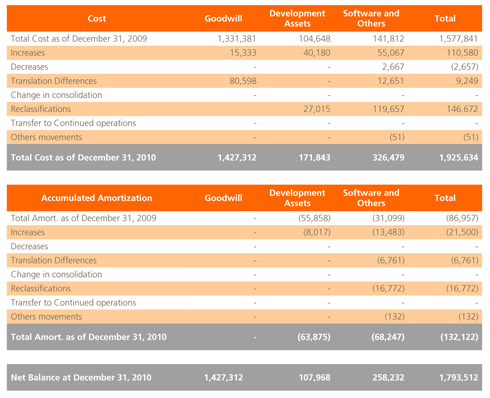
Main variations of the 2010 financial year
The most significant variations of the 2010 financial year are mainly related to: the increase of Goodwill due to the effect of the exchange rate between the Brazilian Real and the US Dollar with regards to the Euro reflected in “Translation Differences” (€81 million) movement, the increase in Development Assets relating to the activity of the Solar and Bioenergy business segments in the amount of €30 million reflected in the “Increases” movement (see Note 4.3), the increase in Software and Others due to a reclassification from the line item Fixed Assets in Projects - Intangible assets of certain software projects of the DTN company belonging to the Information Technologies business segment, upon cancellation of its non-recourse financing, that are reflected in the “Reclassifications” movement (€152 million) and the increase in Software and Others as a result of the implementation of a new ERP system in the whole Group reflected in “Increases” movement (€39 million).
The 2010 financial year Impairment Charges
According to the information provided by Management, during 2010 it was not necessary to record significant losses due to impairment of Intangible Asset.
4.2. The following table sets out the movement of intangible assets in 2009 broken down into those generated internally and other intangible assets:
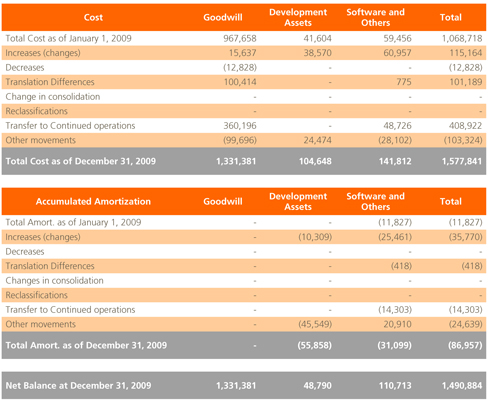
Main variations of the 2009 financial year
The most significant variations of the 2009 financial year are mainly related to: the Goodwill increase caused by the effect of the exchange rate for converting the Brazilian Real into the US Dollar with regards to the Euro reflected in the “conversion differences” movement (€100 million), to the reduction in the DTN goodwill fund reflected in the “Other Movements” movement (€105 million), subsidiary of the Information Technologies business segment, after assigning the acquisition price to assets, liabilities and contingent liabilities assumed, to the increase in the Assets under Development relating to the Solar Business Segment activity for €33 million, reflected in the “increases” movement (see note 4.3) and to the increase in general of all intangible assets from the incorporation of information technologies business segment previously classified as non-current assets held for sale reflected in the “transfer from assets held for sale” movement (€409 million).
Impairment charges during 2009
According to the information available by Management, during 2009 it was not necessary to record significant losses for impairment of Intangible Assets.
4.3. Development Assets
During 2010, Abengoa made significant Research, Development and Innovation (R&D&i) investment effort, investing a total of €92,628 thousand (€89,715 thousand in 2009) through the development of new technologies in different areas of business (solar technology, biofuels, hydrogen, emissions management, energy efficiency and new renewable energies)
The following table summarizes the total investments made in R&D&i in 2010 and 2009:
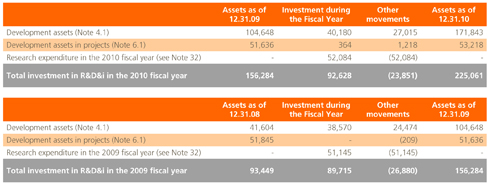
The main items included in the line item of Development Assets are basically part of projects relating to the design and development of plants for producing bioethanol using cellulosic biomass for an amount of €16.7 M and to the design and development of high performance thermoelectric technology solar plants in the amount of €13.7million. The useful life of the aforementioned projects is estimated to be between 25-30 years.
The most significant variations in 2010 are related with research expenses incurred by the Group mainly in relation to technological research and innovation projects from the Solar and Bioenergy business segments and to investments made in one of the development projects relating to the design and development of the plant located in Hugoton, Kansas (US) which produces bioethanol from cellulosic biomass, the main purpose of which is to design, construct and operate the commercial hybrid starch and biomass plant with capacity to hold 380 million liters and which shall be partially financed by the Department of Energy (DOE).
4.4. Goodwill
a) The table below shows the breakdown of Goodwill by legal entity as of December 31, 2010 and 2009:
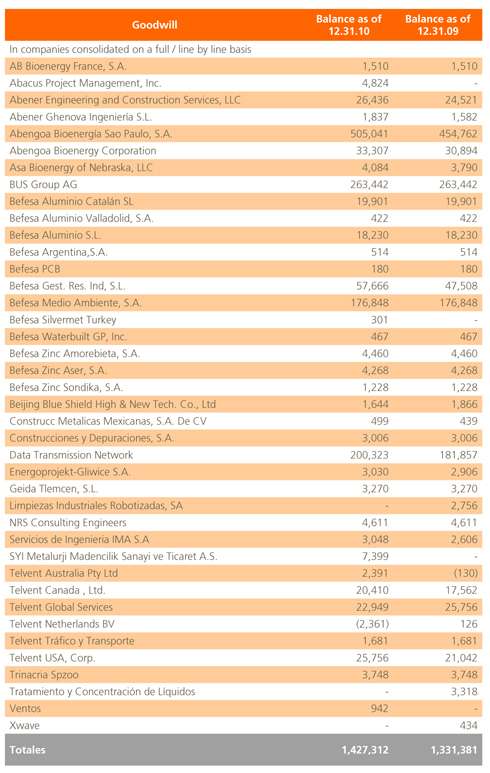
The breakdown of Goodwill by Business Unit is as follows:

The most significant variations in 2010 are mainly the increase caused by the effect of the exchange rate in converting the Brazilian Real to the US Dollar with regards to the Euro (€81 million).
The most significant variations in 2009 mainly relate to exchange rates, caused by the rise in value of the Brazilian Real against the Euro, and the inclusion of the goodwill on the Information Technologies business segment, previously classified as non-current assets held for sale (see note 14).
b) As mentioned in Note 2.7, Abengoa has year-end procedures to identify potential goodwill impairment. Goodwill is impaired when the carrying amount of the Cash Generating Unit to which it belongs is lower than its recoverable amount. The recoverable amount is the higher of the market value less related cost to sell and the value in use, which is the present value of estimated future cash flows.
To calculate the value in use of the major goodwill balances (Environmental Services, Bioenergy and Information Technologies), the following assumptions were made:
Under the basis of the calculations of the value of use, according to hyphothesisprevioulsy described for the 2010 and 2009 financial yearsthe recoaverable amount for the cash flow generating units related to the Goodwill assigned, was significantly higher than its value in books, even after some sensibility analyzes were carried out over the discounts ratios and residual values.
- 10-year financial projections were used for those Cash-Generating Units (CGUs) that have high growth potential based on cash flows taken into account in the strategic plans for each business unit, considering a residual value based on the flow in the final year of the projection.
The use of these 10-year financial projections was based on the assumption that it is the minimum period necessary for the discounted cash flow model to reflect all potential growth in the CGUs in each business segment showing significant investments.
The aforementioned estimated cash flows were considered to be reliable due to their capacity to adapt to the real market and/or business situation faced by the CGU in accordance with the business's margin and cash-flow experience and future expectations.
These cash flows are reviewed and approved every six months by Senior Management so that the estimates are continually updated to ensure consistency with the actual results obtained.
In these cases, given that the period used is reasonably long, the Group then applies a zero growth rate for the cash flows subsequent to the period covered by the strategic plan.
- 5-year cash flow projections are used for all other CGUs, considering the residual value to be the cash flow in the final year projected and applying a growth rate that is in no case higher than the estimated long-term rate for the market in which the company operates (normally between 1% and 6%).
- In any case, sensitivity analyses are performed, especially in relation to the discount rate used, residual value and fair value changes in some of the key variables, in order to ensure that possible changes in the estimates of these items do not impact the possible recovery of recognized goodwill.
- Accordingly, the following table provides a summary of the discount rates used (WACC) to calculate the recoverable amount for Cash-Generating Units to which the goodwill has been allocated with the business segment to which it pertains:
- allocated with the business segment to which it pertains:
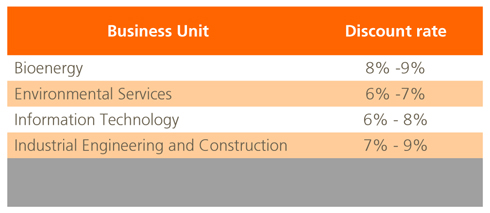
The value-in-use calculations carried out according to the above mentioned assumptions, did not indicate impairment of any of the existing goodwill within the Group, since the recoverable amount exceeds the carrying amount.4.5. There are no intangible assets with indefinite useful life. There are no intangible assets with restricted ownerships or that may be under pledge as liabilities guarantee.
- 10-year financial projections were used for those Cash-Generating Units (CGUs) that have high growth potential based on cash flows taken into account in the strategic plans for each business unit, considering a residual value based on the flow in the final year of the projection.
-
Note 5.- Property, Plant and Equipment
5.1. The table below shows the movement on the different categories of Property, plant and equipment for 2010:
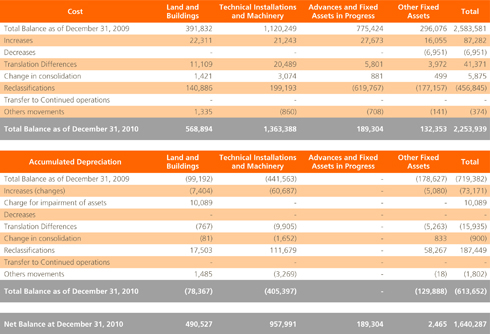
Main variations of the 2010 financial year
The most significant variations that occurred in the 2010 financial year are mainly in the reduction of all the tangible fixed assets by converting the tangible fixed assets from Abengoa Bioenergy company in Brazil to the fixed assets in projects reflected in the “reclassifications” movement amounting to €515million given its consideration as project company since it obtained a new non-recourse financing to carry out its activities (see note 6.1) and due to the increase caused in general in all tangible fixed assets as a result of the effect of the exchange rate in translating the Brazilian Real to the US Dollar with regards to the Euro reflected in the “translation differences” movement (amounting €41 million).
The 2010 financial year Impairment Charges
The main impairment charges recognized in the 2010 financial year relate tothe promotion of the Mojave Project of the Solar business segment amounting to €11 million due to, as was the case of the 2009 financial year, with problems still existing in the financing of the development of said project, and considering that the contracts signed with the electric energy distributor company for the construction of the solar plant are subject to obtaining the financing, they were deemed dubious short-term recoverability.
The amount of said impairment together with that of the 2009 financial year are part of the excess between the carrying value (€37 million) and its recoverable amount (€34 million) considering the latter as the fair value less the costs of sale.Also, regarding the impairment in the 2009 financial year on the lands acquired in the United States in relation with the Solana project, it should be mentioned that at the close of the 2010 financial year, the US Government, through the Department of Energy (DOE), has granted Abengoa Solar a Conditional Commitment to issue a Federal Guarantee for the amount of US $1,450 million in relation to this project after meeting the Conditions Precedent (CsP) set forth as a prerequisite. Some of said CsP are as follows:
- To obtain the permits necessary to start the construction, entering into several contracts with such as the EPC (turnkey), Operation and Maintenance, etc.
- Financing with own funds necessary for this project.
Therefore, given that the achievement of the Conditional Commitment is a very important step towards obtaining the financing and thus for the development of the Solana project within the framework of the agreements signed with the electric energy distributor, the management of the group considers that the reasons for which the impairment of the acquired assets was deemed probable has vanished such that at the close of the 2010 financial year the impairment was reverted in the amount of €28 million reflected as a reductions movement in the line of charge for impairments of assets (see impairment charges explanation for the 2009 financial year).
5.2. The table below shows the movement on the different categories of Property, plant and equipment for 2009:
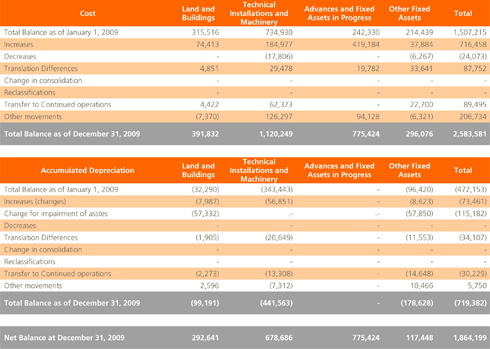
Main variations of the 2009 financial year
The most significant variation in the 2009 financial year is mainly in the increase due to advances in construction in the execution of new projects relating to Bioenergy activity (Cogeneration Brazil, Netherlands and San Roque for €720 million) and the acquisition of land for Solar projects (€74 million) reflected in the “increase” line movement, also due to the increase in general in all tangible fixed assets through the effect of translation exchange rates mainly caused by the appreciation of the Brazilian Real against the Euro reflected in the “transalation differences” movement (€88 million), due to the increase caused by the incorporation of all the tangible fixed assets relating to the business segment of Information Technologies previously classified as non-current assets held for sale reflected in the “transfers to continued operations” movement (€89 million) and the acquisition of 50% of the Biocarburantes Castilla y León Company (€90 million). See note 39.
Impairment charges
The main impairment charges recognized in 2009 relate to Solar and Bioenergy activities and are shown reducing the carrying amounts of certain assets of property, plant and equipment down to their recoverable amount through recognition of a loss of €115,182 thousand in the Income Statement.
a) Impairment of assets relating to the solar activity
The circumstances identified at the end of 2009 as an indication of the possible impairment of certain assets of the Solar segment activities consisted of certain external issues of a probable nature relating to the legal and financial environment.
The amount recognized at the end of 2009 for the impairment loss affecting said solar assets totaled€71 million.
The impaired assets mainly consist of development expenses and land acquisitions that took place to develop projects relating to thermosolar technology electricity generation plants located in the United States and Spain.
The most significant amount of the impaired assets is that of the impairment of the lands acquired in the Arizona Desert in the US for the commercial development of two new projects (Solana and Mojave) for €57 million.
The amount of said impairment is the excess between the book value (€79 million) and the recoverable amount (€22 million) considering the latter as the fair value less the sales costs.
The book value of the lands linked to said project were based on their industrial usage. Given the problems existing with the financing for the execution of the projects and considering that the contracts signed with the electric energy distributor company for the construction of the solar plants was subject to obtaining the financing, it was decided that the lands be considered non-industrial usage for the purpose of estimating the fair value. Thus, the fair value of the impaired assets was calculated using the best informations on the value of the lands for non-industrial usage such that it reflects the amount that could be obtained from a sales transaction involving these kinds of assets between interested and informed parties and after the deduction of the costs of sale.
The rest of the impaired amount reaching €14 million are for the expenses incurred in various developmental stages of the Thermosolar Project in Spain which, due to the changes in the existing regulation by virtue of RDL 6/2009 which gives rise to the creation of a mechanism for the pre-allocation of compensation for facilities under the special system, did not prioritize its access to the elect grid sue to its inability to meet all the requirements outlined in said RDL and which was therefore deemed project of dubious short-term recoverability because, without said inscription, it would be impossible to obtain the economic system of bonuses linked to such electric energy generation facilities.
We have not classified these assets as held for sale because we do not intend to sell these assets, which is a requirement under IFRS 5. In considering their fair value we do however, consider that the most likely form of their future recovery will take place through their sale considering the indications that make it doubtful that financing can be obtained and, as a result delays the build-out of these projects as planned. These Solar plants are among some of the largest ever construction and require a significant cash investment through third party financing. Due to market conditions through 2009 we could not be assured of obtaining financing for these projects.
b) Impairment of assets relating to the biofuel activity
The circumstances identified at the end of 2009 as an indication of the possible impairment of certain assets relating to biofuel segment activities consisted of certain external issues of a probable nature relating to the legal and technologic.
The amount recognized at the end of 2009 relating to the impairment loss totaled €44 million.
The impaired assets mainly consist of development and design expenses and certain assets that were acquired to develop projects relating to bioethanol production plants located in Europe.
The amount of the impairment of this biofuel business segment assets consists of the difference between the carrying amount of the assets (€78 million) and the recoverable amount (€34 million), defined as the fair value less cost to sell.
The fair value of such assets was calculated based on the best information available to the company, so that it reflects the amount that could be obtained from the sale of these assets in a transaction between interested and informed parties, after deduction of the cost to sell.
The power plant assets impaired are associated with the projects in Germany and the United Kingdom, which are comprised of €27 million of hard assets (such as turbines) and €17 million of design, development and construction costs to make the respective assets ready for its intended use. These projects are being redesigned to fully adapt them to the legal requirements established by the new European Directive on CO2 emissions “EU CO2 Emissions Directive”, so that, after these projects are launched, they will commence their operations in the market with a competitive advantage over the rest of our competitors. The components of the assets impaired, or written to zero are those that have been identified as components related to the original power train asset design that have been deemed to be of doubtful of recovery and will be replaced or re-performed as part of the power train asset re-design contemplated by management in order to comply with the EU CO2 Emissions Directive.
Based on the above, Management assessed the assets that did not meet the necessary expectations for adequate use and decided to impair them based on recovery expectations, determined by analyzing their use or a possible sale for other uses.
According to the information available, during the year 2010 has not been necessary to record impairment losses on these assets.
5.3. Property, plant and equipment not assigned to operating activities at the year end is not significant.
5.4. The companies’ policy is to contract all insurance policies deemed necessary to ensure that all property, plant and equipment is covered against possible risks that might affect it.
5.5. The amount of capitalized interest costs in 2010 was €21,857 thousands (€29,844 thousand in 2009).
5.6. Property, Plant and Equipment includes the following amounts where the group is a lessee under a finance lease:

-
Note 6.- Fixed Assets in Projects (Project Finance)
As indicated in Note 2.4 the Group includes several companies which engage in the development of integrated products including the design, construction, financing, operation and maintenance of owned projects as well as some concession projects.
This note provides a breakdown of the tangible and intangible fixed assets within such projects as well as further relevant and related information upon such assets (non-recourse financing details related to such projects is disclosed in Note 15 of these Notes to the Financial Statements).
6.1. Intangible Assets of projects.
a) The following table shows the movements of intangible assets included in the heading Fixed Assets in Projects for 2010:
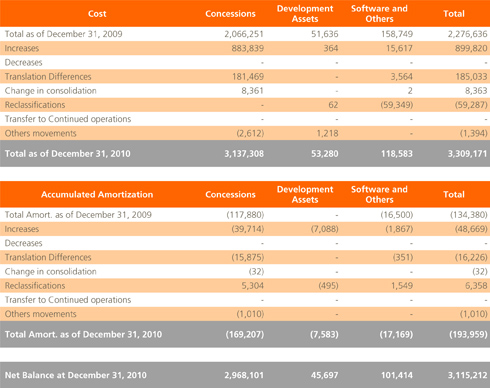
Main variations of the 2010 financial year
The most significant variations that occurred in the 2010 financial year are mainly in the increase in concessions as a result of the progress in the construction during the execution of new projects relating to Solar activity (SPP1 for €50 million), including the Transmission Lines activity of the business segment of the Industrial Engineering and construction (mainly because of the transmission lines in Brazil, Peru and Mexico)for €664 million and the Desalination activity of the Environmental Services business segment (mainly because of desalination plants in Algeria) for €81 million, all of them reflected in the “increases” movement , due to the reduction caused by transfering the IT intangibles (software) of the Information Technologies business segment’s DTN Company to intangible assets upon cancellation of its non-recourse financing and which is reflected in the “reclassifications” movement (€152 million) and due to the increase in general in all intangible assets from the effect of the conversion exchange rates produced by the appreciation of the Brazilian Real against the Euro reflected in the “translation differences” movement (€185 million)
The 2010 financial year Impairment Charges
According to the information provided by management, for the 2010 financial year there was no need to register significant losses due to impairment of the Intangible Asset elements.
b) The following table shows the movements of intangible assets included in the heading Fixed Assets in Projects for 2009:
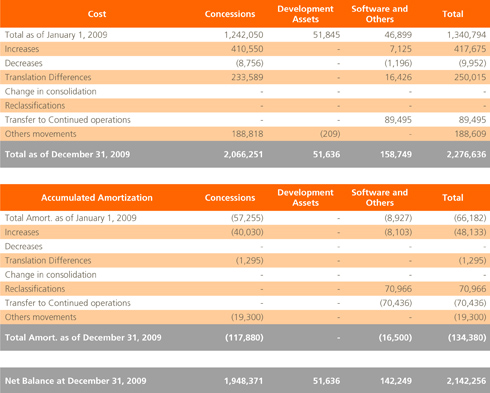
Main variations of the 2009 financial year
The most significant variations that occurred in the 2009 financial year are mainly in the increase in concessions as a result of the progress in the construction during the execution of new projects relating to Solar activity (SPP1 for €75 million), including the Transmission Lines activity of the Industrial Engineering and Construction business segment (projects in Brazil and Peru for €264 million) and the Desalination activity of the Environmental Services business segment (plants in Algeria for €150 million) reflected in the “increases” movement, due to the increase in general in all intangible assets from the effect of the exchange rates produced by the appreciation of the Brazilian Real against the Euro reflected in the “translation differences” movement (150 million) and due to increase caused by the incorporation of all intangible assets relating to the business segment of Information Technologies previously classified as non-current assets held for sale reflected in the “transfers to continued operation” movement (€-70 million).
The heading “Concession” includes those assets related service concession public-to-private agreements in which the public sector controls or regulates the service provided with the infrastructure and their prices, and it is contractually guaranteed to gain, at a future time, ownership of the infrastructure through which the service is provided. The infrastructures accounted for by the Group as concessions are mainly related to the activities concerning power transmission lines, desalination plants and certain thermo-solar electricity generation plants. These infrastructures are considered as assets subject to the conditions of a concession in a given period, in regard of which the Group maintains sufficient risk elements to be able to consider the underlying assets as intangible assets, subject to the provisions of IAS 38 and amortizable, taking into account the expected period of commercial operation of the infrastructure (for more detail of such concession agreements see Note 6.3).
The line item of assets under development mainly include the amount invested in the PS10 Solar Project relating to the creation of high performance Thermoelectric Solar Technology Plants which as at December 31, 2010 amounted to €53 million (€52 million in 2009). For more information on investment in Development see Note 4.3.
The 2009 financial year Impairment Charges
According to the information available, during the years 2010 and 2009 has not been necessary to record impairment losses on intangible assets in significant amounts.
c) The amount of the capitalized financial cost during the year 2010 totals to €44,866 thousand.
d) There are no intangible assets with indefinite useful life. There are no intangible assets whose title is restricted or that are pledged as security for liabilities
6.2. Tangible Assets of projects
a) The table below shows a breakdown of the movement in property, plant and equipment assets in projects for 2010:
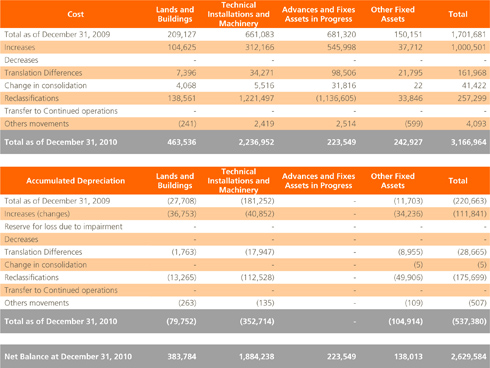
Main variations of the 2010 financial year
The most significant variations produced during the year 2010 are related mainly to increase in the execution of new projects related to the Solar activity (€618 million mainly due to work advances of projects in Spain and Algeria), Bioenergy (€82million by projects in the United States and the incorporation of Abengoa Bioenergía Brazil as project company (€515 million and Environmental Services (€82million due to work advances in projects in Spain and China) and for the translation differences of the exchange rates mainly produced by the appreciation of the Brazilian Real compared to the Euro (€161million), as well as the completion and come into operation the Bioenergy plants located in USA and the Solar plant located in Spain.
b) The table below shows a breakdown of the movement in property, plant and equipment assets in projects for 2009:
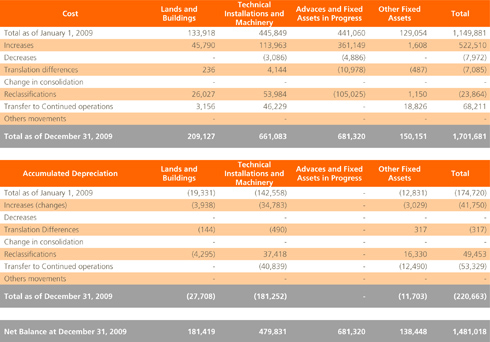
Main variations of the 2009 financial year
The most significant changes during 2009 are mainly the increase in the execution of new projects relating to Solar, Bioenergy and Environmental Services, the exchange rate mainly occurring as a result of the appreciation of the Brazilian Real against the Euro and the incorporation of the fixed assets of the Information Technologies business segment previously classified as non-current assets held for sale.
Impairment charges for the 2010 financial year
According to the information available through the Administrators, in the 2010 financial year it was not necessary to enter significant losses due to the impairment of elements of tangible fixed assets of relevance.
c) Capitalized financial costs during the year 2010 amounts to Euro €78,316 thousand (€77,990 thousand in 2009).
d) The fixed assets in projects has no mortgage warranty or similar, in addition to the ones assigned by its non recourse financing (see Note 15).
e) It is the policy of the Group to enter into a number of insurance policies to cover risks relating to property, plant and equipment.
f) In cases of property plant and equipment over third party land, the company estimated the dismantling costs of affected items, as well as the rehabilitation costs of the place where they are settled, see Note 19.1.
g) The table bellow sets out the information related to those assets constructed by the group during years 2010 and 2009 classified under the heading fixed assets in projects of the Statement of Financial Position (intangible assets and property plant and equipment):

6.3. Acuerdos de Concesión de Servicios
The following table summarizes the information taken into consideration within the scope of IFRIC 12 (expressed in thousands euros):
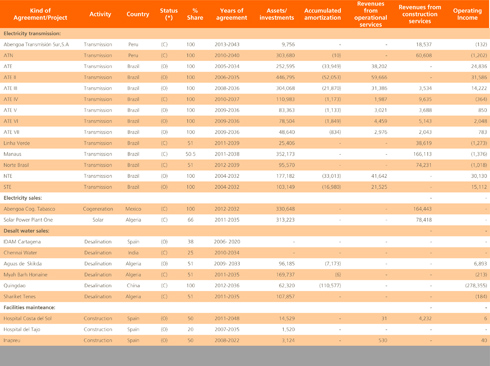
(*) Operation (O); Construction (C)
-
Note 7.- Investments in Associates
7.1. The table below shows the breakdown and the movement on the investments held in associated companies for 2010:
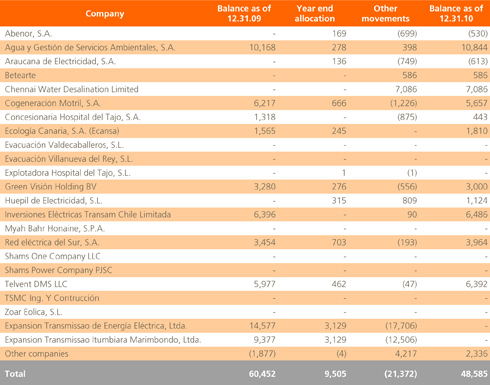
The “Other Movements” amounts reflect, in general, translation differences (€949 and €4,799 thousand in 2010 and 2009 respectively), changes in the consolidation perimeter (€-48,534 and €23,049 thousand in 2010 and 2009 respectively) and dividends (€-1,683 and €-5,704 thousand in 2010 and 2009 respectively).
The most significant variations in 2010 correspond to the sale of the 25% shareholding in Expansion Transmissão de Energía Eléctrica, Ltda. and Expansion Transmissão Itumibiara Marimbondo, Ltda. (see Note 2.2.b).
7.2. The table below shows the breakdown and movementon the investments held in associated companies for 2009
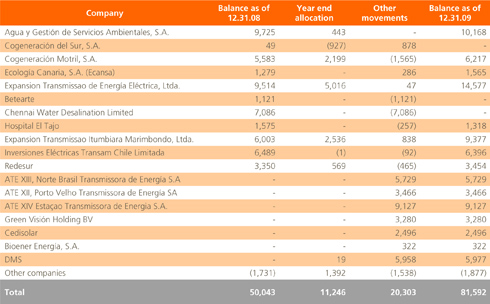
The most significant variations occurring in 2009 correspond to the incorporation in the consolidation perimeter of entities within the transmission line activity in Brazil (ATE XII, ATE XIII and ATE XIV) for and amount of €18,322 thousands.
7.3. The table below shows a breakdown of assets, liabilities, revenues and operating profit as well as other information of interest for the year 2010 of the associated companies:

(*) The company is incorporated but not disbursed because it is no definitive.
-
Note 8.- Inventories
8.1. Inventories as of December 31, 2010 and 2009 were as follows:
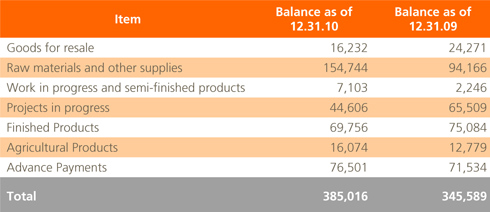
Inventories for entities located outside Spain were €239,099 thousand (€210,725 thousand in 2009).8.2. There are no restrictions on the availability of inventories, with the exception of guarantees provided for construction projects in the normal course of business, which are released as the contractual milestones of the project are achieved.
-
Note 9.- Financial Risk Management and Information on Financial Instruments
9.1. Financial risk
Abengoa’s activities are undertaken through its Business Units and are exposed to various financial risks: market risk (including currency risk, interest rate risk and price risk), credit risk, liquidity risk and capital risk.
The risk management model attempts to minimize the potential adverse impact of such risks upon the Group’s financial performance. Risk is managed by the Group’s Corporate Finance Department, which is responsible for identifying and evaluating financial risks in conjunction with the Group’s operating units, quantifying them by project, region and company.
Written internal risk management policies exist for global risk management, as well as for specific areas of risk, such as foreign exchange risk, credit risk, interest rate risk, liquidity risk, the use of hedging instruments and derivatives and the investment of cash surpluses.
In addition, there are official written management regulations regarding key controls and control procedures for each company and the implementation of these controls is monitored through internal audit procedures.
The Group is affected by the following financial risk:
a) Market risk
Market risk arises when group activities are exposed fundamentally to financial risk derived from changes in foreign exchange rates, interest rates and changes in the fair values of certain assets and commodities.
To hedge such exposure, Abengoa uses currency hedge forward contracts, options and interest rate swaps as well as futures contracts for the aforementioned commodities. The Group does not use derivatives for speculative purposes.
- Foreign exchange rate risk; the international activity of the group generates exposure to foreign exchange rate risk. Foreign exchange rate risk arises when future commercial transactions and the assets and liabilities recognized are not denominated in the company’s functional currency. The main exchange rate exposure for the Group relates to the US Dollar against the Euro and the Brazilian Real.
To control foreign exchange risk, the Group purchases forward currency sale/purchase options. Such contracts are designated as fair-value or cash-flow hedges, as appropriate.
In the event that the exchange rate of the US Dollar had risen by 10% against the Euro onDecember 31, 2010, with the rest of the variables remaining constant, the effect in the profit and loss accounts would have been a profit of €24,522 thousands mainly due to the US Dollar net asset position of the group in companies with Euro functional currency and an increase of €10,897 thousands in other reserves as a result of the cash flow hedging effects on highly probable future transactions.
In the event that the exchange rate of the US Dollar had risen by 10% against the Brazilian Real on December 31, 2010, with the rest of the variables remaining constant, the effect in the profit and loss accounts would have been a loss of €11,082 thousands mainly due to the US Dollar net liability position of the group in companies with Brazilian Real functional currency and an increase of €9,437 thousands in other reserves as a result of the cash flow hedging effects on highly probable future transactions.
Approximately 95% of projected transactions which are not denominated in the company’s functional currency qualify as highly probable forecast transactions for hedge accounting purposes.
Details of the financial hedging instruments and foreign currency payments as of December 31, 2010 and 2009 are included in Note 11 of these Notes to these consolidated Financial Statements.
- Interest rate risk arises mainly from financial liabilities at variable interest rates.
Abengoa actively manages the risks exposures of its interest rates in order to mitigate the risks to which the variations in the interest rates may be exposed which are derived from debt that contracted at a variable interest rate.
In non-recourse financing (see Note 15), as a general rule, the Company enters hedging arrangements for at least 80% of the amount and the timeframe of the relevant financing, through options and/or swaps contracts.
In corporate financing (see Note 16), as general rule, a minimum of 80% of the debt is covered under hedging relationships throughout the term of the debt; in addition, in 2009 and 2010, Abengoa issued bonds at a fixed interest rate on the capital markets.
Thus, the main interest rate exposure for the Group relates to the variable interest rate with reference to the Euribor.
To control the interest rate risk, the Group primarily uses interest rate swaps and interest rate options (caps), which, in exchange for a fee, offer protection against a rise in interest rates.
In the event that the Euribor interest rates had risen by 25 basic points on 31 December 2010, with the rest of the variables remaining constant, the effect in the income statement would have been a profit of €13,324 thousands, mainly due to the fair value increase due to the time value of the interest rate caps designated as hedges and an increase of €40,692 thousand in other reserves as a result of the fair value increase of interest rate swaps and caps designated as hedges.
A breakdown of the financial derivative instruments relating to interest rates as of December 31, 2009 are provided in Note 11 of these Notes to the consolidated Financial Statements.
- The risk of a change in commodities prices arises through both the sale of the Group’s products and the purchasing of commodities for production processes. The main risk of change in commodities prices exposure for the Group is related to the price of zinc, aluminum, grane, ethanol, sugar and gas.
In general, the Group uses forward purchase contracts and options listed on organized markets, as well as OTC (over-the-counter) contracts with financial institutions, to mitigate the risk of market price fluctuations.
At December 31, 2010, if the price of zinc would have increased by 10%, with the other variables constant, the effect on the income statement would have been a profit of €2.045 thousand and an increase in other reserves of €1,017 thousand, due to the effect of cash flow hedges that the group maintains.
A breakdown of the commodity derivative instruments as of December 31, 2010 is included in Note 11 of these Notes to the Financial Statements.
In addition and independent of these transactions certain Group companies began to engage in purchase and sale transactions in the grain and ethanol markets, in accordance with a management policy for trading transactions.
These operations reflect the implementation of management-approved strategies for the purchase and sale of forward and swap contracts, mainly for grain and ethanol, which are controlled and reported on a daily basis, following the procedures established in the Transactions Policy. As a risk-mitigation element, the company sets daily limits or “stop losses” for each strategy, depending on the markets in which it operates, the financial instruments purchased and the risks defined in the transaction.
These transactions are valued monthly at fair value through the income statement. In 2010, Abengoa recorded gains of €12,305 thousand (€1,999 thousand in 2009), €11,061 thousand of which related to gains on settled transactions (€1,630 thousand in 2009) and €1,244thousand to potential profits based upon open derivative contracts valued at the year end (€369 thousand in 2009).
b) Credit risk
The main financial assets exposed to credit risk derived from the failure of the counterparty to meet its obligations are trade and other receivables, current financial investments and cash.
a) Trade and other receivables (see Note 12).
b) Current financial investments and cash (see Notes 9, 10, 11 and 13).
- Trade and other receivables: Most receivables relate to clients operating in a range of industries and countries with contracts which require ongoing payments as the project advances, the service is rendered or upon delivery of the product. It is common practice for the company to reserve the right to cancel the work in the event of a material breach, especially non-payment.
In general, and to mitigate the credit risk, as prerequisite to any commercial contract or business agreement, the company generally holds a firm commitment from a leading financial institution to purchase the receivables without recourse (factoring). In these agreements, the company pays the bank for assuming the credit risk and also pays interest on the financing. The company always represents that the receivables are valid.
In this respect, Abengoa derecognizes the factored receivables from the Statement of Financial Position when all the conditions of IAS 39 for derecognition of assets are met. In other words, an analysis is made as to whether all risks and rewards of ownership of the related financial assets have been transferred, comparing the company’s exposure, before and after the transfer, to the variability in the amounts and the calendar of net cash flows from the transferred asset. Once the company’s exposure to this variability has been eliminated or substantially reduced, the financial asset has been transferred.
In general, Abengoa considers that the most significant risk to these assets within its activity is the risk of uncollectibility, since: a) trade receivables may be quantitatively significant during the progress of work performed for a project or service rendered; b) it would not be within the company’s control. However, the risk of delays in payment is considered to be of little significance in these contracts and typically relates to technical problems, i.e. associated with the technical risk of the service provided and, therefore, within the company’s control.
In any case, to cover those contracts in which the possibility of a payment delay from the client, with no commercial justification, could theoretically be identified as a risk associated to the financial asset, Abengoa establishes that, not only should the risk of legal insolvency (bankruptcy, etc.) be covered, but also that of de facto or evident insolvency (arising from the client’s management of its own cash, even though there is no “general moratorium”).
Consequently, if from the individual assessment of each contract it is concluded that the risk associated to the contract has been transferred to the financial institution, the receivable is derecognized in the Statement of Financial Position at the time it is transferred, in accordance with IAS 39.20.
As stated previously, Abengoa follows the policy of transferring the credit risk associated to the items included in trade and other receivables by using non-recourse factoring contracts. In addition, it would be necessary to exclude from the trade and other receivables balance, the potential effect of trade receivable balances for work completed pending certification for which factoring contracts are in place, the effect of other trade receivable balances that could be factored but have not yet been sent to the factoring entity at the year end, and assets that are covered by credit insurance and are included within trade and other receivables. Consequently, with this policy, Abengoa minimizes its credit risk exposure.
A trade receivables ageing analysis as of December 31, 2010 and 2009 is included in Note 12”Clients and “Other Receivable Accounts”. The same note also outlines the credit quality of the clients and it analyses the client loyalty as well as the movement on provisions for receivables over the year and- Financial investments: to control credit risk in the execution of financial investments, the group has established corporate criteria to minimize such exposure assuring that counterparties are of recognized prestige and with high credit ratings as well as establishing investing or hiring limits with periodic review.
c) Liquidity risk
Abengoa’s liquidity and financing policy is intended to ensure that the company keeps sufficient funds available to meet its financial obligations as they fall due. Abengoa uses two main sources of financing:
- Non-recourse project financing, which is typically used to finance any significant investment (see Notes 2.4 and 15). The repayment profile of each project is established on the basis of the projected cash flow generation of the business, allowing for variability depending on whether the cash flows of the transaction or project can be forecast accurately. This ensures that sufficient financing is available to meet deadlines and maturities, which mitigates the liquidity risk significantly.
- Corporate Finance, used to finance the activities of the remaining companies which are not financed under the aforementioned financing model. This means of financing is managed through Abengoa S.A., which pools cash held by the rest of the companies so as to be able to re-distribute funds in accordance with the needs of the Group (see Notes 2.18 and 16) and to ensure that the necessary resources are obtained from the bank and capital markets.
To ensure there are sufficient funds available for debt repayment in relation to its cash-generating capacity, Abengoa has put in place the following criteria and actions:
1) Maintaining sufficient leverage headroom by not exceeding a given Net Debt/EBITDA ratio limit of corporate financing. The maximum headroom as per the financing contracts in 2010 and 2009 was 3.0, respectively. Net debt is calculated as all third party borrowings less cash and financial investments of current asset excluding the debt of operations financed without recourse. The denominator of the ratio is derived as the EBITDA of the entities which do not utilise non-recourse project finance and incorporating R&D&i expenses for the year.
At the close of 2010 and 2009, Abengoa’s Net Debt/EBITDA ratio were 1.8 and 1.84 respectively, fulfilling the requirement related to Net Debt/EBITDAratio.
2) The Corporate Financial Department annually prepares and the Board of Directors approves a Financial Plan that engulfs all the financing needs as and how such financing will be provided. In the 2010 financial year Abengoa consolidated its presence as a recurring issuer on the capitals markets, executing issuances on American and European institutional debts markets; syndicated financing operations constituting the basis of its corporate financing were also successfully re-financed, as well as a new financing transactions in subsidiaries which have the support of export credit agencies.
3) Proactive management of working capital in order to generate liquidity and cash flows sufficient tomeet our requirements and obligations for the foreseeable future.
4) Continuous monitoring of the provisions of the Group's liquidity reserve (which includes credit facilities (Note 16) and cash and cash equivalents (Note 16) based on expected cash flows.
In accordance with the foregoing, the sources of finance are diversified, in an attempt to prevent concentrations that may affect the working capital liquidity risk.
An analysis of the Group’s financial liabilities into relevant maturity groupings based on the remaining period is included in the following Notes these consolidated Financial Statements:

d) Capital risk
The Group manages its investments in equity to ensure the continuity of the activities of its subsidiaries from an equity standpoint by maximizing the return for the shareholders and optimizing the structure of equity and debt in the respective balances.
The objective is the constant and sustained achievement of the Group’s results through organic growth. To achieve these objectives, it is necessary to strike a correct balance in the businesses between control over the financial risks and the financial flexibility required to achieve the objectives.
- Since the admission of its shares to trade on the stock market, the company has grown in the following ways:
- Cash flows generated by conventional businesses;
- Financing of new investments through non-recourse financing, which also generates induced business for conventional businesses;
- Corporate financing, either through banks or capitals markets;
- Issuance of new shares of subsidiaries through organized markets like in the case of Telvent in the 2004 financial year;
- Assets turnover, such as the eolic activity divestiture, partial divestiture of Telvent or the sale of mature concessional shares, such as the sale of shares in projects relating to the transmission line concession activity (Expansion and ETIM).
The last capital increase occurred in 2000, for €75 million.
The leverage level objective of the activities of the company is not measured based on the level of debt on own resources, but on the nature of the activities:
- For activities financed through Non-recourse Financing each project is assigned a leverage objective based on the cash and cash flow generating capacity, generally, of contracts that equip these projects with highly recurrent and predictable levels of cash flow generation. In general, the levels of leverage reached are relatively high.
- For activities financed with Corporate Financing, the objective is to maintain reasonable leverage, defined as three (3) times Ebitda over Net Debt minus the Ebitda and the non-recourse financing.
9.2. Information on financial instruments
a) The Group’s financial instruments are primarily deposits, trade and other receivables, derivatives and loans. Financial instruments by category, reconciled with the Statement of Financial Position, are as follows:
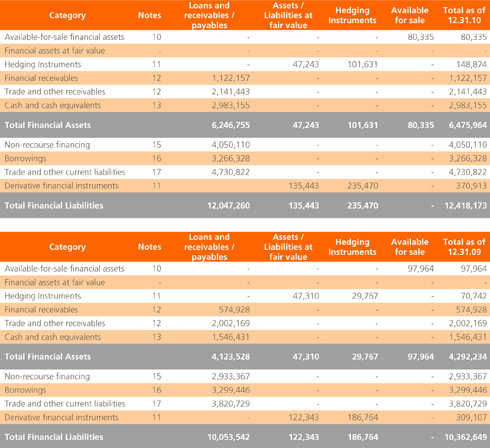
b) On January 1, 2009 the Group adopted the amendment to IFRS 7 for financial instruments measured at fair value, which requires a breakdown of the fair value measurements based on the following classifications:
- Level 1: Quoted prices in active markets for identical assets or liabilities.
- Level 2: Measured at observable market prices, other than quoted prices, either directly, derived from prices, or indirectly, by application of valuation models.
- Level 3: Measured on the basis of non-observable market data.
The following is a breakdown of the Group’s assets and liabilities measured at fair value at December 31, 2010 (except assets and liabilities with a carrying amount close to their fair value, non-quoted equity instruments measured at cost and contracts with components that cannot be measured reliably):
The following table shows the changes in the fair value of level 3 assets at December 31, 2010 and 2009:
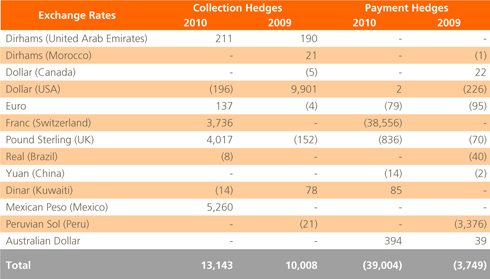
There are no companies in which holding less than 20% of the voting or potential voting power is determined that the company has significant influence and in which holding less than 20% of the voting or potential voting power is determined that the company does not have significant influence.
-
Note 10.- Available-for-sale Financial Assets
10.1. The following table shows the movement on available-for-sale financial assets during 2010 and 2009:

The most significant variations produced during the year 2010 are due to lower short-term investments of cash in excess.
The heading of Derecognitions/Translation differences contains the losses recognized during 2009 for impairment losses on available-for-sale financial assets for an amount of €12,440 thousand (see Note 9.2), in shares traded in the US (Dyadic Investment and O2 Diesel) belonging to the Bioenergy business segment and recognized in the financial outcome of the profit and loss accounts under the epigraph of other net finance income/expenses.
At December 31, 2010, according to the criteria established by IAS 39, management evaluated the existence of objective evidence of impairment of these shares by observable and significant events occurred which could show that the impariment was not temporary and was treated as permanent recognising an impairment loss in the consolidated income statement adjusting the carrying amount of those shares to their fair value determined based on their last listed price in an active market.
10.2. The following table shows those entities which, in accordance with the then current legislation, were not consolidated in the years 2010 and 2009 (see Note 2.2) and in which the parent company’s direct and indirect shareholding is higher than 5% and lower than 20%. The net carrying amount of these holdings is €14,126 thousand (€10,961 thousand in 2009).
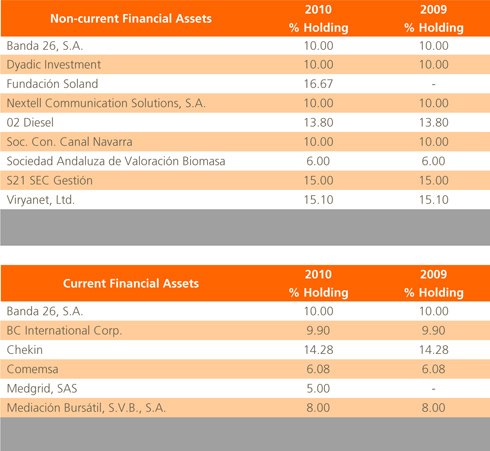
10.3. All necessary notifications have been made to the companies in which the Group holds an interest of over 10%, as required under Article 155 of the Capital Societies Law (Ley de Sociedades de Capital).
10.4. There are no known substantive circumstances which have a material impact on the financial assets on the Group’s portfolio, such as litigations, attachments, etc.10.5. There are no firm agreements in place regarding the sale or purchase of these investments which could be considered material in relation to the Group’s Financial Statements.
10.6. The amount of interest accrued but not yet collected is not material.
10.7. There are no fixed-yield securities in arrears. The average rate of return on fixed-yield securities is in line with the market.
10.8. As of December 31, 2010 and 2009, Abengoa, S.A. held a 3% interest in Xfera, S.A., recorded at a cost of €32,997 thousand and held in the Group under the ownership of Telvent Investments, S.A. (a holding company owned 100% by Abengoa, S.A.). Additionally the shareholders of Xfera have granted this company several “participative” loans in accordance with a plan that has been drawn up, which means a total disbursement of €21,030 thousand by Telvent in 2010 (€19,260 thousand in 2009 ), equivalent to 3% of the total loan made to the company by its shareholders in said years.
To measure this holding, as in prior periods, once Xfera’s activities had commenced under the trade name of Yoigo, the principal reference point taken was the company’s future cash-flow generation on the basis of its current Business Plan, discounted at a rate appropriate to the sector in which this company operates.
The result of said valuation method does not significantly differ from the fair value at December 31, 2010 and 2009, as there is no quoted market price for this security.
As a result of the purchase of its holding in Xfera, Telvent GIT, S.A. became responsible, from the beginning, for furnishing guarantees to the Spanish Administration as security for compliance with the commitments relating to investment, commercialization, employment and network development acquired by Xfera Móviles, S.A., together with other guarantees relating to the Radioelectronic Spectrum Rate, which the Group is required to counter-guarantee, for a total amount of €12,085 thousand (€12,085 thousand in 2009).10.9. The Group applies IAS 39 to determine whether the carrying amount of an available-for-sale financial asset has been impaired. This process requires significant judgement. To make this judgement, the Group assesses, among other factors, for how long and to what extent the fair value of an investment will be below its cost, considering the financial health and short-term prospects of the company issuing the securities, including factors such as the industry and sector return, changes in the technology and cash flows from operating and financing activities.
-
Note 11.- Derivative Financial Instruments
11.1. The fair value of derivative financial instruments as of December 31, 2010 and 2009 was as follows:
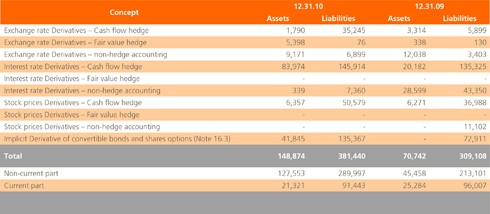
The classification of derivative financial instruments classified as non-hedge accounting derivatives are those derivative financial instruments which, although obtained for the purpose of hedging certain market risks (interest rates, exchange rates and commodity prices), do not meet the specific requirements established by IAS 39 to be designated as hedging instruments from an accounting point of view (since, at the inception of the hedge, there was no designation or formal documentation relating to the hedge or the risk management strategy that it was intended to implement) or, having complied with all of the requirements to be designated a hedging instrument, the underling has been sold or the hedging designation has been interrupted.
11.2. Exchange rate hedges
The following table shows a breakdown of the notional amounts of the financial instruments relating to amounts receivable and payable in foreign currencies as of December 31, 2010 and 2009:
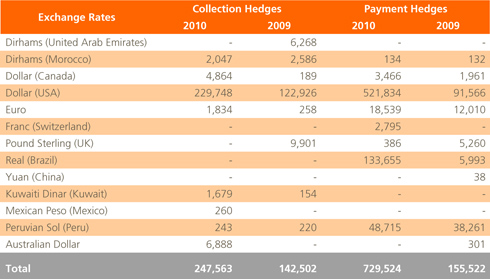
The following table shows a breakdown of the fair values of exchange rate derivatives relating to amounts receivable and payable in foreign currencies as of December 31, 2010:
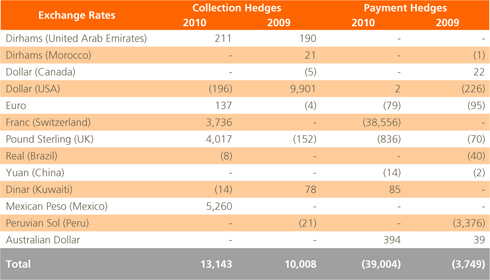
a) Cash flow hedges
The table below shows a breakdown of the maturities of notional amounts of exchange rate derivatives designated as cash flow hedges at the 2010 and 2009 year end:

The table below shows a breakdown of the maturities of fair value amounts of exchange rate derivatives designated as cash flow hedges at the 2010 and 2009 year end:

The net amount of the fair value of exchange rate derivatives designated as cash flow hedges transferred to the Income statement in 2010 and 2009 has been of €206 and €1,493 thousand respectively (see Note 24).
The ineffective amount recognized in the income statement for the years 2010 and 2009 originated by the exchange rate derivatives designated as cash flow hedges amounts to €434 and €169 thousand respectively.
The after-tax gains/losses accumulated in equity in connection with exchange rate derivatives designated as cash flow hedges at December 31, 2010 amounted to €-9,807 thousand (€-128thousand in 2009). See note 24.
b) Fair value hedges
The table below shows a detail of the maturities of notional amounts of exchange rate derivatives designated as fair value hedges as at the close of 2010 and 2009:

The table below shows a detail of the maturities of notional amounts of exchange rate derivatives designated as fair value hedges at the close of 2010 and 2009:

The net amount of the fair value of exchange rate derivatives designated as fair value hedges transferred to the Income statement in 2010 and 2009 has been of €-18,261thousand and €-1,246 thousand respectively (see Note 35)
c) Non hedge accounting derivatives
The table below shows a detail of the maturities of notional amounts of non-hedge accounting exchange rate derivatives as at the close of 2010 and 2009:

The table below shows a detail of the maturity of fair values of non-hedge accounting exchange rate derivatives as at the close of 2010 and 2009:
At the end of 2010, the net amount of the fair value of exchange rate derivatives charged directly to the Income Statement as a result of not meeting all the requirements of IAS 39 to be designated as accounting hedges represented losses of € -7,257 thousand (see Note 35).
11.3. Interest rate hedges
As stated in Note 9 to these Consolidated Financial Statements, the general hedging policy for interest rates is to purchase future call options for a fixed fee, through which the company can ensure a fixed maximum interest rate cost. Additionally, in certain circumstances, the company also uses floating to fixed interest rate swaps.
As a result, the notional amounts hedged, strikes contracted and maturities, depending on the characteristics of the debt on which the interest rate risk is being hedged, are very diverse, including the following:
- Corporate Financing: hedging 175% and 100% of the notional amount, with maturities up to 2021 and average guaranteed interest rates of between 1.50% and 4.75% for loans pegged to the 1-month and 3-month Euribor rates.
- Non-recourse financing;
- Non-recourse financing in Euros: hedging 50% and 100% of the notional amount, maturities until 2032 and average guaranteed interest rates of between 1.23% and 5.25%.
- Non-recourse financing in US Dollars: hedging 40% and 100% of the notional amount, including maturities until 2028 and average guaranteed interest rates of between 2.93% and 8%.
a) Cash flow hedges
The table below shows a breakdown of the maturities of notional amounts of interest rate derivatives designated as cash flow hedges at the 2010 and 2009 year end:

The table below shows a breakdown of the maturity of the fair values of interest rate derivatives designated as cash flow hedges at the 2010 and 2009 year end:

The net amount of the fair value of interest rate derivatives designated as cash flow hedges transferred to the Income statement in 2010 and 2009 has been of €45,899 thousand and €7,809 thousand respectively (see Note 24).
The after-tax gains/losses accumulated in equity in connection with derivatives designated as cash flow hedges at the close of 2010 and 2009 amounts to €-85,729 and €-64,269 thousand respectively (see note 24).
The net amount of the time value component of the cash flow financial derivatives fair value recognized in the income statement for the years 2010 and 2009 has been €-3.332 and €-4.870 thousand respectively .
b) Fair value hedges
The Group does not have any interest rate derivatives designated as fair value hedges at the close of 2010 and 2009:
c) Derivatives not designated as hedge accounting
The table below shows a detail of the maturities of notional amounts of non-hedge accounting interest rate derivatives at the close of 2010 and 2009:

The table below shows a detail of the maturity of fair values of interest rate derivatives not designated as hedge accounting as at the close of 2010 and 2009:

At the close of 2010 and 2009, the net amount of the fair value of interest rate derivatives charged directly to the Income Statement as a result of not meeting all the requirements of IAS 39 to be designated as hedges represented losses of €-2,241 and €-20,751thousand, respectively (see Note 34).
The discontinuance of the hedge accounting of certain interest rate derivative financial instruments normally takes place due to changes in the benchmark interest rate for the hedged item in line with a policy for management and optimization of cash and financial expense, driven by the current market situation.
Additionally, a series of interest rate swaps and caps were liquidated in 2008, generating a positive cash flow upon liquidation. These contracts had been designated as hedge cash flows as a result of the respective effectiveness tests performed. Therefore, applying IAS 39, when the hedging instrument no longer exists and the hedged transaction continues to be probable, the cumulative gain or loss on the hedging instrument that remains recognized in equity from the period when the hedge was effective should remain in equity until the forecast transaction occurs. This amount will be reclassified to profit or loss in the same period or periods in which the hedged forecast transaction affects profit or loss. In the present case, it will be reclassified to profit or loss as the finance expense originated by the loan hedged is recognized in the Income Statement. As a result, Abengoa will reclassify the profit recognized in equity to the Income Statement following the swaplet method, where each interest rate calculation period of the swap is called a swaplet. The basis of this method is that the amount recognized in equity will be equivalent to the sum of the present value of the cash flows of each swaplet (i.e. the difference between the fixed rate and the forward rate calculated for each swaplet at the last date on which the hedge was effective, discounted to the date when hedge accounting was discontinued).
The balance calculated for each swaplet is recognized in the Income Statement in the period of each swaplet. The amounts transferred from equity to the Income Statement in 2010 and 2009 were a gain of €8,082 and €4,799 thousand, respectively, with an amount of €18,822 thousand (€26,904 thousand in 2009) yet to be transferred to the Income Statement in the following years.
11.4. Commodity price hedgesIn relation to hedges of commodity prices, as stated in Note 2.9 of the Consolidated Financial Statements of Abengoa for the year ended on December 31, 2010, the different activities carried on by Abengoa through its different business groups (Bioenergy, Environmental services and Industrial engineering and construction) expose the group to risks derived from the fair value of certain commodity prices (zinc, aluminum, grain, ethanol and gas).
To hedge these risks, Abengoa uses derivative contracts for commodity prices.
a) Cash flow hedges
The table below shows a breakdown of the maturities of notional amounts for the commodity price derivatives designated as cash flow hedges at the 2010 and 2009 year end:
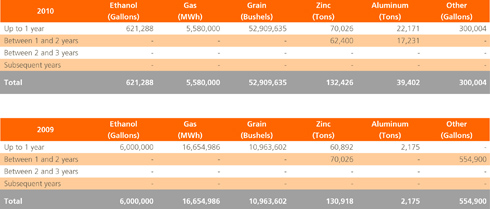
The table below shows a breakdown of the maturities of the fair value of commodity price derivatives designated as cash flow hedges at the 2010 and 2009 year end:
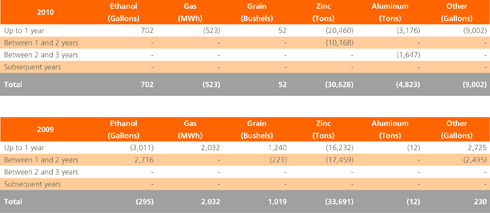
The net amount of the fair value of commodity price derivatives designated as cash flow hedges transferred to the Income statement in 2010 and 2009 has been of €-10,361 and €-11,814 thousand respectively (see Note 24)
The after-tax gains/losses accumulated in equity in connection with derivatives designated as cash flow hedges at December 31, 2010 amounted to €-5,747thousand (€-17,941thousand in 2009). See note 24.
b) Fair value hedges
At the end of 2010 and 2009, the Group does not hold fair value hedging financial instruments of commodity prices.
c) Derivatives not designated as hedges (non-hedge accounting derivative financial instruments)
The table below shows a detail of the maturity of notional amounts of non-hedge accounting commodity price derivatives at the close of 2010 and 2009:

The table below shows a detail of the maturity of fair values of commodity price derivatives not designated as hedge accounting as at the close of 2010 and 2009:

At the 2009 year ends, the amounts of the fair value of commodity price derivatives recognized directly in the Income Statement as a result of not meeting all the requirements of IAS 39 to be designated as hedge accounting represented losses of €-13,219 thousand, respectively (see note 36).
-
Note 12.- Clients and Other Receivable Accounts
12.1. The breakdown of Clients and Other Receivable Accounts as of December 31, 2010 and 2009 is as follows:
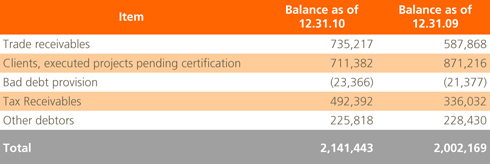
At the close of 2010 and the 2009 s there were no existing balances with related parties (see Note 41.2).
12.2. The fair value of Clients and Other Receivable Accounts does not differ significantly from its carrying value.
12.3. Clients and Other Receivable Accounts denominated in foreign currency amounts to €110,002 thousand as of December 31, 2010 (€87,657 thousand as of December 31, 2009).
12.4. The following table shows the maturity detail of trade receivables as of December 31, 2010 and 2009:
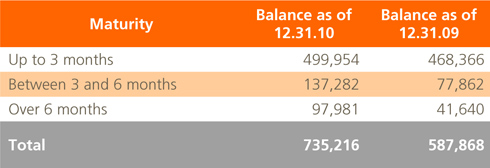
12.5. The credit quality of outstanding Trade receivables, that are neither past due nor impaired, may be assessed under the following categories:

12.6. The movement in the bad debt provision for 2010 and 2009 is the following:

The most significant variations is the recognition of a bad debt provision in the Engineering and Constructions business segment for receivables that are not considered recoverable.
12.7. At the close of the 2010 financial year, approximately €568 million (€521million in 2009) were factored and derecognized pursuant to the provisions of IAS 39. Of this amount, €35 million correspond to entities with non-recourse financing.
12.8. The breakdown of Tax receivables as of December 31, 2010 and 2009 is as follows:

12.9. The following table shows a breakdown of Financial accounts receivable as of December 31, 2010 and 2009:
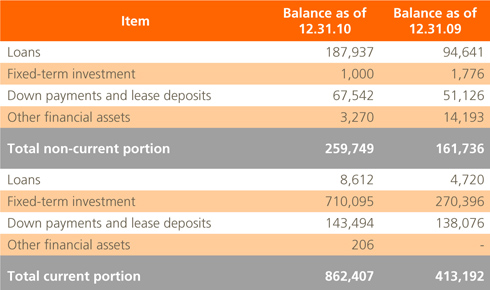
This heading includes the loans and other accounts receivable considered as non-derivative financial assets not listed in an active market, with a maturity period of less than twelve months (current assets) or exceeding that period (non-current assets).
The market value of these assets does not differ significantly from its carrying amount.
As of December 31, 2010 the amount corresponding to entities with non-recourse financing is €736 million (€488 million in 2009).
Fixed-term investments are invested in financial entities with a high credit quality as stated in Note 9.1.
Loans for an amount of €197 million in 2010 (€79 million in 2009), mainly includes note receivables with third parties and local administrations for a total amount of €98 million (€51million in 2009), and includes certain loans to group companies associates and other related parties, not eliminated in consolidation for a total amount of €84 million (€36 million in 2009).
Fixed-term investments for an amount of €711million (€271 million in 2009) mainly includes primarily restricted investments in fixed-income securities and bank deposits with a maturity greater than 3 months that are held as cash collateral for confirming financing. These investments are held with financial institutions and receive floating interest. Said item also contains deposits in the amount of €262 million as guarantee for confirming operations undertaken between companies of the group.
Deposits mainly includes bank deposits with maturity periods generally over a year (non current) and under 3 months (current) in the amount of €143 M (€138 M in 2009). Guarantee deposits consist mainly of balances to cover performance guarantees of debt payments and stood for an amount of €61 million.
Other financial assets include other receivable amounts considered as non-derivative financial assets not listed in an active market, that are not classified in any of the other categories.
-
Note 13.- Cash and Cash Equivalents
As of December 31, 2010 and 2009 Cash and cash equivalents totaled €2,983,155 thousand (€ 1,546,431 thousand in 2009), being cash and credit balances to the Group which are liquid, held in current accounts and immediately available for withdrawal from banks and credit institutions.
The following breakdown shows the main currencies in which cash and cash equivalent balances are denominated:
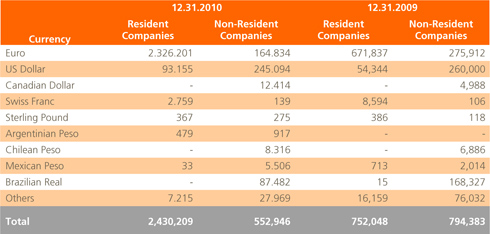
The balance of cash and cash equivalents of entities with non-recourse financing (see Note 15) was €565,893 thousand (€402,780 thousand in 2009).
-
Note 14.- Non-Current Assets and Liabilities of Disposal Group classified as Held for Sale
At the close of 2010, the group did not have any non-current assets or liabilities classified as held for sale, in accordancewith the requirements set forth in IFRS 5.
During the year 2009 the discontinuation of the assets and liabilities of the Information Technologies business segment, previously classified as assets held for sale at the close of the year 2008, ceased due to circumstances previously deemed improbable and, as a result, the conclusion of the sale process and loss of control of the shares of Telvent GIT S.A. was not expected at the end of the forecasted period.
Due to the aforementioned circumstances, the group opted for a partial reduction in the percentage of the shares in Telvent GIT S.A. of 22.79% during 2009. After such sale Abengoa holds 40% of Telvent and still controls it through de facto control (see Note 2.2.a).
-
Note 15.- Non-Recourse Financing
As indicated in Note 2.4, in the consolidation there are certain entities for which, in general, the main commercial purpose is the long-term development of integrated products which are financed through non-recourse project finance.
This Note outlines the non-recourse financing linked to the assets of companies included in Note 6 of this Consolidated Report.
Non-recourse financing is generally used for constructing and/or acquiring an asset, exclusively using as guarantee the assets and cash flows of the company or group of companies carrying out the activities financed. In most of the cases, the assets and/or contracts are set up as guarantee to ensure the repayment of the finance.
Compared to corporate financing, non-recourse financing holds certain key advantages amongst which it can be highlighted the greater leverage period permitted and a clearly defined risk profile.
15.1. The balances and movement for 2010 and 2009 of project finance are set out in the table below:

The most significant variations occurring in the 2010 financial year are mainly in the increase of new financing for specific projects relating to Engineering and Construction (€338 million for energy transmission in Brazil and Peru and projects in Algeria), Solar projects in Spain (€381 million), Bioenergy projects (€81 million for cogeneration projects in Brazil), Moreover, there is an increase of €156 million due to the effect of currency translation from Brazilian Real and US dollar to euro.
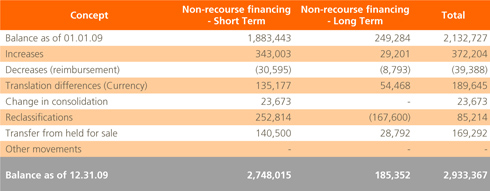
The most significant variations occurring in the 2009 financial year are mainly in the effort to obtain financing for specific projects relating to Environmental Services activity for projects in Algeria (€120 million) and Solar projects in Spain (€249 million). The “Reclassifications” amount generally reflects short term transitional finance that finally become non-recourse project finance of power transmission lines after these lines come into operation.
15.2. The fair value of non-recourse financing is in line with the book value, given that the impact of discounting is insignificant.
Within the assets on the Statement of Financial Position and under the Cash and Cash equivalent and Financial Receivables (Current) headings, there are debt service reserve accounts in the amount of €20 M relating to project finance in 2010 (€18 M in 2009).
15.3. Project companies as of the end of 2010 which are financed by non-recourse project finance are:
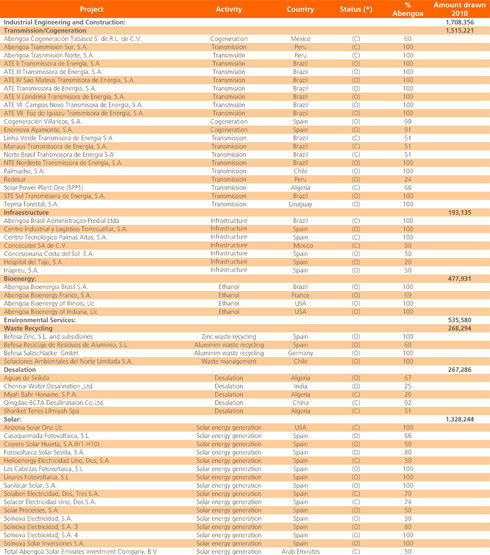
(*) Operative (O); Construction (C)
15.4. The anticipated repayment schedule for non-recourse project financing, at the end of 2010 that will be made with the projected cash flows of the related projects, is as follows.

Included within the amounts repayable there are balances relating to operations financed through non-recourse transitional loans (see Note 15.6) which will be repaid upon granting long-term non-recourse project financing.
15.5. Non-recourse financing projects entered into in 2010 and 2009 is as follows:

15.6. Non-recourse project finance applied to projects also includes Non-Recourse Finance in Process. This relates to certain operations which are financed in a similar manner to non-recourse projects, generally by financial entities, and which are earmarked to be future development projects which typically will eventually be financed
through non-recourse project finance. Receiving finance in process is in effect similar to receiving traditional customer prepayments during various early phases of construction or of a project; Non-Recourse Finance in Process varies slightly from traditional prepayments, however, in that it is not received from customers but from a financial entity. Such funding typically relates to transitional financing phases of a project (typically periods of less than 2 years) during the launch and construction phase of goods/projects which once completed and ready for operation become financed under the non-recourse project finance model (See Note 2.4).However, if during the transitory period there is a risk of non-compliance with the debt repayment schedule necessary for the formalization of Project Finance (or of construction, which will ultimately require financing), this would be reclassified to elsewhere on the Statement of Financial Position, depending upon the nature of
the arrangement, typically being Loans with Financial Entities.The table below lists projects with non-recourse financing in progress as of December 31, 2010(amount in thousands of euros):
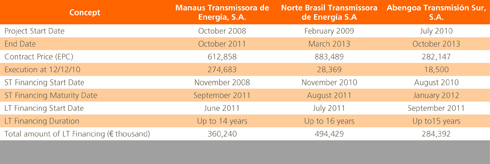
15.7. The amount of the loans with current and non-current credit entities includes debts in foreign currencies in theamount of €2,281,917 thousands (€1,568,271 thousands in 2009), all of which are those of companies residentabroad.
The equivalent in euros of the most significative foreign-currency-denominated debts held by the Group is as
follows:
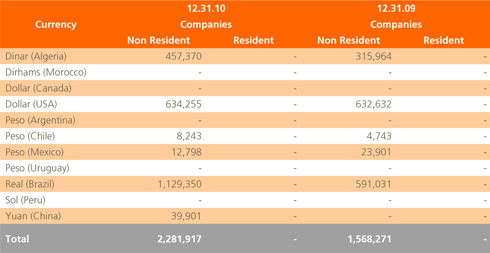
-
Note 16.- Corporate Financing
16.1. The breakdown of the corporate financing as of December 31, 2010 and 2009 is as follows:
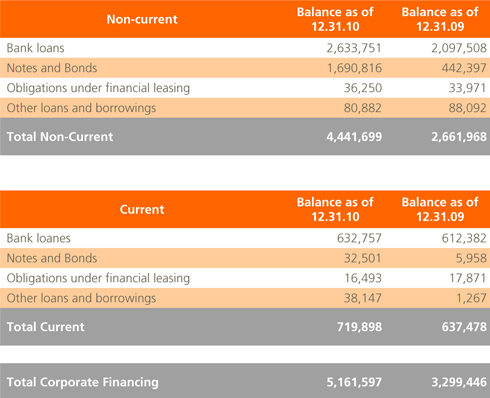
16.2. Bank loans
a) The amount of current and non-current borrowings with financial entities includes debts denominated in foreign currencies in the amount of €117,121 thousand out of which, €117,121 thousand correspond to nonresident companies (€111.248 thousands in 2009). In 2009 €8,538 thousandare for companies which are resident in Spain.
The most significant value of exchange for currencies of debts in foreign currencies owed by companies of
the Group to financial entities is as follows: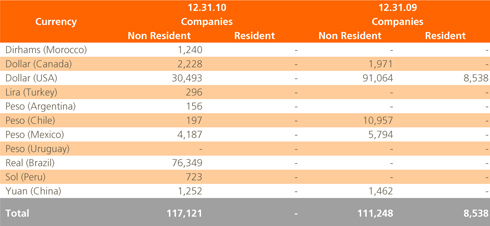
b) The following table shows a list of borrowings with financial entities:
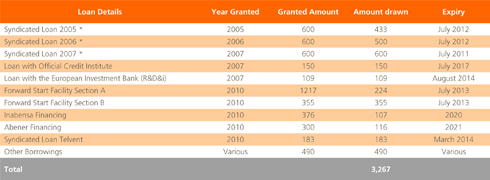
* Extendidos con la Forward Star Facility
With the aim of minimizing the volatility in interest rates of financial operations, specific contracts are signed to hedge the possible variations that may occur (See Note 11).
The long-term syndicated financing loans are raised for the purposes of financing investments and general financing requirements of Abengoa, S.A.and all the companies of the group without non-recourse financing. The syndicated loans for the years 2005, 2006 and 2007 were structured ad line of credit available to the group for 2005 and 2006 and under a multi-currency credit line for 2007 and were financed by over 50 financial entities. The necessary individual guarantees have been provided by certain entities of the Industrial Engineering and Construction, Environmental Services and Bioenergy Business units.
On April 22, 2010, Abengoa, S.A. refinanced part of its syndicated loans from previous years by signing a new agreement with a syndicate comprised of 49 Spanish and international credit institutions, in the form of a “forward start facility” with guarantee from fifteen of its subsidiaries. The amount of the loan called Section A was €1,216,584 thousand and was divided into three sub-Section A-1, A-2 and A-3, which partially extend the maturities of the syndicated loans from 2005, 2006 and 2007 respectively.
Furthermore, on the same date, Abengoa, S.A. signed an additional Section of funding worth €354,597 thousand called Section B, which will be used to cover the general corporate financing requirements and will mature between July 20, 2012 and July 20, 2013. The agreed interest rate and the guarantees are the same as those in the previously described refinancing.
The new conditions of the refinancing extend the maturities to July 20, 2012 and July 20, 2013. The agreed interest rate until July 20, 2012 and 2013 is Euribor plus 2,75% and 3% respectively.
Financing contracts of Abengoa S.A. and those of Abener and Inabensa, which are backed by guarantee of Abengoa S.A., including a corporate financial Net Debt/corporate Ebitda ratio as a performance condition. The Net Debt is calculated excluding debt amounts registered in the non-recourse financing and the ebitda excluding the ebitda generated by companies linked to non-recourse financing.
The maximum limit of this ratio for the financing contracts for 2010 and subsequent years is 3,0. On December 31, 2010, this ratio complied with the conditions stipulated in the respective financing agreements.
Financing contracts of Abengoa S.A. and those of Abener and Inabensa, which are backed by guarantee of Abengoa S.A., including a corporate financial Net Debt/corporate Ebitda ratio as a performance condition. The Net Debt is calculated excluding debt amounts registered in the non-recourse financing and the ebitda excluding the ebitda generated by companies linked to non-recourse financing.
The bilateral loans with the Official Credit Institute (ICO) and the European Investment Bank (EIB) areaimed at financing specific investment programs, more notably overseas programs, as well as R&D&i programs.
At the close of the 2010 financial year, Abengoa, S.A. has available a total of €183,766 thousand (€170,550 thousand in 2009) in short-term borrowing facilities, of which €174,578 thousand is totallyavailable at the end of the period (€162,976 thousand in 2009)These credit lines are intended primarily for financing short-term working capital requirements of the Group, and are managed together with Group’s cash-pooling arrangement (see Note 9 on financial risk management).
In addition, some subsidiaries of Abengoa S.A. undersigned long-term loans with various entities amongst which the following may be highlighted:
- Two financing agreements signed with a group of financing entities backed by an EKN (Swedish Export Credit Agency) guarantee to finance industrial machinery in various projects:
- A credit undersigned in March 2010 by Instalaciones Inabensa S.A. for €247 million, then increased by €129 million in December 2010. These loans, guaranteed by Abengoa S.A. will mature in ten years and the repayment timeframe is tiered. The price agreed upon is Euribor plus an all in cost of 2,85% .
- A credit undersigned in December 2010 by Abener Energía SA worth €300 million, at a cost equal to Euribor plus an all in cost of 2,85% and is tiered credit payable within ten years.
At the close of the financial year the outstanding balance of these loans surpassed €223 million and €453 M remained available.
- Syndicated credits of Telvent GIT taken in 2010 amounting to €183 million structured in two Sections: A credit of up to €100 million and a revolving credit Sections of €70 million which was subsequently increased to €83 million. At the close of the financial year, this financing was entirely drawn. This credit, as well as the rest of the credits incurred by the subsidiaries of Telvent GIT, is not covered by the guarantee of Abengoa S.A .or by any other subsidiary outside the Telvent perimeter.
The fair value of non-current third-party loans is in line with the book value recorded, given that the discounting impact is insignificant.
c) The debt repayment calendar is set out in the following table:

The exposure of the Group to movements in interest rates and the dates at which prices are revised is specified in Note 9 on the management of financial risks. The fair value of the current third-party loans is equal to their book value, given that the discounting impact of is insignificant. The fair value is based on discounted cash flows, applying a discount rate being that of the third-party loan.
d) The balance of interest accrued which has yet to fall due is €15,413 thousand as of 2010 (€1,706 thousand in 2009) and which is included under “Short-term borrowings”.
e) Real estate pledged against mortgages corporate financing as of December 31, 2010 is not significant.
f) The average interest rates associated with the debt facilities reflect normal levels in each of the regions and areas in which the facility was agreed upon.
g) The financing average cost with financial enities during 2010 was 3.84%.
16.3. Notes and bonds
Notes and bonds are expected to be cancelled according to the following schedule:

Convertible bonds 2014
On July 24, 2009, Abengoa, S.A. completed the process of issuing Convertible Bonds to qualified investors and institutions in Europe for the amount of €200million, including the right to exercise the option of increasing by €50 million.
In summary, the final terms and conditions of the issuance are as follows:
a) The Bonds were issued for two hundred million Euros (€200,000,000) with maturity set at five (5) years.
b) The Bonds will accrue a fixed annual interest of 6.875% payable biannually.
c) The Bonds are exchangeable, at the choice of bondholders, for the Company’s existing shares. The bondholders would receive a maximum number of 9,469,697 ordinary shares (equivalent to 10.47% of the Capital Stock) in case they elect to convert the bond and the conversion is settled in ordinary share.
d) Pursuant to the Terms and Conditions, the Company may decide to issue Company shares or give the combination of the nominal cash value with shares for the difference, in the event that investors decide to exercise their right of conversion.
e) The price of the initial exchange of the Bonds (Exchange Price) is twenty-one Euros and twelve cents of a Euro (€21.12) for each share of the Company.
As defined in Note 2.18.1, and pursuant to the terms of IAS 32 and 39, the fair value of the liability component of the convertible bonds as of December 31, 2010 amounts to €168,192 thousand (€187,717 thousand in
2009).In addition, the initial valuation of the component of the liability embedded derivative generated in the issuance of the convertible bonds amounted to €50,461 thousand and at the close of 2009 was valued at €72,911 thousand with an effect in the 2009 Income Statement (see Note 34) for the difference between the two previous values and which amounts to €22,450 thousand. The key data for the model of valuation were the share price, the estimated profitability of the dividend, an envisaged option maturity life, an interest rate and market quota volatility as set out in the table below:
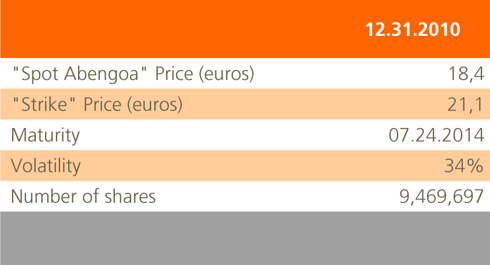
The total number of shares that bondholders shall receive in the event that they decide to convert the bonds into shares amounts to 9,469,697shares.
On the other hand, in order to provide partial coverage for the liabilities of the previous issuance of convertible bonds for the possible exercise of the option of conversion by the bondholders, the company undersigned call options on June 9 and June 21, 2010 respectively on a total of 4,000,000 of its own shares, executable at €21.125 per share set to mature on July 24, 2014.
These options represent a coverage of around 42% of the bonds generated in the event of conversion; the underlying number of shares in the convertible bond are 9,469,697.
The initial valuation at the moment of the signing surpassed €18,020 thousand of Euros, which was the fair value, calculated through the Black-Scholes model, at the close of the financial year €18,041 thousand (see Note 9), with an impact on the outcome account reaching €21 thousand in financial income (see Note 36).
The key data for the valuation model included the share price, the estimated profitability of the dividend, the envisaged life of maturity, an interest rate and market quota volatility as set forth in the table below:
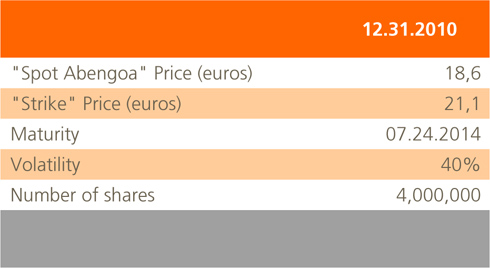
Convertible bonds 2017
On February 3, 2010, Abengoa, S.A. completed the process of issuing Convertible Bonds to qualified investors and institutions for the amount of €250 million.
In summary, the final terms and conditions of the issuance are as follows:
a) The Bonds were issued for two hundred million Euros (€250 million) with maturity set at seven (7) years.
b) The fixed annual payable twice-yearly interest on the Bonds is 8.50% annually. The interest rate of the bonds is set to increase by 1.25% if, by December 1, 2010, they have not received any credit rating from at least two agencies. Since Abengoa SA obtained credit rating from three agencies before the aforementioned date, the payable coupon of the bonds remains at 8.5% until the maturity of the bonds.
c) The bonds are guaranteed jointly by certain subsidiaries of the group.
Pursuant to the Terms and Conditions, the Company may decide to issue Company shares or give the combination of the nominal cash value with shares for the difference, in the event that investors decide to exercise their right of conversion.
d) The price of the initial exchange of the Bonds (Exchange Price) is thirty Euros and twenty seven cents of a Euro (€30.27) for each share of the Company; it represents a conversion premium to 32.5% over the reference price (€22.84).
The total number of shares that bondholders shall receive in the event that they decide to convert the bonds into shares amounts to 8,259,002 shares.
As defined in Note 2.18.1, and pursuant to the terms of IAS 32 and 39, the fair value of the liability component of the convertible bonds as of December 31, 2010 amounts to €164,682 thousand.
In addition, the initial valuation of the component of the liability embedded derivative generated in the issuance of the convertible bonds amounted to €81,570 thousand and at the close of 2010, calculated through Black Scholes model, was valued at €59,385 thousand with an effect in the Income Statement (see Note 8) for the difference between the two previous values and which amounts to €22,185 thousand (see Note 36).
The key data for the valuation model included the share price, the estimated profitability of the dividend, an envisaged option maturity lifevencimiento, an interest rate and a market quota volatility as set forth in the table below:

On the other hand, in order to provide partial coverage for the liabilities of the previous issuance of the convertible bonds for the possible exercise of the conversion option by the bondholders, the company undersigned a call option on July 5 and July 26, 2010 respectively, on the total of 4,000,000 of its own shares, executable at €30.270 per share, set to mature on February 3, 2017.
These options represent a coverage of around 48% of the bonds generated in the event of conversion; the underlying number of shares in the convertible bond are 8,259,002.
The initial valuation at the moment of the signing surpassed €25,376 thousands, which was the fair value at the close of the financial year €23,659 thousands (see Note 9), with an impact on the outcome account reaching €1,717 thousands in financial expenses (see Note 36).
The key data for the valuation model included the share price, the estimated profitability of the dividendan envisaged option maturity life, an interest rate and market quota volatility as set forth in the table below:
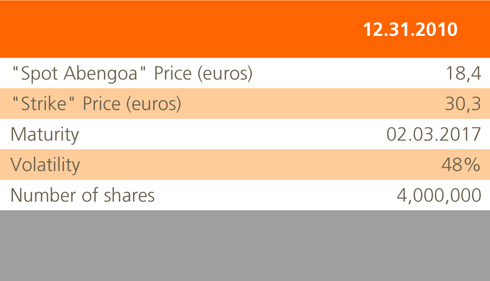
Convertible bonds Telvent 2015
On April 19, 2010, Telvent GIT, S.A., completed the process of issuing Convertible Bonds to qualified investors and institutions for the amount of US$ 200 million, including the right to exercise the option of increasing by US$ 25 million, according to the Securities Act of 1933 and its subsequent modifications.
In summary, the final terms and conditions of the issuance are as follows:
a) The Bonds were issued for two hundred million Euros (US$ 200,000,000) with maturity set at five (5) years.
b) The Bonds will accrue a fixed annual interest of 5.5% payable six-monthly.
c) The Bonds are exchangeable, at the choice of bondholders, for the Telvent GIT, S.A.’s existing shares. Pursuant to the Terms and Conditions, the Company may decide to issue Company shares or give the combination of the nominal cash value with shares for the difference, in the event that investors decide to exercise their right of conversion.
d) The price of the initial exchange of the Bonds (Exchange Price) is thirty US dolars and eighteen cents of a US dolar (US$ 34.18) for each share of the Company; it represents a conversion premium to 22.5% over the reference price (US$ 27.9).
As defined in Note 2.18.1, and pursuant to the terms of IAS 32 and 39, the fair value of the liability component of the convertible bonds as of December 31, 2010 amounts to US$138,342 (€103,534 thousand).
In addition, the initial valuation of the component of the liability embedded derivative generated in the issuance of the convertible bonds amounted to US$60,571 (€44,861 thousand) and at the close of 2010, calculated through Black Schole model, was valued at US$ 34,102 (€25,522 thousand) with an effect in the Income Statement (see Note 34) for the difference between the two previous values and which amounts to US$ 26,469 (€19,339 thousand).
The key data for the valuation model included the share price, the estimated profitability of the dividend, the envisaged life of 5 of the option, an interest rate and market quota volatility as set forth in the table below:
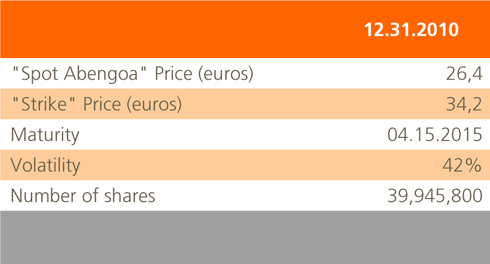
Ordinary bonds Abengoa 2015
On December 1, 2009, Abengoa S.A. completed the process of issuing ordinary Bonds for the amount of €300 million, with maturity set at five (5) years. These Bonds will accrue a fixed annual interest of 9.625% payable six-monthly.
The interest rate of the bonds is set to increase by 1.25% if, by December 1, 2010, they have not received any credit rating from at least two agencies. Since Abengoa S.A. obtained credit rating from three agencies before the aforementioned date, the payable coupon of the bonds remains at 9.625% until the maturity of the bonds.
Said bonds are jointly guaranteed by some subsidiaries of the group.
Ordinary bonds Abengoa 2016
On March 31, 2010, Abengoa S.A. completed the process of issuing ordinary Bonds to qualified investors and ninstitutions in Europe for the amount of €500 million.
In summary, the final terms and conditions of the issuance are as follows:
a) The Bonds were issued for three hundred million Euros (€500,000,000) with maturity set at six (6) years.
b) The fixed annual payable twice-yearly interest on the Bonds is 8.50% annually. The interest rate of the bonds is set to increase by 1.25% if, by December 1, 2010, they have not received any credit rating from at least two agencies. Since Abengoa SA obtained credit rating from three agencies before the aforementioned date, the payable coupon of the bonds remains at 8.5% until the maturity of the bonds.
c) The bonds are guaranteed jointly by certain subsidiaries of the group.
Ordinary bonds Abengoa 2017
On October 19, 2010, Abengoa Finance, S.A. Unipersonal, a subsidiary of Abengoa, S.A., completed the process of placing a ordinary bond issue for 650 million USD among qualified and institutional investors in accordance with Rule 144A of the Securities Act of 1933 and subsequent amendments thereto.
In summary, the terms and conditions of issue that were established definitively are:
a) The bond issue is for an amount of six hundred and fifty milion United States dollars and matures at seven (7) years.
b) The bonds will accrue fixed annual interest of 8.875%, payable every six months.
c) The bonds are jointly and severally guaranteed by Abengoa, S.A. and certain group subsidiaries.
16.4. Obligation under financial leasing
Finance lease creditors as of the end of 2010 and 2009 were:
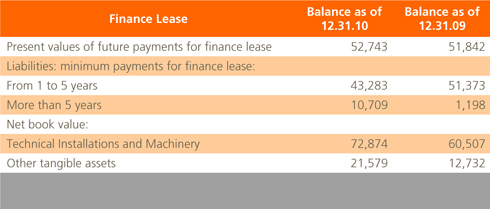
16.5. Other loans and borrowings
“Other loans and borrowings” includes Sale and Lease back arrangements entered into by a subsidiary of Abengoa Bioenergy Corporation for €20,418 M at the close of the 2010 financial year.
In accordance with the accounting treatment adopted, and despite compliance with the mathematical requirements of comparable standards, as well as criteria in relation to negotiations with the financial entities, and in spite of having transferred 100% of the assets at these facilities, the assets in question remain within fixed assets on the consolidated Statement of Financial Position at their net book value.
While, the operation was undertaken through the ABC subsidiary for operating purposes, from a consolidated Group perspective the transactions imply the transfer of the asset and a commitment to make regular payments over a set period of time. In this sense, Abengoa is committed to future rental payments over the next years, so as to continue operations within these premises, as well as ensuring the maintenance of the plants in good operational condition and remaining as the plant operator should the purchase option not be exercised.
The entity has the option, under no obligation to exercise the option, to repurchase the facilities during a fixed period or at the end of the term at market price. If ABC or the Abengoa Group decides not to exercise the option, the Group is obliged to comply with a solution by the lesser in which the latter is able to dispose of or transfer the assets to third parties or another form of management.
Management considers that not classifying these leases as financial would show an accurate image of thefinancial position of the company and the consolidated group, taking into consideration its business strategy, the reasoning used in the transaction by the financial institutions and especially the lack of commitments by the
company to exercise the purchasing option of the assets and the fact that it cannot be presumed according to the operation conditions that there are no reasonable doubts of whether the said operation will be exercised.Also classified under “Other External Resources” are long- and short-term amounts payable to official entities (the Ministry of Industry and Energy, among others) relating to the repayment of no-interest loans and grants provided for R&D projects. At the end of 2010 such balances amounted to €13,967 thousand (€13,531 thousand in 2009).
- Two financing agreements signed with a group of financing entities backed by an EKN (Swedish Export Credit Agency) guarantee to finance industrial machinery in various projects:
-
Note 17.- Grants and Other Liabilities
Grants and Other Liabilities as of December 31, 2010 and 2009 are shown in the following table:
Balances as of 12.31.10
-
Note 18.- Trade Payables and Other Current Liabilities
18.1. Trade Payable and Other Current Liabilities as of the close of 2010 and 2009 are shown in the following table:
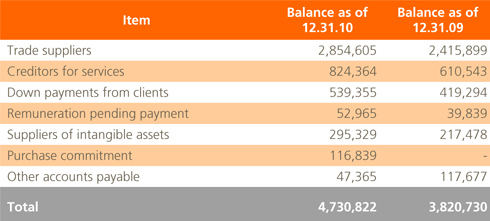
18.2. The There is no significant effect on the fair values of Trade Payables and Other Current Liabilities. Nominal values are considered to approximate fair values and the effect of discounting them is not significant.
18.3. The table above includes amounts payable of €651 million at December 31, 2010 (€563 million in 2009) being “Confirming without recourse” relating to various such agreements entered into with a number of financial entities in which the Group receives “confirming” services to thereby bring forward the timing of cash receipts from receivables. There are deposit guarantees for an amount of €262 million (€225 million in 2009) over said amount itemized under the “Financial accounts receivable” heading of the Statement of Financial Position.
18.4. Details on supplier maturities are provided in the following table:

18.5. In accordance with the Resolution of the Instituto de Contabilidad y Auditoría de Cuentas of December 29,2010 on the information to be included in the annual financial statements in relation to delays in payments to suppliers in commercial transactions, companies located in Spain that formulate individual and consolidated financial statements must expressly publish the information on payment terms to their suppliers in the notes to their annual financial statements.
The duty of information affects commercial payment operations. That is, to the trade payables included under the heading of current liabilities of the balance sheets, therefore, the rule leaves out of its target field of application those creditors or suppliers that do not satisfy this condition, such as suppliers of fixed assets or finance lease creditors.
In the first year to which this Resolution is applicable, the companies must disclose solely information on the amount of the outstanding balance payable to the suppliers that, at the year end, accumulates a delay that is longer than the legal payment period. Additionally, in the financial statements for the first year, comparative information on this new obligation is not presented.
The information in the consolidated financial statements refers to suppliers of the Group as a single reporting entity, after reciprocal credits and debits of subsidiaries and, if applicable, those of multi-group companies have been eliminated in accordance with the provisions of the applicable consolidation rules, together with those of
suppliers related with the construction of own assets.
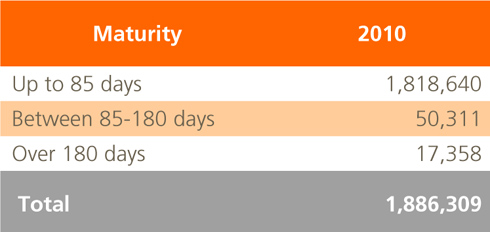
According to the foregoing, taking into account the fact that, in general, the payment system used by Abengoa is the financial format of confirmed payment through financial institutions under contracts signed with several financial institutions, at the end of the 2010 reporting period, the outstanding balances payable to suppliers do not accumulatea payment delay longer than the legal payment term.
18.6. The heading Purchase commitment corresponds entirely to the deferred payment of the acquisition of the remaining 49% shares of the companies NTE and STE (see Note 2.2.a).
-
Note 19.- Provisions and Contingencies.
19.1. Provisions for other liabilities and charges
The following table shows the movement of the non-current heading of “Provisions for Other Liabilities and Expenses” for the years 2010 and 2009:
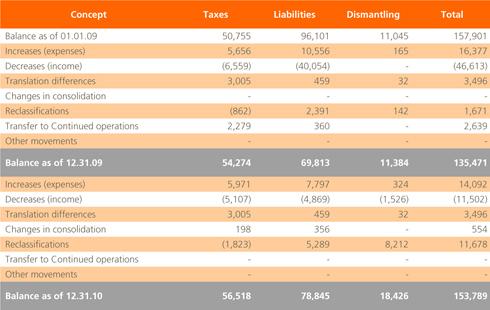
The most significant variations occurring in the 2010 financial year is mainly for the increase as result of obtaining an amount of €14 Million during the financial year with the aim of providing the hedgings necessary for tax risks, liabilities and main dismantlings relating to Industrial Engineering and Construction activities, Bioenergy and Environmental Services respectively and for the decrease caused by the reverting of reserves amounting to €12 Million provided in previous financial years since its reverting was advisable given current classification as remote contingent liabilities or since the risk for which it was set up had materialized.
The most significant variations occurring in the 2009 financial year are mainly for the increase as result of obtaining an amount of €16 Million during the financial year with the aim of providing the hedgings necessary for tax risks and liabilities mainly relating to Industrial Engineering and Construction activities, Bioenergy and Environmental Services respectively and for the decrease caused by the reverting of reserves amounting to €47 Million provided in previous financial years since its reverting was advisable given current classification as remote contingent liabilities or since the risk for which it was set up had materialized.
Provision for tax and legal contingencies
This provision represents the Group’s best estimates in connection with risks relating to tax contingencies arising during the normal course of the Group's business, fundamentally in Latin America, when it is considered probable that there will be an outflow of resources in the medium or long term (which has been estimated
being comprised in a period between 2 to 5 years or over 5 years), although the development of thecontingencies and the new facts and circumstances that may arise overtime could change such estimated settlement period.There are also provisions recorded by Group companies in relation with court rulings and unfavorable tax inspections that are under appeal but have not be resolved, yet. For these tax disputes the Group considers that it is probable that there will be an outflow of resources in the medium term (between 2 and 5 years).
Provision for liabilities
This provision includes the Group’s best estimates of probable cash outflows in connection with litigation, arbitration and claims in progress in which the various group companies are defendants as a result of the activities they carry out. Management considers that these liabilities will likely be settled in the medium or long term (which has been estimated being comprised in a period between 2 to 5 years).
Dismantling provision
This provision is intended to cover future expenditures related to the dismantlement of the solar and environmental plants and those expenses deriving from the sealing and closing of waste safety deposits that are operated by several companies in the Environmental Services segment.
19.2. Contingencies
As of December 31, 2010 Abengoa and its Group of companies are involved in certain claims and litigations both against and in their favor. Such matters arise during the Group’s normal course of business and represent the technical and economic claims that the contractual parties tipically invoke.
We have briefly summarized below the most significant of these proceedings:
- In May 2000, Abengoa Puerto Rico S.E., a subsidiary of Abengoa S.A, brought a lawsuit against the Electricity Power Authority (Autoridad de Energı´a Eléctrica, “AEE”) of Puerto Rico and terminated the agreement that both parties had entered into in relation to an EPC project for the construction of an electricity power station in Puerto Rico, in which the AEE was the Principal Contractor. The referred lawsuit contained different claims such as, inter alia, withholding payments, default invoices, loss of future profits damages and several other costs, which tentatively amounted to $40,000,000.
As a reaction to the lawsuit brought by Abengoa Puerto Rico, S.E., the AEE brought a counterclaim based on the agreement against Abengoa Puerto Rico, S.E. and, at the same time, brought an additional lawsuit for the same amount against Abengoa and its insurer, American International Insurance Co. of Puerto Rico. The amount claimed by the AEE is approximately $450,000,000. We believe this litigation will be resolved in the short term and we do not consider it a probable obligation to be recognized as a liability in the financial accounts.
- On June 8, 2010 a former employee in our Information Technologies business brought a suit against the Information Technologies business and certain of its employees before a court in New York alleging the violation by Telvent of provisions of the Sarbanes-Oxley Act. On June 30, 2010 we responded to the suit
and it is currently in the oral hearings phase which could last from six to nine months. - In March 2009, ASA Bioenergy Holding A.G. (“ASA”) filed an arbitration claim before the International Court of Arbitration of the International Chamber of Commerce in New York, United States against Mr. Adriano Gianetti Dedini Ometto and Adriano Ometto Agrícola Ltda. in connection with indemnity claims
for certain breaches by Mr. Adriano Gianetti Dedini Ometto and Adriano Ometto Agrícola Ltda. of a share purchase agreement, dated August 4, 2007 (the “SPA”) relating to the shares of Adriano Ometto Participações Ltda. The claims amount to $22.2 million. A counterclaim has been lodged by Mr. Adriano Gianetti Dedini Ometto and Adriano Ometto Agrícola Ltda. against ASA, Abengoa Bioenergia São Luiz S.A., Abengoa Bioenergia São J João Ltda., Abengoa Bioenergia Santa Fé Ltda. and Abengoa Bioenergia Agrícola Ltda $9.4 M.
In August 2009, ASA filed an arbitration claim before the International Court of Arbitration of the International Chamber of Commerce in New York, United States against Mr. Adriano Gianetti Dedini Ometto and Adriano Ometto Agrı´cola Ltda. In connection with an indemnity claim for certain breaches by Mr. Adriano Gianetti Dedini Ometto and Adriano Ometto Agrícola Ltda. of the SPA. The indemnity claims an aggregate amount of R$207.1 million and $70 million. Such claim was subsequently counterclaimed by Mr. Adriano Gianetti Dedini Ometto and Adriano Ometto Agrícola Ltda. against ASA, Abengoa Bioenergia São o Luiz S.A., Abengoa Bioenergia SãoJoão Ltda., Abengoa Bioenergia Santa Fé Ltda. and Abengoa Bioenergia Agrícola Ltda amounting to US$ 6.7Million and R$14Million.
- Abengoa, S.A. has initiated an arbitration procedure before the CIADI arbitration court in Washington, D.C. against the Mexican State for an alleged breach of the international treaty between Mexico and Spain for the reciprocal protection of investments. The arbitration procedure is in its early stages and concerns the nonrenewal of a license for an industrial waste landfill plant in Mexico. This claim provisionally amounts to $96 million plus interest.Abengoa’s management considers that there is ground to expect a favourable resolution to the interests of the company, which would lead the company to recoup the assets cost and interest on.
-
Note 20.- Third-Party Guarantees and Commitments
20.1. Third-Party Guarantees At the 2010 year-end the overall value of guarantees deposited third parties was €1,225,989 thousand
(€1,150,886 thousand in 2009), relating to guarantees for customers, financial entities, public bodies and other third parties.Additionally, there are guarantees provided amongst certain Group companies related with financingoperations with financial entities (excluding the syndicated loan with Abengoa, S.A. as commented in Note 16) for the amount of €2,783,920 thousand (€2,188,688 thousand in 2009), with €1,486,118 thousand
(€1,334,393 thousand in 2009) relating to operations outside of Spain, being both overseas entities as well as Spanish entities with overseas operations.20.2. Third-Party Commitments
Third-party commitments (in thousands of euros) are set out below:

-
Note 21.- Tax Situation
21.1 Application of rules and tax groups in 2010
Abengoa, S.A. and 280 and 276 consolidated subsidiaries (see Appendixes V and X of these Consolidated Financial Statements) filed income taxes in 2010 and 2009, respectively, following the rules for tax consolidation in Spain under the “Special Regime for Tax Consolidation” Number 2/97. The main consequence of being taxed as a group is that companies do not pay taxes individually but as a consolidated group, whereby the parent company is responsible for the tax obligations of the consolidated subsidiaries.
Telvent GIT, S.A. and 14 and 12 consolidated subsidiaries (See Appendixes V and X of these Consolidated Financial Statements) filed income taxes in 2010 and 2009, respectively, under “Companies taxed under the Special Regime for Tax Consolidation” Number 231/05.
Proyectos de Inversiones Medioambientales, S.L. and 11 consolidated subsidiaries (see Appendixes V and X of these Consolidated Financial Statements) filed taxes in 2010 and 2009 under “Special Regime 13/05/B of the Basque Country for Tax Consolidation”.
Befesa Reciclaje de Residuos de Aluminio, S.L. and other consolidated subsidiary (see Appendix V and X to this Report) filed taxes under “Special Regime of Tax Consolidation of the Biscay Tax Regulation”, Number 01/03/B.
The remaining Spanish and overseas companies that make up the Group file taxes on a stand alone basis under the tax regime of the applicable jurisdiction.
The applicable law for the payment of corporate income tax in the Historic Territory of Biscay is
Provincial Law 3/1996 of June 26, as amended by Provincial Law 6/2007 of 27 March, which is in force,
although various appeals have been filed against it. The Court of Justice of the European Communities ruled, and the High Court of Justice of the Basque Country dismissed several appeals of the Company in December 2008 against the Foral Law. The appeals have been filed at the Supreme Court against the High Court of Justice of the Basque Country decision. At the date of these Consolidated Financial Statements, the appeals against the Foral Law continue to be pending.The Directors of the companies that make up Befesa have calculated the amounts corresponding to this
tax for 2010, and for the years they have open to inspection in accordance with the provincial laws and
regulations in force at the end of each year, and consider that the final outcome of the various legal
proceedings and appeals filed in this respect will not have a significant impact on these Consolidated Financial Statements taken as a whole.In order to calculate the taxable income of the consolidated tax Group and the consolidated entities individually, the accounting profit is adjusted for temporary and permanent differences. At each Income Statement date, a current tax asset or liability is recorded, representing income taxes currently refundable or payable. Deferred income taxes reflect the net tax effects of temporary differences between the carrying amount of assets and liabilities for financial statement and income tax purposes, as determined under enacted tax laws and rates.
Income tax payable is the result of applying the applicable tax rate in force to each tax-paying entity, in accordance with the tax laws in force in the territory and/or country in which the entity is registered. Additionally, tax deductions and credits are available to certain entities, primarily relating to inter-company trades and tax treaties between various countries to prevent double taxation. Certain entities taxed under special regimes may receive given tax breaks and deductions due to the nature of their main commercial activity.
At the date of preparation of these Consolidated Financial Statements,a tax audit of the consolidated tax group is open without having received any tax adjustment proposal. Administrators estimate that although the possible interpretations of existing tax law could indicate additional liabilities as a result of this inspection, they would not significantly affect these Consolidated Financial Statements. This estimation is based on the best available information and circumstances at December 31, 2010 and 2009, being unable to predict with certainty what will be the final outcome of the inspection.
21.2. Deferred tax assets and liabilities
The analysis of deferred tax assets and deferred tax liabilities is as follows:
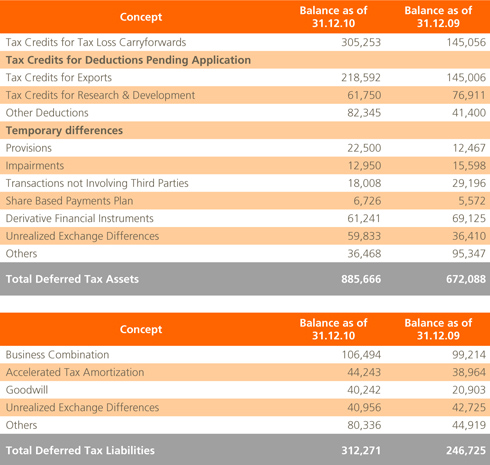
The Company has recognized Spanish government incentives for export activities calculated as a percentage of investments which are effectively made in the acquisition of interest in foreign companies or the incorporation of subsidiaries established abroad. This percentage, which was initially at 25% is being gradually reduced since 2007 to reach 3% in 2010. To benefit from this tax credit, among other requirements, the acquisition or incorporation of companies must be directly related to the export of services and solutions from Spain.
In accordance with the Tax Laws governing Spanish companies on the export deductions (DAEX) because of export-related activities, and after the comprehensive analysis done in previous financial years on documents supporting claims to the right to DAEX deductions, the Group has claimed a 2008 tax deduction of €287 million (for 2008 and prior periods export deductions) resulting in the recognition of a deferred tax asset of €218 million and €145 million in 2010 and 2009 respectively, as the amount probable of recovery.
The DAEX export tax deduction meets the definition of an investment tax credit, which is not specifically in the scope of IAS 12 or IAS 20. Both paragraph 4 of IAS 12 (which considers the accounting treatment of corporate tax), as well as IAS 20 (which considers the accounting treatment of government grants in paragraph 2.b) exclude from their scope the accounting treatment of investment tax credits. IAS 20.19 indicates the possibility that there may exist the concept of a grant in certain tax packages with certain characteristics of “investment tax credits” and recognizes that on occasions it is difficult to distinguish whether the underlying components of an economic transaction are grants.
In order to determine if the DAEX export tax is within the scope of IAS 12 or IAS 20, the Company analyzes each investment on a case-by-case basis to determine if treatment as a government grant under IAS 20 or as a tax under IAS 12 is appropriate. The result is that DAEX export tax deductions are considered government grants under IAS 20 where the deduction is directly fundamental to the decision to make an investment in an asset. In all other cases the DAEX export tax deduction is considered to be to be a tax under the scope of IFRIC 12. This policy of reviewing each investment individually is applied consistently for all export tax deductions under the DAEX program of the Spanish Company Tax Law (LIS).
The movements in deferred tax assets and liabilities during 2010 and 2009 were as follows:
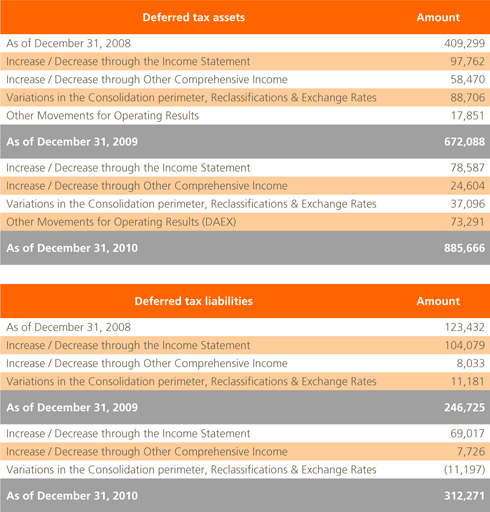
21.3. Income tax
Details regarding income tax at the end of 2010 and 2009 are as follows:
The reconciliation between the theoretical tax expense and the actual tax expense for 2010 and 2009 is set out in the following table:
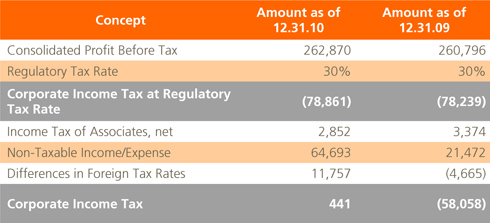
The following may be highlighted in relation to Non-Taxable Income/Expense:
- The effort and dedication to the research and development activities undertaken by Abengoa over recent years have contributed to the generation of important tax deductions and the application of the tax incentive for granting the use of intangible assets as specified in Article 23 of the Revised Text of the Spanish Income Tax Act.
- The increase in the exporting activity undertaken by Abengoa over recent years enhanced the generation of a significant amount both in export-related tax deductions as the generation of income not subject to taxation by applying other tax incentives.
-
Note 22.- Share Capital
As of December 31, 2010 and 2009 the company’s share capital totaled €22,617,420, made up of 90,469,680 ordinary shares of a single class, all with equal voting and economical rights.
All shares are listed on the stock exchanges of Madrid, Barcelona and the Network Stock Exchange System (Sistema de Interconexión Bursátil SIB) (a continuous stock market) since November 29, 1996.
In accordance with notifications received by the company and in compliance with reporting requirements to communicate shareholding percentages and the information received from relevant parties, shareholders with a significant holding as of December 31, 2010 and 2009 are as follows:
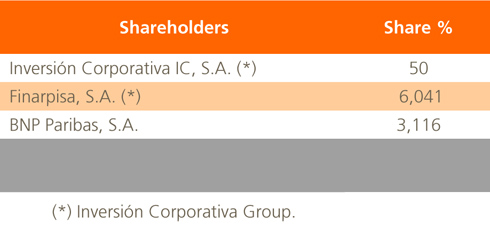
The Abengoa, S.A. Ordinary Shareholders Meeting of April 11, 2010, authorized the Board of Directors to:
1. Increase the share capital, one or more times, up to €11,308,710 Euros, being 50% of the issued shares at the time of authorization, over a period of 5 years.
2. Authorize the issuance of simple or convertible and/or exchangeable bonds, warrants and other negotiable securities, including, where appropriate, the exclusion of preemptive rights. The Board of Directors may use said authorization on one or more occasions for a maximum period of 5 years.
3. Agree to the issuance of other titles which recognize or create debt or increase capital, within the applicable legal limits in each case.
4. Indirectly acquire treasury shares, within legal limits, at a price of between €6 and €60 per share within a period of up to 18 months.
The Extraordinary Shareholders Meeting for Abengoa dated October 16, 2005 authorized the Board of Directors to approve and enter into a Share Purchase Plan for the Executives of the Group (from here on “the Plan”), which includes directors of the business groups, directors of business units, key R&D and technical managers responsible for corporate services. The plan is open to all those executives across all subsidiaries and business groups, present or future, who voluntarily wishes to join the scheme, excluding the Board of Directors of Abengoa. Those participating will have access to a bank loan so as to fund the purchase of Abengoa’s shares at market price, complying with article 81.2 of the Law on Public Limited Companies. The loan, in aggregate, is up to €87 million with a 5-year maturity term. The number of Abengoa’s shares which may be purchased is up to 3,200,000, accounting for 3.53% of the total share capital of the company (see Note 2.20). The Plan was implemented in February 2006.
-
Note 23.- Parent Company Reserves
23.1. The following table shows the amounts and movements of the Parent Company Reserves in 2010 and 2009:
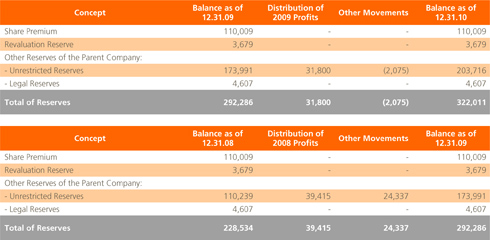
The amount corresponding to “Other Movements” for 2010 and 2009 is part of operations carried out with treasury shares.
The Legal Reserve has been created in accordance with Article 274 of the Law on Public Limited Companies, which states that in all cases an amount of at least 10% of the earnings for the period will be allocated to this reserve until at least 20% of the share capital is achieved and maintained. The Legal Reserve may not be distributed and, if used to compensate losses in the event that there are no other reserves available to do so, it should be replenished from future profits.
23.2. On November 19, 2007, the company entered into an agreement with Santander Investment Bolsa, S.V. (liquidity agreement) for the purpose of backing the liquidity of the transactions with shares, the regularity in trading and the avoidance of variations caused by any factor other than the market trend, without interfering in the normal development of the market and in strict compliance with the Stock Market Regulations. Although said agreement fails to meet the conditions set forth in CNMV Circular 3/2007 of December 19, Abengoa has ensured voluntary compliance with the information requirements of set forth in Circular 3/2007. The CNMV has always been informed of the operations carried out under this agreement on a quarterly basis and these operations have always been published on the company’s website.
As of December 31, 2010 treasury stock under the liquidity agreementamounted to 225,250 shares (145,455 shares in 2009).
Regarding the operations carried out during the year, the number of treasury stock purchased amounted to 10,276,598 shares (14,704,779 shares in 2009) and treasury stock transferred amounted to 10,196,803 shares (16,754,272 shares in 2009), with a gain of €-1,144 thousand recognized in equity (€ 776 thousand in 2009).
23.3. The proposed distribution of 2010 and 2009 profits and other reserves of the Parent Company as approved by the General Shareholders Meetings, is set out in the following table:
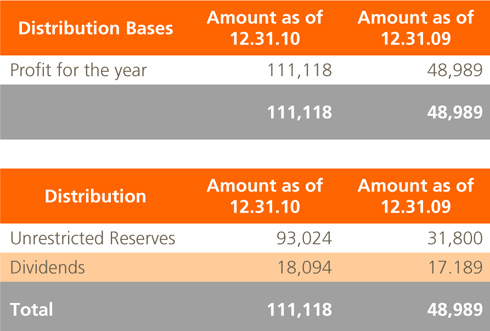
-
Note 24.- Other Reserves
Other Reserves include the impact upon reserves of the valuation of derivative instruments, investments available for sale at the end of the year.
The following table shows the balances and movements of Other Reserves by item for and between 2010 and 2009:
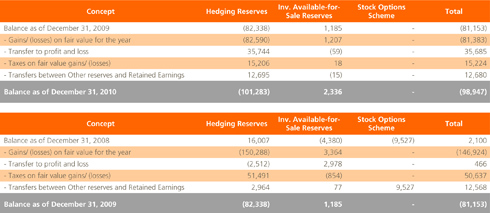
For further information on hedging activities, see Note 11.
-
Nota 25.- Diferencias de Conversión
25.1. The amount of the translation differences for fully and proportionally consolidated companies and associates at the end of 2010 and 2009 is as follows:

25.2. Details regarding translation differences for companies consolidated under the full and proportionate consolidation methods and under the equity method at the close of the 2010 and 2009 fiscal years are as follows:

The balance as of December 31, 2010 has increased/decreased by €232,058 (increase of € 284,552 thousand in 2009), mainly due to the appreciation of the Brazilian real against the euro.
-
Note 26.- Retained Earnings
26.1. The breakdown and movement of Retained Earnings during the 2010 and 2009 fiscal years are as follows:

Amounts included under “Other movements” mainly refer to the acquisition of the percentage remaining shares of the STE Transmissora de Energía, S.A. and NTE Transmissora de Energía, S.A. whose effect has been recorded in equity as set out in IAS 27 revised
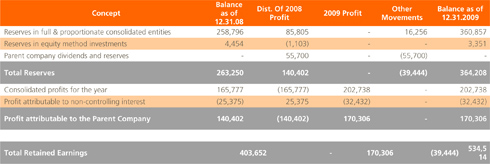
Amounts included under “Other movements” mainly refer to a consolidation adjustment to net equity of the subsidiary AB Brasil for €10 million, the effect of the purchase price allocation of Biocarburantes de Castilla y León for €26 million (see Note 39) and distribution of 2008 Profit to Parent Company reserves and dividends (see Note 23.4).
26.2. The Reserves in full and proportionate consolidated entities and equity method investments are as follows:

-
Note 27.- Non-Controlling Interests
Non-Controlling Interests represent the proportion of Net Reserves of Group entities that are fully consolidated but which are attributable to investors other than the Group with a minority interest in the company.
27.1. Non-controlling interests in 2010 were as follows:
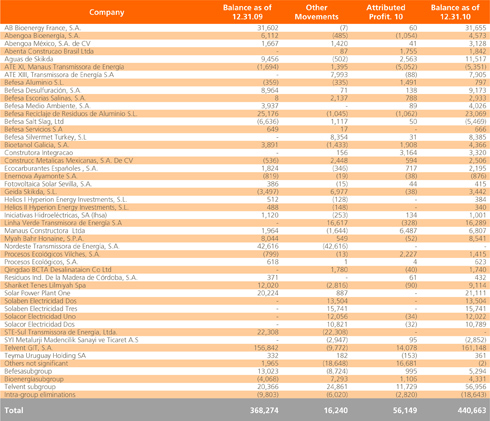
Amounts included under “Other movements” mainly refer to increases due to changes in shareholding interests, due to the entry of minority shareholders in Linha Verde Transmissora de Energía, S.A. Solaben Electricidad Dos and Tres and Solacor of minority shares in Nordeste Transmisora de Energía, S.A. and STE Sur Transmisora de Energía Ltda (see Note 2.2.). Additionally, it includes translation differences for entities with a functional currency other than the Euro for an amount €12 million.
27.2. Non-controlling interests in 2009 were as follows:

27.3. The table below lists the Companies external to the Group which have a shareholding equal to or greater than 10% of a subsidiary of the parent company under consolidation:
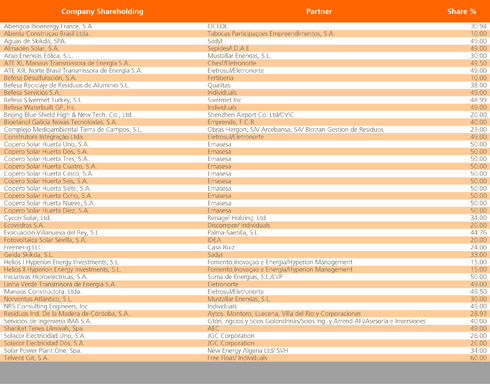
-
Note 28.- Construction Contracts
Further to the information set out in Note 2.25. b) relating to the accounting treatment of construction contracts, the table below includes information on construction contracts and service contracts to which IAS 11 was applied at the end of the year 2010 and 2009:
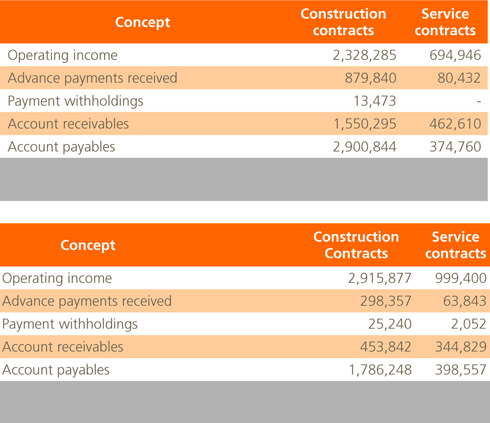
The amount of executed projects pending certificationby the end of financial year 2010 and 2009 is €711,382 and €871,216 thousand, respectively.
-
Note 29.- Revenue
The list of the Net amount epigraph of the business figure at the close of the 2010 and 2009 financial year follows:

-
Note 30.- Other Operating Income
The table below shows the detail of “Other Operating Income” for 2009 and 2010:
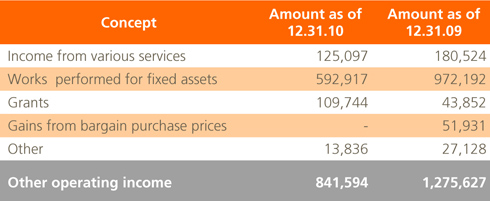
As indicated in Note 21.2, Grants in 2010 and 2009 include income in relation to export activity deductions in cases where it is considered appropriate to apply IAS 20 to these investment tax credits (see Note 21).
Under the caption corresponding to Income from Various Services, items primarily include profits generated by the sale fo Etim and Expansión amounting to €69M (see Note 2.2.b).
The line item Other includes mainly gains from the sale of fixed assets and income from the release of Provisions for other liabilities and charges. During 2009 includes the release of provisions for €18 million in connection with contingencies which were not considered probable during 2009.
-
Note 31.- Employee Benefit Expenses
The breakdown for Employee Benefit Expense is as follows:

-
Note 32.- Research and Development Costs
A detail of these costs by Business Units is as follows:
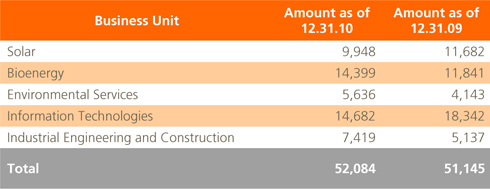
-
Note 33.- Other Operating Expenses
The breakdown of “Other Operating Expenses” is as follows:

“Leases and fees” mainly includes leases of buildings and offices.
Under “Other External Services” are mainly recorded trips and per diem expenses.
-
Note 34.- Finance Income and Expenses
The following table sets forth our Finance Income and Expenses for the years ended December 31, 2010 and 2009:
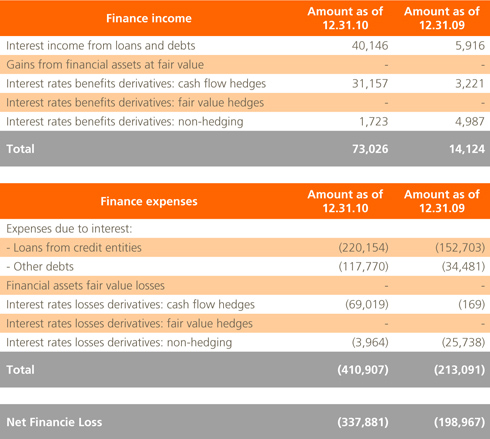
Most significant amounts of this caption for 2010 relate to interest expenses of loans from credit entities (corporate debt and non-recourse financing applied to projects) and income and losses on cash flow hedge interest rate swap/caps contracts (see Note 11.3).
Net financie loss in 2010 for entities with non-recourse financing (see Note 15.3) is €-80,493 thousands.
Most significant amounts of this caption for 2009 relate to interest expenses of loans from credit entities (corporate debt and non-recourse financing applied to projects) and losses on non-hedging interest rate swap/caps contracts (see Note 11.3).
-
Note 35.- Net Exchange Differences
The following table sets out the exchange rate differences in 2010 and 2009:
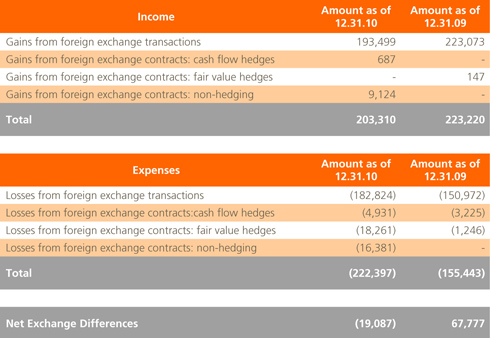
The most significant amounts in net exchange differences during 2010 correspond to the effect of the variation of the US dollar and Brazilian Real exchange rates.
Net exchange rate differences in 2010 for entities with non-recourse financing (see Note 15.3) amounts to €430 thousands.
The most significant amounts in net exchange differences during 2009 correspond to the appreciation of the Brazilian Real.
-
Note 36.- Other Net Finance Income and Expenses
The following table sets out “Other Net Finance Income and Expenses” in 2010 and 2009:
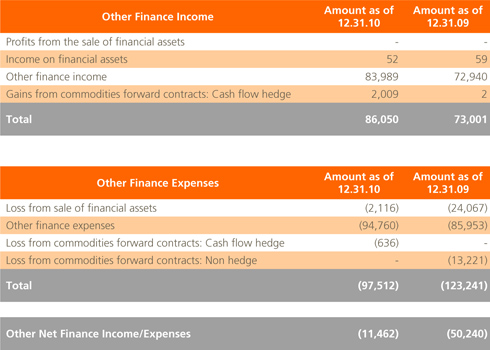
The significant amounts for 2010 primarily correspond to Other finance income for the change in fair value of the embedded derivative of convertible debt (see Note 16.3) and Other finance expenses mainly related to commission expenses and finance expenses on confirming transactions (see Note 18).
Financial Incomes and Expenses in 2010 for entities with non-recourse financing (see Note 15.3) is €-6,407 thousand.
The significant amounts for 2009 are primarily related to Other finance income / expenses due to the cancellation of certain commodities forward contracts as well as a finance expense for the change in fair value of the embedded derivative of convertible debt (see Note 16.3).
-
Note 37.- Earnings Per Share
37.1. Basic earnings per share
Basic earnings per share are calculated by dividing the profit attributable to equity holders of the company by the weighted average number of ordinary shares outstanding during the period.
37.2. Diluted earnings per share
Diluted earnings per share is calculated by dividing the earnings of the Company attributable to the shareholders by the average number of shares outstanding during the period, both adjusted for the effects of all dilutive potential ordinary shares. The only dilutive factors which may affect the earnings of the Company attributable to the shareholders are related with the convertible bond (see Note 16.3).
During 2010 and 2009 diluted earnings per share were higher than basic earnings per share.
-
Note 38.- Dividends per share
Dividends paid in July 2010 and 2009 were €17,147 thousand (€0.19 per share) and €16,246 thousand (€0.18 per share), respectively. In the next Ordinary Shareholders Meeting for the year 2011 a dividend in respect of the year ended December 31, 2010 of €0.20 per share, amounting to a total dividend of €18.094 thousand, is to be proposed. These financial statements do not reflect this proposed dividend.
-
Note 39.- Business combinations
No significant business combination occurred at the close of 2010 having a significant impact on the consolidated figures.
The following table sets out certain information about the business combinations carried out in 2009:

(a) Consideration paid or received
(b) Amount of the consideration in cash or cash equivalents
(c) Amount of cash and cash equivalents in subsidiaries, taking into account the percentage of control obtained.
(d) Amount of assets and liabilities, excluding cash and cash equivalents, subsidiaries, taking into account the percentage of control obtained.
Below is the detail of each of the previous combination of businesses in 2009:- Matchmind
On May 21, 2009, Telvent Outsourcing, S.A, a subsidiary of Telvent GIT, S.A, parent company of the BusinessGroup specialized in Information Technologies, executed an agreement for the acquisition of the remaining 42%of the company called Matchmind held by certain executives of the company and one of its founding members.
The total consideration paid was €18.8 million and the transaction represented the continuation of the originalagreement reached in October 2007 for the acquisition by Abengoa of 58% of Matchmind.Since the acquisition of 42% of Matchmind was originally agreed in October 2007, pursuant to IFRS 3, “Business
Combinations”, the acquisition date for such percentage was set forth on October 31, 2007 for the purpose of determininig goodwill arisen in the business combination.
The original agreements stipulated that Telvent would acquire the remaining 42% in Matchmind in three stages: 12% in 2009, 10% in 2010, and 20% in 2011. The acquisition price for each additional percentage was to be set in accordance with certain financial objectives to be attained by Matchmind in each of the preceding years.
At the time the 2007 financial statements for Abengoa, S.A. and its subsidiaries were prepared, the maximum price payable for the remaining 42% totalled €45,000 thousand, and a long-term liability was recognized, with the consequence of a direct increase in the amount of goodwill at that date.
At the time the 2008 financial statements for Abengoa, S.A. and its subsidiaries were prepared, the Group’s best estimate of the payments to be made for the remaining 42% of Matchmind totaled €32,497 thousand. In order to accelerate the integration of Matchmind into the rest of the Group, negotiations were successfully
completed to acquire the remaining 30% at an earlier time, together with the 12% for 2009, and the final price agreed upon was €18,737 thousand.
Movements in the balance of goodwill arising from the acquisition of Matchmind for the years 2007, 2008, 2009 were as follows: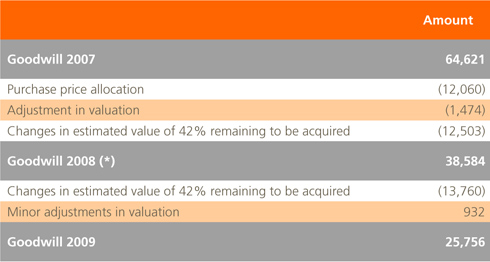
(*) Presented within the non-current held for sale caption
- Hannover, Lünen and Töging Plants On June 2, 2009, the subsidiary MRH Residuos Metálicos, S.L., after creating two subsidiaries in Germany, Befesa
Slazschlacke GmbH and Befesa Slazschlacke Sud, GmbH, acquired, for an amount of €25.5 million, three productive plants located in the German towns of Hannover, Lünen and Töging and specialized in the treatment and recycling of salt slag. These plants are equipped with the latest technology available on the market, and have a
combined treatment capacity of 380,000 tons of waste per year.

The transaction had the result that the fair value of identifiable net assets acquired exceeded the consideration paid by the acquirer for the interest in such net assets, as follows:
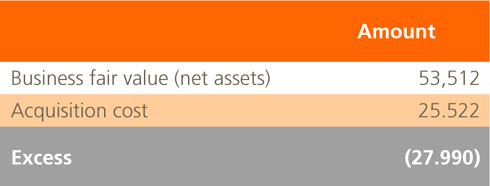
The excess of the fair value of identifiable net assets over the consideration paid was classified under the heading of “Other operating income” in the Income Statement for the year 2009.
The plants acquired were purchased from two German companies pertaining to the same business group that had recently gone into receivership, which explains, among other things, an acquisition price that was notably lower than the carrying value.
Abengoa has calculated the fair value of the acquired business by applying a discounted cash flow model. The assumptions used when calculating the discounted cash flow were based on the knowledge of the salt slag recycling business within the Group, applied in this case to the operating cost structure and the joint capacities of the acquired assets, once controlled and known. The treatment capacities of the plants used in the calculation of the projections were lower than those that are theoretically available (based on estimates of the existing demand), the prices per treated ton used were market prices and the discount rate used to calculate fair value was 7.6%.
In calculating the fair value of the business acquired we employed the most conservative hypotheses and assumptions for estimating the cash flows. Thus, Group Management does not believe there will be negative distortions in future cash flows.
- Biocarburantes de Castilla y León, S.A.
On September 24, 2009, Biocarburantes de Castilla y León, S.A., a company which until then had been consolidated using the method of proportional integration, was consolidated through the full integration method when the remaining 50 percent of the shares held by third parties not connected to the Group were acquired for
an amount of €17millionBiocarburantes de Castilla y León S.A. was created by Abengoa with a 50% stake, for the construction and operation of a two-hundred-million-liter bioethanol plant in Babilafuente (Salamanca), in operation since 2006.
The main impacts on the Statement of Financial Position dated December 31, 2009 are as follows (in thousands of Euros):
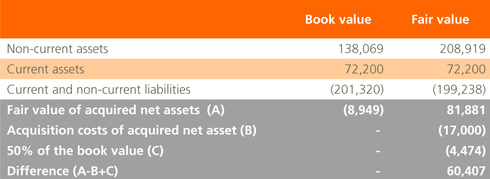
During the allocation of the acquisition price, all factors taken into account when determining the acquisition price have been considered, notably assigning a higher value to the non-current assets associated with the grain-based bioethanol plant and assigning a lower value to certain non-current liabilities associated with the plant, fundamentally relating to government grants that do not have to be repaid.
When determining the reasonable value of the assets pertaining to Biocarburantes Castilla y León, S.A. the market value based on the amortized replacement cost for these assets has been used, which was obtained through a technical and measurement report based on appraisal from third parties.
The results from such appraisal were compared with other valuations based on discounted of cash flows prepared by another third party for the purpose of the allocation of the purchase price. The main assumptions used are listed below:
- Financial projections over 30 years were used, which matches the estimated useful life of the bioethanol production plant and without taking into consideration any residual value as from the final projection period, considering that the value of the assets at that date will match the liabilities that must be assumed to dismantle
the plant,
- As the financial structure of this company is associated with the Group’s global structure, cash flows were discounted using a discount rate based on the weighted average cost of capital (WACC) for this type of asset, adjusted for the specific risk associated with this type of activity.
- According to the above measurement criteria, the discount rate used to calculate fair value was 9.5%. Given that the replacement value obtained was lower than the amount calculated using discounted cash flows,
Given that the replacement value obtained was lower than the amount calculated using discounted cash flows, Abengoa considered the replacement value to be the reasonable value of the assets pertaining to Biocarburantes Castilla y León, S.A.
Abengoa considered the replacement value to be the razonable value of the assets pertaining to Biocarburantes Castilla y León, S.A. The non-current assets, to which a fair value step up of €70.8 million has been assigned, consist of a plant engaged in the production of bioethanol from grain (with an installed production capacity of 200 million liters per year while consuming approximately 500,000 tons of cereal per year) and on a secondary basis of animal feed substances (with a production capacity of 120,000 tons of DGS per year) and of electricity (with a production capacity of approximately 208,000 MWh per year, of which 140,000 MWh are sold to the market and the rest it is for own use).
The tax rate used in connection with the fair value step up of the plant was 30%, in accordance with the tax legislation in force in Spain, and the deferred tax liability that has been recognized with respect to the step up of the assets totals approximately €21 million.
The effect on the Income Statement is a negative goodwill in the amount of €24 million for the excess between the cost of the business combination and the fair value of the net assets and liabilities acquired.
- Matchmind
-
Note 40.- Financial Information by Segment
40.1. Information by business segment
The information by Business Segment is analyzed among the five Business Groups which Abengoa operates (see Note 12). These segments are as follows:
Solar
Bioenergy.
Environmental Services.
Industrial Engineering and Construction.
Information Technology.
Corresponding with the changes in senior management with authority that corresponds to the incorporation of a new CEO during 2010, the Company has reconsidered operating measures and other financial information that the group reports to senior management with CODM responsibility in accordance with the provisions of IFRS 8.
Consequently, the performance measures and other financial information that the CODM has evaluated during 2010 to evaluate the performance of each segment and manage the allocation of resources are reported.
In this regard, management considers the measures of Revenue and EBITDA (Earnings Before Interest, Taxes Depreciation and Amortization) of each segment as the performance measures provided to the CODM in making decisions in managing the group (See Note 1.2).
Although a Non-GAAP financial measure, management considers that EBITDA is also more closely aligned with the performance measurements reported externally and in our debt covenants.
a) The following table lists the details of Sales and EBITDA by Business Segment for the years ending December 31, 2010 and 2009:
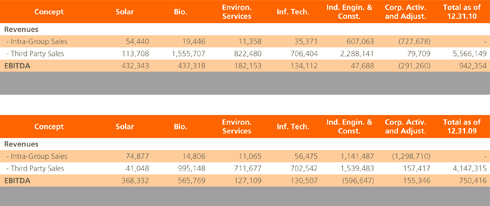
Sales between operation segments are at market prices, therefore, inter-segment sales are eliminated in the “Corporate Activities and Adjustments” column. The external sales reported to the CODM is measured in a manner consistent with the Consolidated Income Statement.
For the 2009 financial year, the gain on sales of shares in Telvent GIT, S.A. are recorded in the Information Technologies business segment (see Note 2.2).
The conciliation of EBITDA with the Profit for the Year attributable to the Parent Company is as follows:

b) The following table shows details on group assets and liabilities by business segment as of December 31, 2010 and 2009:
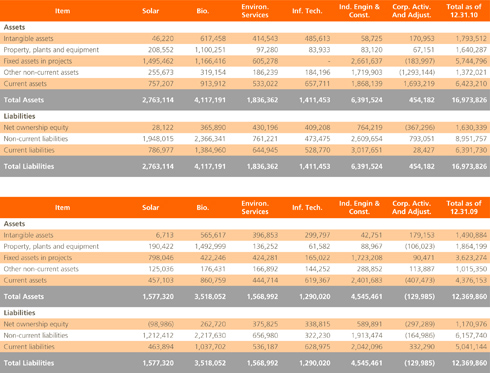
Below are the criteria employed in elaborating the principal magnitudes of the profit and loss account (see Note 40.1.a) as well as the assets and liabilities by business segments (Note 40.1.b) are describe below:
1. The data is categorized by each of the segments on the basis of the usage of the sub-consolidations utilized by the head of each business group.
2. The Corporate Activities and Adjustments column include both Sales, EBITDA y the assets and liabilities for general use, which are not to be spread out among the rest of the activities and which are mainly found in the financial statements of the parent company, like adjustments that occur in the consolidation process mainly related with the elimination of internal operations between business segments.
3. The group also includes auxiliary activities, portfolio companies and agricultural companies that are not significant in size (less than 5%) to be required to present information separately, which is why they are equally included in the column for each Business Unit (Bioenergy and Corporate Activity).
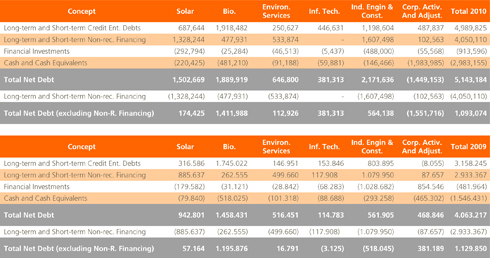
The criteria used to obtain the net debt figures by business segment are described below:
1. The figures have been grouped for each business segment using the subconsolidated statements of each of the primary companies that the Group has for each business.
2. The column Corporate Activity and Adjustments includes both the amounts that are not distributed among the rest of the activities and that are principally on the parent company’s Statement of
Financial Position as adjustments produced in the consolidation process, fundamentally related to eliminating internal transactions between business segments.
3. The Syndicated Corporate Financing of €4,107 million granted to Abengoa, S.A. has been distributed by business group, since the principal objective is to finance investments in projects and in companies that need to expand the Group’s businesses and lines of activity.
4. Financial investments have been included in the calculation as a decrease in net debt, since the items that form said heading are highly liquid.
d) The breakdown at the year end of 2010 and 2009 of the amounts relating to the acquisition or production cost of the assets, amortization or depreciation expenses and impairment charges and the amount of expenses that have not resulted in a cash outflow are as follows:
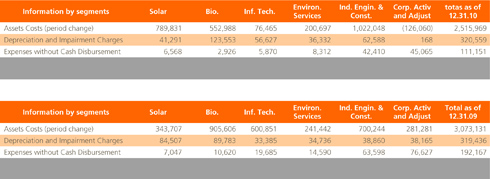
40.2. Additional information by business activity
As stated in Note 1.2, during the third quarter of 2010, Abengoa Management began to present additional
financial information of three business activities in addition to information on the 5 reporting segments.The three business activities identified to present the financial information are the following:
- Industrial Engineering and Construction.
- Service Concession Arrangements
- Industrial Production.
Therefore, in order to make the Group’s financial reporting easier to understand, across detail of the key income statement figures between the five segments and the three business activities is shown below:
a) Detail of sales between the segments and the business activities at the end of the 2010 reporting period

b) Detail of EBITDA between the segments and the business activities at the end of the 2010 reporting period:

40.3. Information by geographical region
a) The following table shows analysis of the net book value of Intangible assets by geographic region as of December 31, 2010 and 2009:

b) The following table shows analysis of the net book value of Property, plant and equipment by geographical region as of December 31, 2010 and 2009:
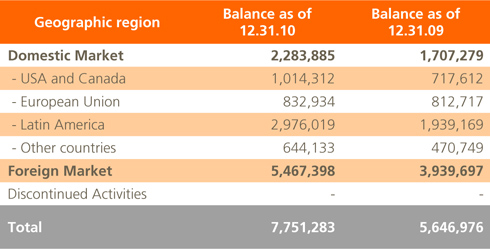
c) The following table shows analysis of the net book value of Intangible assets by geographical region as of December 31, 2010 and 2009:
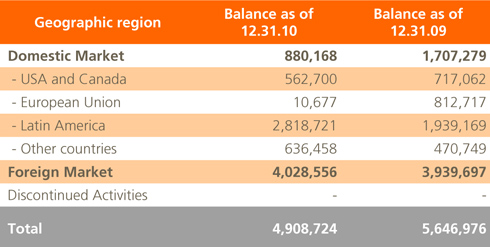
-
Note 41.- Other Information
41.1. Average number of employees
The average number of employees during 2010 and 2009 was:

The average number of employees is based 37% in Spain (41% in 2009) and 63% abroad (59% in 2009).
These figures have been calculated taking into account all the consolidated entities, both on a full and on proportional basis.
41.2. Related parties
The account held by Abengoa with Inversión Corporativa I.C., S.A., as of year-end 2010 and 2009 has a nil balance.
Dividends distributed to related parties during 2010 amounted to €9,344 thousand (€9,059 thousand in 2009)
The account held by Abengoa with Inversión Corporativa I.C., S.A., as of year-end 2010 and 2009 has a nil balance.
Dividends distributed to related parties during 2010 amounted to €9,344 thousand (€9,059 thousand in 2009).
Operations carried out during 2010 and 2009 involving significant shareholders are as follows:
On April 16, 2009 Sanlúcar Solar, S.A., (company that owns the PS10 Solar Plant) issued partialrelinquishment of a right of use of land (a right under Spanish law where an owner of a plot allows another party to use it for a specific purpose –usually to build- and for a limited number of years) totaling 3.04 hectares. The original contract was signed on January 15, 2003 for an initial period of 30 years, on a plot with an area of 69 hectares located on a property owned by Explotaciones Casaquemada, S.A. (subsidiary of Inversión Corporativa, I.C., S.A., main shareholder of Abengoa S.A.) situated in Sanlúcar La Mayor (Seville - Spain), retaining the remainder of such right of use of land.
As a result of such relinquishment, Explotaciones Casaquemada S.A. returned €43,384 to Sanlúcar Solar, S.A., a proportional amount that was calculated based on the price of the contract, for the amount of days remaining for the validity of the right of use of land with respect to the portion of land thereby
relinquished.Furthermore, on April 16, 2009, the company Solar Processes S.A (owner of the PS20 Solar Plant) undersigned a right of use of land agreement over said 3.04 hectares owned by Explotaciones Casaquemada S.A. (subsidiary of Inversión Corporativa, I.C., S.A., main shareholder of Abengoa S.A.). Pursuant to the terms of the agreement, the period for which the right of use of land is constituted is the same as that which is left for the validity of the right of use of land constituted on February 7, 2007 bySolar Processes, S.A. (owner of PS20 solar plant), involving a 30-year period that may be extended to 50 years. The consideration paid to acquire such right amounted to €61,999. As indicated in Note 22, Inversión Corporativa is Abengoa’s main shareholder, and issues its own separate
Consolidated Financial Statements. These operations were subject to verification by the Abengoa Audit Committee and the consideration paid for
the different transactions has been determined by independent third parties.41.3. Employee remuneration and other benefits
Directors are remunerated as established in article 39 of the Articles of Association. The remuneration of Directors is made up of a fixed amount as agreed upon at the general Shareholders meeting, and is not necessarily equal for all directors. Additionally, they may participate in profit sharing programmes, for a percentage between 5% and 10% (maximum) of the net income of the Company after the declaration of the dividends for the year. Travel expenses related to work undertaken by the board are reimbursed to
Directors. Salary (both fixed and variable) and allowances paid to the members of the Board of Abengoa S.A. in 2010 were €8.912 thousand (€8.716 thousand in 2009), as well as €137.995 thousand attributed to other items (€221 thousand in 2009).
Detail on individual salaries and benefits in 2010 and 2009 paid to the Board of Directors is as follows (in thousands of Euros):
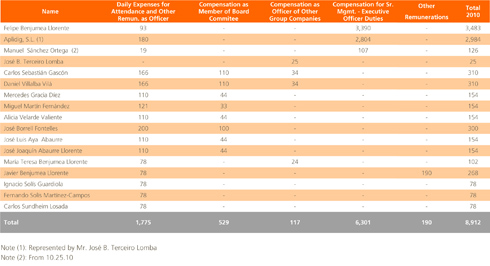
Note (1): Represented by Mr. José B. Terceiro Lomba
Note (2): From 10.25.10
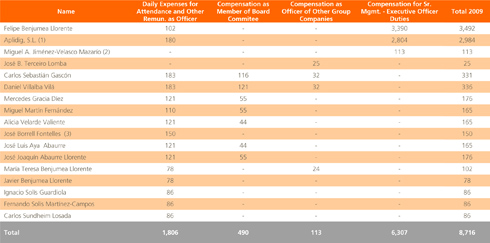
Nota (1): Representada por D. José B. Terceiro
Nota (2): Hasta el 26.07.09
Nota (3): Desde el 27.07.09Additionally, in 2010 overall remuneration for key management of the Company (senior management which are not executive directors), including both fixed and variable components, amounted to €7.216 thousand (€6,883 thousand in 2009).
No advanced payments or credits are granted to members of the Board, nor are any guarantees or obligations granted in their favor.
As of the end of the period there existed €24,629 thousand in non-current personnel compensation obligations (€15,225 thousand in 2009 ).
41.4. With the aim of reinforcing the transparency in Public Limited Companies, with the exception of what is described below, the members of the Board do not own shares in the capital of companies which maintain activities that are analogous, complementary or the same as the ones that constitute the business purpose of the Parent Company since July 19, 2003, which is the date Law 26/2003 entered into fore. Such law, which modifies Law 24/1988 of July 28, governs the Stock market and the Consolidated Text of the Law on Public Limited Companies. Likewise, the members of the Board have not and neither are they engaged in activities which are the same, analogous or complementary to the business purpose of Abengoa, S.A., whether for themselves or for others. On the other hand, during 2010 and 2009 no entity outside the Group qualified for horizontal consolidation, in the terms set forth in Article 42 of the Spanish Corporate Law.
Below is a list of the members of Abengoa, S.A.’s Board which also serve as board members in other Group companies:

Below is a list of Board members having a seat in the board of other listed companies:

In accordance with the record of significant holding in the Company, and as required by the “Internal Rules and Regulations for Conduct involving Stock Exchange Matters”, the shares and the holding percentages of the Company Directors as of December 31, 2010 are:
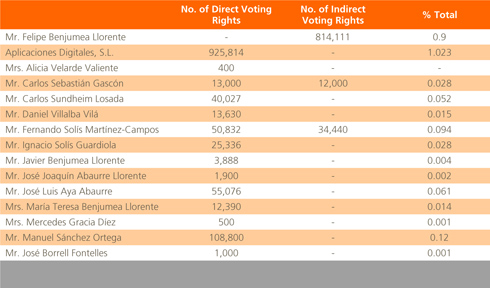
41.5. Audit fees
The audit fees for the year 2010 amounted to €4,985 thousand (€3,670 thousand in 2009) and they were related to financial auditing work including both the year-end audit and the SOX internal control audit, as well as the review of periodical information and the audit under US GAAP for the company listed in the US. Out of the total audit fees, an amount of €3,563 thousand was paid to the principal auditor which is PricewaterhouseCoopers (€2,461 thousand in 2009).
In addition, during the 2010 audit firms were paid €7,158 thousand (€3,655 thousand in 2009) for other works related with financial consulting and verification tasks involving the acquisition of companies. The principal auditor was paid €3,338 thousand (€1,453 thousand in 2009). Said amount includes €1,249 thousands of Euros for complementary services rendered by the principal auditor pursuant to the valid laws.
41.6. Environmental information
The principles of the environmental policies of Abengoa are based on compliance with the current legal regulations applicable, preventing or minimizing damaging or negative environmental consequences, reducing the consumption of energy and natural resources, and achieving ongoing improvement in environmental conduct.
In response to this commitment to the sustainable use of energy and natural resources, Abengoa, in its Management Rules and Guidelines for the entire Group, explicitly establishes the obligation to implement and certify environmental management systems in accordance with the ISO 14001 International Standard.
Consequently, by year-end 2010, the percentage of Companies with Environment Management Systems certified according to the ISO 14001 Standard per sales volume is 86.05%.
The table below lists the percentage of distribution of the Companies with Certified Environmental Management Systems, broken down by Business Units:
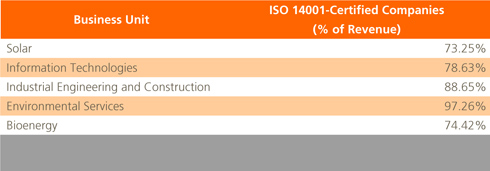
Abengoa considers that its traditional engineering activity represents no more than a valuable tool through which it can construct a more sustainable world, and it applies this philosophy in all its Business Units such that from solar energy, biomass, waste, information technologies and engineering, Abengoa applies technological and innovative solutions for sustainable development.
41.7. Post-balance sheet events
Since the close of the financial year there has been no event that could significantly influence the information reflected in the Annual Accounts prepared by the administrators, or that could stand out because it may have significant impact on the Group.